
FORM 6 - K
SECURITIES AND EXCHANGE COMMISSION
Washington, D.C. 20549
Report of Foreign Private Issuer
Pursuant to Rule 13a - 16 or 15d - 16 of
the Securities Exchange Act of 1934
As of March 22, 2024
TENARIS, S.A.
(Translation of Registrant's name into English)
26, Boulevard Royal, 4th floor
L-2449 Luxembourg
(Address of principal executive offices)
Indicate by check mark whether the registrant files or will file annual reports under cover Form 20-F or 40-F.
Form 20-F _Ö _Form 40-F ___
The attached material is being furnished to the Securities and Exchange Commission pursuant to Rule 13a-16 and Form 6-K under the Securities Exchange Act of 1934, as amended. This report contains Tenaris’s 2023 Sustainability Report.
SIGNATURE
Pursuant to the requirements of the Securities Exchange Act of 1934, the Registrant has duly caused this report to be signed on its behalf by the undersigned, thereunto duly authorized.
Date: March 22, 2024
Tenaris, S.A.
By: /s/ Giovanni Sardagna
Giovanni Sardagna
Investor Relations Officer

1 Sustainability Report 2023


1 02 General Information 04 Who we are 06 Chairman’s Letter 10 Sustainability in Tenaris 12 Stakeholder Engagement & Materiality Analysis 16 Environment 18 Commitment, Objectives & Actions 19 Environment Management System 20 Climate Change 30 Air Quality 31 Circularity and Material Efficiency 34 Water Management 35 Biodiversity 36 EU Taxonomy 42 Social 44 Human Capital 52 Health & Safety 60 Community Relations 66 Innovation & the Value Chain 74 Governance 77 Corporate Governance 78 Risk Management 79 Business Conduct 81 Compensation Policy and Report 82 Compliane Line 82 Shareholder’s Compliance Line 83 Human Rights 84 Annexes 86 Accounting Policies 90 Annex I - GRI Content Index 93 Annex II - SASB Iron & Steel Producers Content Index 94 Annex III - TCFD Content Index 95 Annex IV - Sustainability Performance Indicators 102 Annex V - EU Taxonomy Tables 103 Assurance Report Corporate Information Index
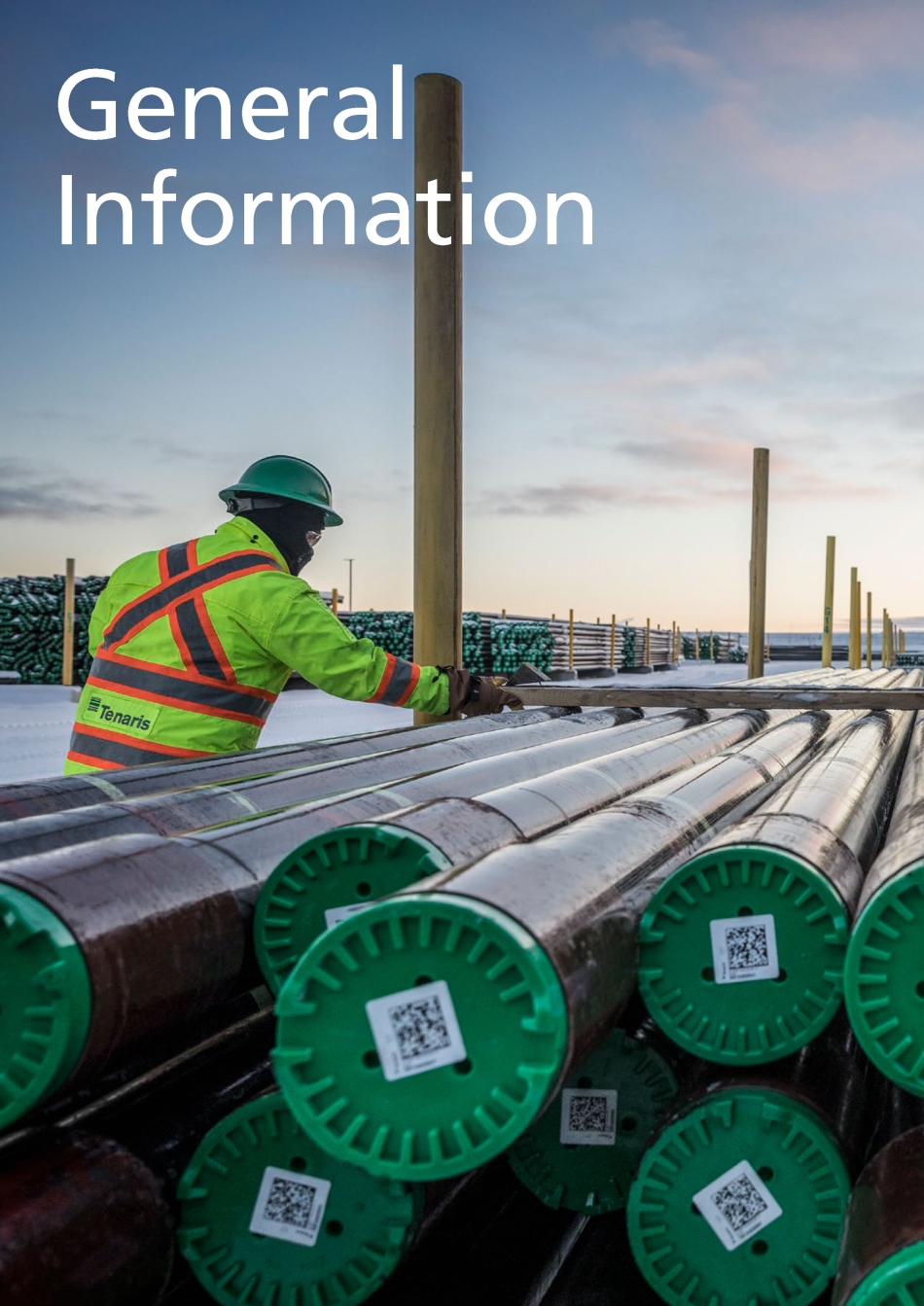
2 General Information

3 Contents Who we are . . . . . . . . . . . . . . . . . . . . . . . . . 4 Chairman's Letter . . . . . . . . . . . . . . . . . . . . 6 Sustainability in Tenaris . . . . . . . . . . . . . . 10 Stakeholder Engagement & Materiality Analisis . . . . . . . . . . . . . . . . 12

4 Who we are 29,000 EMPLOYEES MANAGEMENT SYSTEMS Integrated Quality ISO 9001 Health, Safety and Environment ISO 14001 / ISO 45001 North America 52% SALES BY REGION Asia Pacific, Europe 8% Middle East and Africa 17% South America 23% TOP CUSTOMERS • ADNOC • BP • Chevron • ConocoPhillips • Continental Resources • Diamondback Energy • Energía Argentina • Eni • EOG Resources • ExxonMobil SALES BY MARKET 7% Industrial, Power and Others Oil & Gas 87% Oil & Gas processing plants 6% • Oxy • Pan American Energy • Pemex • Petrobras • Pioneer Natural Resources • Qatar Petroleum • Saudi Aramco • Shell • Tecpetrol • YPF 14.9 B USD 14.9 B USD Calarasi Sault Ste. Marie Tamsa TuboCaribe Machachi Aberdeen Bakersfield Conroe Onne Dalmine Silcotub Campina Batam SPIJ Confab Villa Constitución Siderca Villa Mercedes Valentín Alsina Coating Facilities Bay City Monterrey Baotou Qingdao GPC Dammam Saudi Steel Pipe Wilder Brookfield Koppel Ambridge Nisku Aktau Etihad Tubulars Hickman Baytown Houston Manufacturing Centers R&D Centers Service Centers Commercial/Administrative Offices At December 31, 2023

5 Through an integrated global network of R&D, manufacturing and service facilities, and a team of 29,000 people worldwide, we work with our customers to meet their needs promptly, observing the highest standards of product performance and reliability. Our core values of safety, health, environment, quality and transparency guide our daily activity. They are clearly reflected in our QHSE policy ( www.tenaris.com/en/sustainability ), and our Code of Conduct ( www.tenaris.com/en/sustainability/ governance - and - ethics ), and are integrated into every facet of our business processes. Tenaris is a leading global manufacturer and supplier of steel pipe products and related services for the world’s energy industry and other industrial applications. Our customers include most of the world’s leading oil and gas companies, and we operate an integrated network of steel pipe manufacturing, research, finishing and service facilities with industrial operations in the Americas, Europe, the Middle East, Asia and Africa . Although our operations focus on serving the oil and gas industry, we also supply pipes and tubular components for non - energy applications. We develop and supply products and services for low - carbon energy applications such as geothermal wells, waste - to - energy (bio - energy) power plants, hydrogen storage and transportation, and carbon capture and storage. ECONOMIC VALUE GENERATED USD 15.2 B SUPPLIERS USD 7.4 B RESEARCH & DEVELOPMENT USD 60 M CAPITAL PROVIDERS USD 1.0 B EMPLOYEES USD 2.1 B CAPEX USD 619 M TAXES USD 1.3 B ECONOMIC VALUE GENERATED AND DISTRIBUTED IN 2023 COMMUNITY INVESTMENTS USD 16 M

6

7 2023 has been an outstanding year for Tenaris with record financial results under most metrics: net sales of USD 14.9 billion, EBITDA of USD 4.9 billion, net income of USD 4.0 billion, operating cash flow of USD 4.4 billion. As a global supplier of pipes to the energy industry, we have developed a unique presence in the most challenging developments in the oil and gas industry, serving its most important players. With these results and net cash of USD 3.4 billion in our balance sheet, we are increasing returns to shareholders. We are proposing to increase our annual dividend to 60 cents per share. Together with the share buyback program we initiated in November, this would imply an 8% yield to shareholders for the year at current prices. We have extended the perimeter of our operations through a series of acquisitions. In Saudi Arabia, we increased our stake in GPC to gain a controlling position in this large diameter welded pipe mill that produces conductor casing and large diameter line pipe. With the acquisition of the Shawcor pipe coating business, we are strengthening our line pipe business, especially for offshore line pipe, where Shawcor has a leading position in anti - corrosive and insulation coatings. In the United States, we increased the flexibility and overall capacity of our US industrial system by acquiring additional heat treatment and threading facilities. Each of these integrations to our global industrial system enhances our capacity to serve our wide customer base with a growing range of products and services. Our globally integrated industrial and supply chain systems produced and shipped over four million tons of pipes to customers around the world last year. Many of these pipes are delivered directly to our customer operations in the field under our Rig Direct ® service program that now serves over 500 rigs worldwide . Under this program, which requires investment in working capital, service yard infrastructure, logistics and digital systems, we are enhancing customer intimacy and differentiation, adding services to simplify customer operations and reduce on - site labor requirements. With our Rig Direct ® program, which now incorporates our RunReady service, we are reducing inventories in North America and transforming the supply chain. We are also extending our Rig Direct ® service to other regions around the world. In the U.S. and Canada, we have strengthened our positioning among large operators. We were recently awarded a long - term agreement by ExxonMobil to serve their unconventional operations in the United States which confirms the preference that large operators are giving to our industrial footprint, specialized products and supply service. We are now serving the ten largest operators in the country, who have maintained a stable level of operations even as the overall rig count in the U.S. has declined. Chairman’s Letter
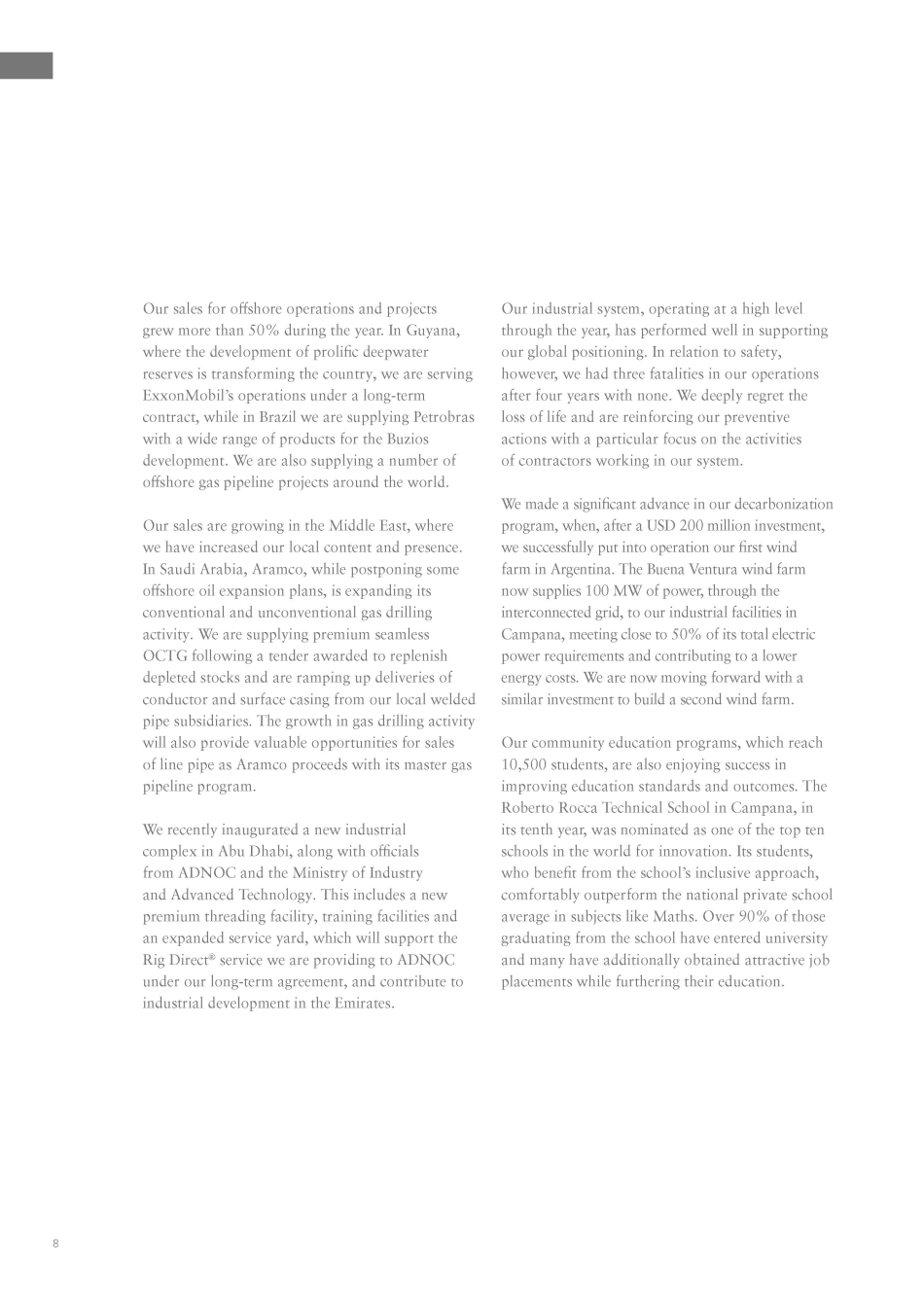
8 Our industrial system, operating at a high level through the year, has performed well in supporting our global positioning. In relation to safety, however, we had three fatalities in our operations after four years with none. We deeply regret the loss of life and are reinforcing our preventive actions with a particular focus on the activities of contractors working in our system. We made a significant advance in our decarbonization program, when, after a USD 200 million investment, we successfully put into operation our first wind farm in Argentina. The Buena Ventura wind farm now supplies 100 MW of power, through the interconnected grid, to our industrial facilities in Campana, meeting close to 50% of its total electric power requirements and contributing to a lower energy costs. We are now moving forward with a similar investment to build a second wind farm. Our community education programs, which reach 10,500 students, are also enjoying success in improving education standards and outcomes. The Roberto Rocca Technical School in Campana, in its tenth year, was nominated as one of the top ten schools in the world for innovation. Its students, who benefit from the school’s inclusive approach, comfortably outperform the national private school average in subjects like Maths. Over 90% of those graduating from the school have entered university and many have additionally obtained attractive job placements while furthering their education. Our sales for offshore operations and projects grew more than 50% during the year. In Guyana, where the development of prolific deepwater reserves is transforming the country, we are serving ExxonMobil’s operations under a long - term contract, while in Brazil we are supplying Petrobras with a wide range of products for the Buzios development. We are also supplying a number of offshore gas pipeline projects around the world. Our sales are growing in the Middle East, where we have increased our local content and presence. In Saudi Arabia, Aramco, while postponing some offshore oil expansion plans, is expanding its conventional and unconventional gas drilling activity. We are supplying premium seamless OCTG following a tender awarded to replenish depleted stocks and are ramping up deliveries of conductor and surface casing from our local welded pipe subsidiaries . The growth in gas drilling activity will also provide valuable opportunities for sales of line pipe as Aramco proceeds with its master gas pipeline program . We recently inaugurated a new industrial complex in Abu Dhabi, along with officials from ADNOC and the Ministry of Industry and Advanced Technology. This includes a new premium threading facility, training facilities and an expanded service yard, which will support the Rig Direct ® service we are providing to ADNOC under our long - term agreement, and contribute to industrial development in the Emirates.
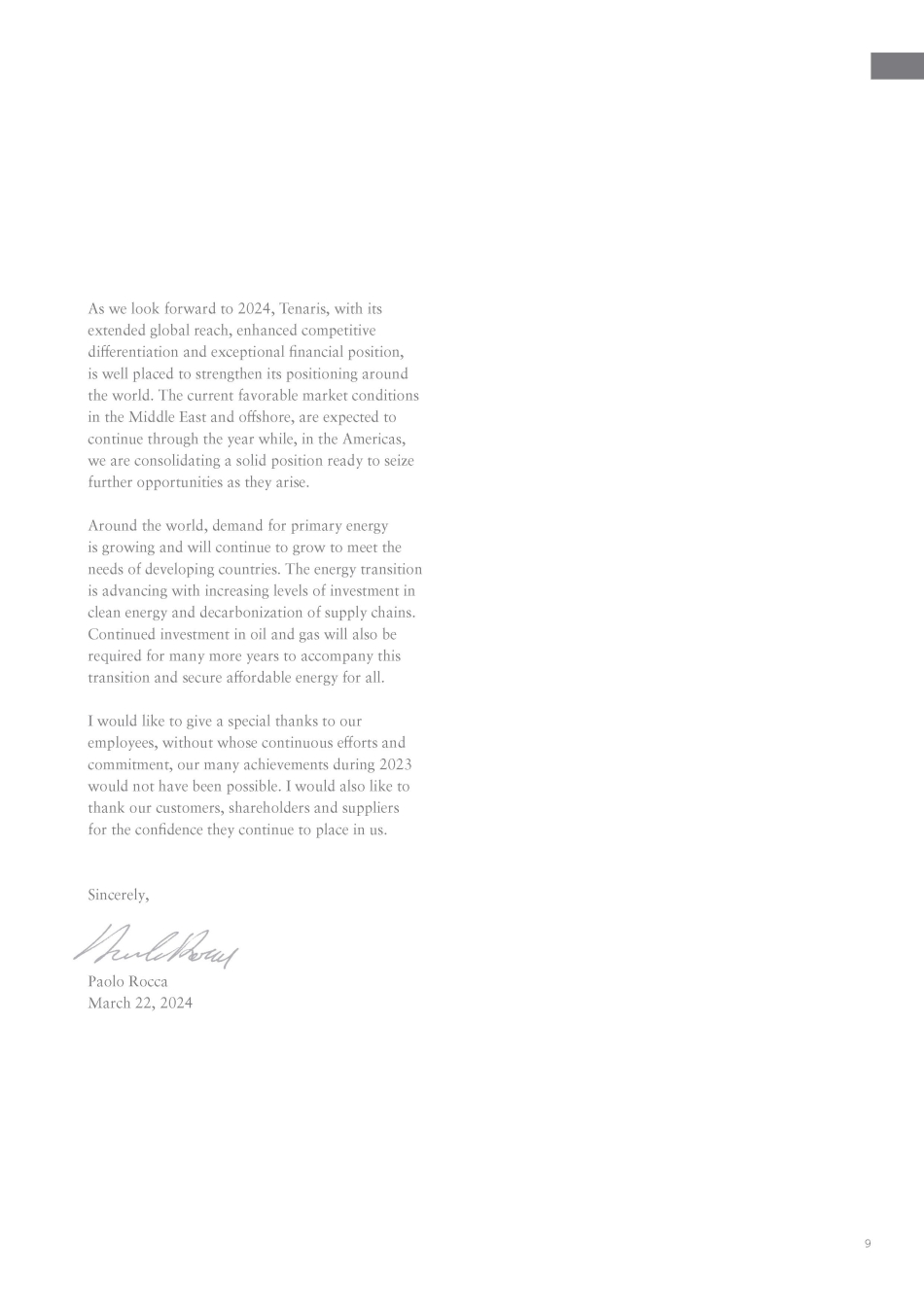
9 As we look forward to 2024, Tenaris, with its extended global reach, enhanced competitive differentiation and exceptional financial position, is well placed to strengthen its positioning around the world. The current favorable market conditions in the Middle East and offshore, are expected to continue through the year while, in the Americas, we are consolidating a solid position ready to seize further opportunities as they arise. Around the world, demand for primary energy is growing and will continue to grow to meet the needs of developing countries. The energy transition is advancing with increasing levels of investment in clean energy and decarbonization of supply chains. Continued investment in oil and gas will also be required for many more years to accompany this transition and secure affordable energy for all. I would like to give a special thanks to our employees, without whose continuous efforts and commitment, our many achievements during 2023 would not have been possible. I would also like to thank our customers, shareholders and suppliers for the confidence they continue to place in us. Sincerely, Paolo Rocca March 22, 2024

10 As a long - term industrial project, our values are rooted in sustainable principles. Since we opened our first mill in Campana, Argentina in the 1950s, to the start - up of our state - of - the - art mill in Bay City, Texas, in 2017, and our more recent expansions, our prime objective has been to grow with the communities where we work and live. We are equally committed to providing our employees with a safe working environment and professional development opportunities; to minimizing our environmental footprint, and to being a reliable partner for our customers. Tenaris is a signatory to the United Nations Global Compact, a commitment to translate the Ten Principles deriving from the Universal Declaration of Human Rights into daily business practices. Our Human Rights Policy is a pledge to aligning company operations with human rights principles. Although steel can be reused and recycled indefinitely, playing a key role in the development of society and improving quality of life, the steel industry is a significant source of carbon emissions worldwide. The industry has joined forces to promote transparent reporting and act to reduce emissions, with Tenaris playing a key role in these initiatives. For the past six years, worldsteel has named Tenaris a Sustainability Champion for “leading the way in creating a truly sustainable steel industry and society.” We have integrated climate change risks into our governance and business strategy, and set a medium - term target to reduce the carbon intensity of our activities by 2030 as part of our longer - term carbon neutrality ambition . As a leader in our industrial sector, we aim to be at the forefront of sector carbon performance and initiatives to reduce emissions. A significant part of our investments goes to improving safety and reducing the environmental impact of our operations, considered critical to our long - term sustainability. Our Health, Safety and Environment, and Quality Management systems are designed according to the latest versions of the ISO 14001, ISO 45001 and ISO 9001 standards. Today, 86% of our production sites are working under management systems certified according to these standards. Sustainability in Tenaris

11 Our reporting, in context Tenaris is committed to strengthening a corporate culture of integrity, transparency and rational decision - making. We aim to transparently disclose and communicate all issues with a positive or negative effect on our internal and external stakeholders. This report, now in its tenth edition, shows how these values translate into concrete actions and mirrored in our performance indicators. This report has been prepared with reference to the Global Reporting Initiative (GRI) and is based on guidelines established by worldsteel, the UN Global Compact, the Sustainability Accounting Standards Board (SASB) and the recommendations of the Task Force on Climate - related Financial Disclosures (TCFD). Please see the GRI, SASB and TCFD content indices at the end of this report. In this report, we highlight how our actions contribute to achieving the Sustainable Development Goals defined by the UN in 2015. The report, part of our 2023 Annual Report, has been approved by the board of directors of Tenaris S.A. (the “Company”) on March 22, 2024. It includes the non - financial information required to be disclosed in accordance with Luxembourg law. (1) Certain selected information contained in this report has been reviewed under ISAE 3000 Limited Assurance by our external auditors, PwC Société cooperative. Please see the “Accounting policies” section for specifications on methodologies and criteria used to calculate the performance indicators included in the report. (1) Article 1730 - 1 of the Luxembourg Law of August 10, 1915, on commercial companies, as amended, and Articles 68 and 68bis of the Luxembourg Law of December 19, 2002, on the commercial and companies register and on the accounting records and annual accounts of undertakings, as amended. Tenaris is playing a leading role in the development of collaborative initiatives in the steel sector to improve transparency in reporting and reduce emissions.

12 Stakeholder Engagement & Materiality Analysis Stakeholder Engagement Stakeholder engagement is an important aspect of materiality assessment, as relevant stakeholders can help assess and validate the list of material topics. Similarly, internal engagement with the undertaking’s business functions and employees also helps to assess and validate impacts, risks and opportunities . We use formal and informal methods to obtain feedback about material sustainability topics from our employees, customers, suppliers, communities, investors and other key stakeholders. A key step towards understanding the context is to identify those stakeholders who are affected, or likely to be affected by our operations. We have identified key affected stakeholders, together with a description of the different ways in which we engage with them. The activities listed in the table detail the principal ways in which we obtain feedback from stakeholders on issues related to sustainability. Other sources include the Company’s Compliance Line, available 24/7, where stakeholders can report any alleged breach of the Company's Code of Employees HOW WE ENGAGE • Frequent dialogue and exchange between managers and their teams • Quarterly feedback check - ins • Periodic Town Halls • Employee Opinion and Pulse Surveys • Performance Reviews Investors • Quarterly conference calls • In - person meetings • Quarterly anonymous feedback • Road shows and conferences • Sustainability questionnaires • Investor Day Customers • Frequent dialogue with our customers • Satisfaction surveys • Customer sustainability surveys of their supply chain Suppliers • Frequent dialogue • Training and assistance programs • Use of Open - es digital platform for sustainable supply chain information exchange Communities • Dialogue with the communities surrounding our major plants • Social media • Support for education in our communities • Volunteering activities • Community support Industry Associations • Conferences • Joint research • Benchmarking Government • Policy compliance • Articulation of Public - Private sector actions

13 Conduct or its principles, such as acts of corruption, fraud, theft, and abuse or discrimination in the workplace. See the Governance section for more information on the Company’s Compliance Line. Materiality Analysis Sustainability is not a separate program within Tenaris. As a long - term project with seven decades of history, sustainability is embedded in our core values of quality, health, safety and environment. We believe that identifying material topics is intrinsic to our daily activities. Identifying and managing impacts, risks and opportunities is what we do every day to manage our business diligently, and is inextricably linked to routine managerial duties. We define material topics based on a combination of internal and external factors which may reasonably be considered to be relevant inasmuch as they reflect our economic, environmental and social impacts, or influence the decisions of our stakeholders. Our customers value our Rig Direct ® service which integrates the supply chain, reducing the need for pipe handling and the number of people required on site, enhancing safety and minimizing environmental impact.

14 These factors include Tenaris’s own considerations and strategy, concerns expressed by stakeholders, and aspects included in the different guidelines used to prepare this report: worldsteel, UN Global Compact, GRI, SASB, and TCFD. Additionally, we take into account expert investigations and consider other, broader economic, environmental and interests raised by stakeholders. We also analyze the sustainability risks identified in the risk management roadmap prepared by our Critical Risk Committee (CRC). The material topics selected cover our whole value chain, from sourcing, product manufacturing and service delivery, to the end use of our products . Furthermore, we have benchmarked our list of material topics against worldsteel’s list of material topics. As worldsteel members, we are actively engaged in the study and identification of material topics for the industry and have also checked our list against those of other worldsteel members. During 2023, we hired an expert advisor to help us with the analysis and interpretation of new EU regulations, an exercise which has also contributed to refreshing our list of material ESG topics. Our impacts We take a comprehensive approach to the impacts, risks and opportunities associated with our operations and their financial effects, considering their potential and real consequences for Tenaris itself, as well as the potential and real impacts created by Tenaris. Positive impacts are those where we contribute to society and sustainable development through our activities. For instance, we manufacture high - quality pipes that are used to meet a significant proportion of the world’s energy requirements . We foster socio - economic development by providing jobs, training and development for our 29,000 employees and our 9,000 suppliers. We are also a relevant taxpayer in the societies where we operate, and provide educational, health and cultural support for the communities where we work. At the same time, we recognize that our actions can lead to negative impacts, particularly on the environment: through emissions, spills, waste, and effluents discharged into water, soil and air. Additionally, we recognize that our activities could, potentially, represent a risk to the health, safety and well - being of our employees, contractors and suppliers, or affect their human rights. To reduce those risks, we have implemented several policies and management processes, while taking action to minimize or mitigate any negative effects. Each chapter of this report describes the challenges we face and the policies created, or commitments made, as well as the actions taken to specifically address each topic and manage associated impacts. In addition, the sustainability topics covered in the Sustainability Report provide useful data for identifying financial risks and opportunities, as well as for conducting evaluations related to these. The following table summarizes our high - impact material topics, commitments and actions. The topics selected are those with the most significant impacts on the environment, people and the economy in the short, medium, and long term.

15 Indicators Progress and Actions Commitments Material topic & SDG • CO 2 emissions intensity • Energy intensity • % of renewables use • Reduction in CO 2 - eq intensity by 17% from 2018 baseline • First wind farm in full operation and another one in development • 12% of the electricity mix sourced from renewables • Reduce the CO 2 - eq intensity of our operations by 2030, compared to a 2018 baseline • Increase energy efficiency at our operations and the use of renewable energy sources Climate Change • Recycling content in steel • Material efficiency • 79% scrap recycling content in steel • Maximize recycling rates at our facilities • Maximize material efficiency and reduce waste Circular Economy • Air emissions • Water withdrawal • Investments in environment and energy efficiency • Investment in improving fume systems emissions control • New steel and heat treatment furnaces • Minimize emissions of fumes and particulates • Ensure responsible water management Environmental Care • Injury frequency rates • Other health & safety indicators • Revised focus on safety • The Health Care Project (well - being) • Contractor Safety Management • Establish a workplace free from fatalities and severe injuries • Look after employee safety, health and well - being Health & Safety • # of training hours • Diversity indicators • Hiring rate • Resignation rate • Engagement surveys • Talent retention and development • 50% target for female intake in graduate trainees program • Renovation of office space • Flexibility measures • Provide a safe working environment • Enable employees to develop careers while contributing to corporate goals • Promote diversity and inclusion Our People • Investment in communities • # of students benefiting from education programs • Global education programs • Volunteer activities • Arts & culture activities • Drive inclusive growth and development in our communities • Promote a culture that rewards merit and encourages academic and personal effort • Improve education in our communities, particularly technical education Local Communities • % of local suppliers • # of supplier audits • New Sustainable Sourcing Policy • Code of Conduct for suppliers • New suppliers evaluation tool • ProPymes Program • Develop reliable and competitive value chains where we operate Sustainable Value Chain • # of training hours • Compliance line results • Board oversight of sustainability topics • Code of Ethics • Critical Risk Committee • Business Conduct Compliance Program • Compliance Line • Modern Slavery Statement • Build a corporate culture of transparency and integrity based on ethical behavior and compliance with the law Ethical & Transparent Operations • Investment in R&D • Economic value generated and distributed • Product development and innovation for the energy transition • Rig Direct ® service model • Develop and improve our product and service portfolio to match evolving customer needs and enter new markets Innovation & Prosperity
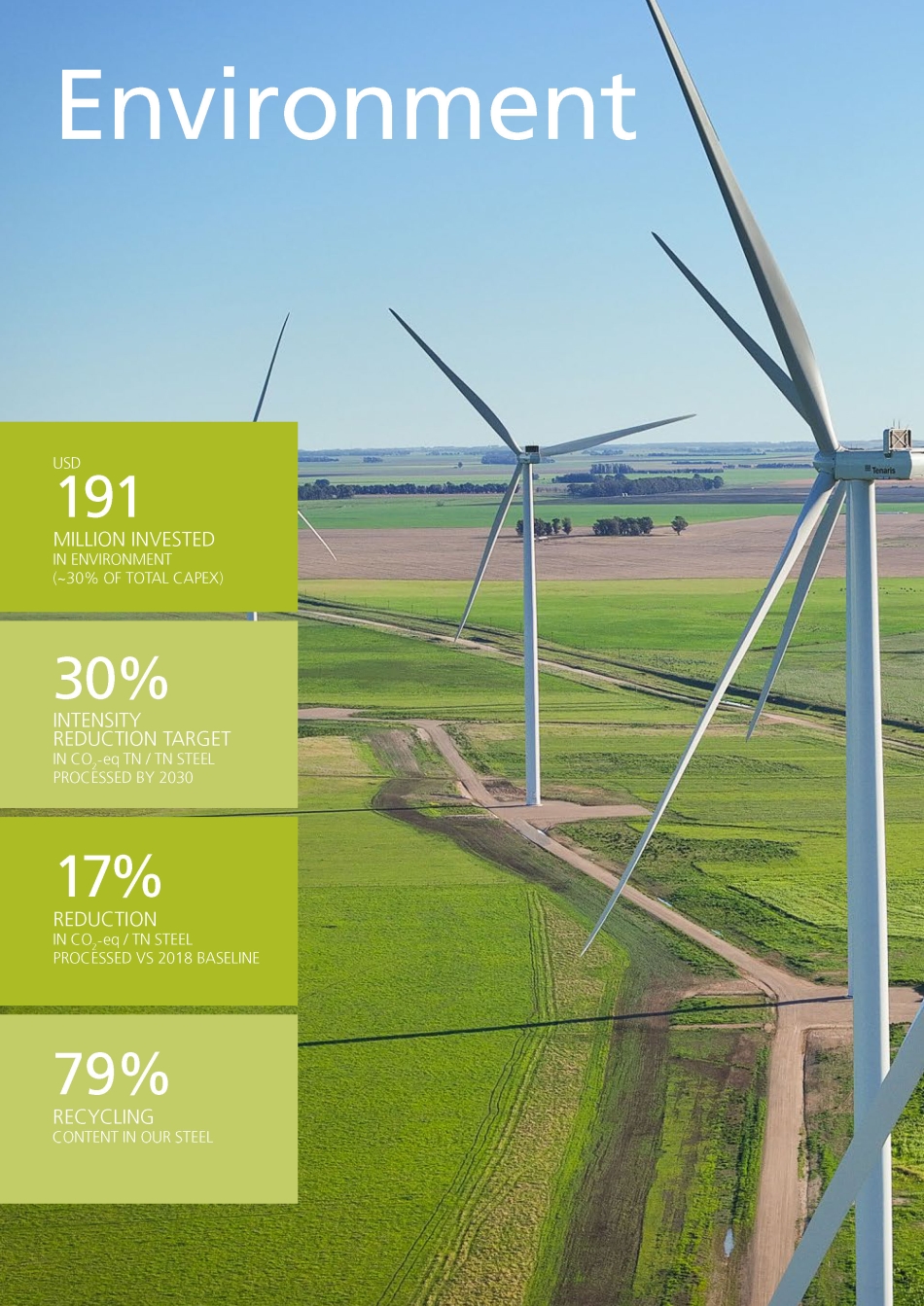
16 Environment USD 191 MILLION INVESTED IN ENVIRONMENT (~30% OF TOTAL CAPEX) 30% INTENSITY REDUCTION TARGET IN CO 2 - eq TN / TN STEEL PROCESSED BY 2030 17% REDUCTION IN CO 2 - eq / TN STEEL PROCESSED VS 2018 BASELINE 79% RECYCLING CONTENT IN OUR STEEL
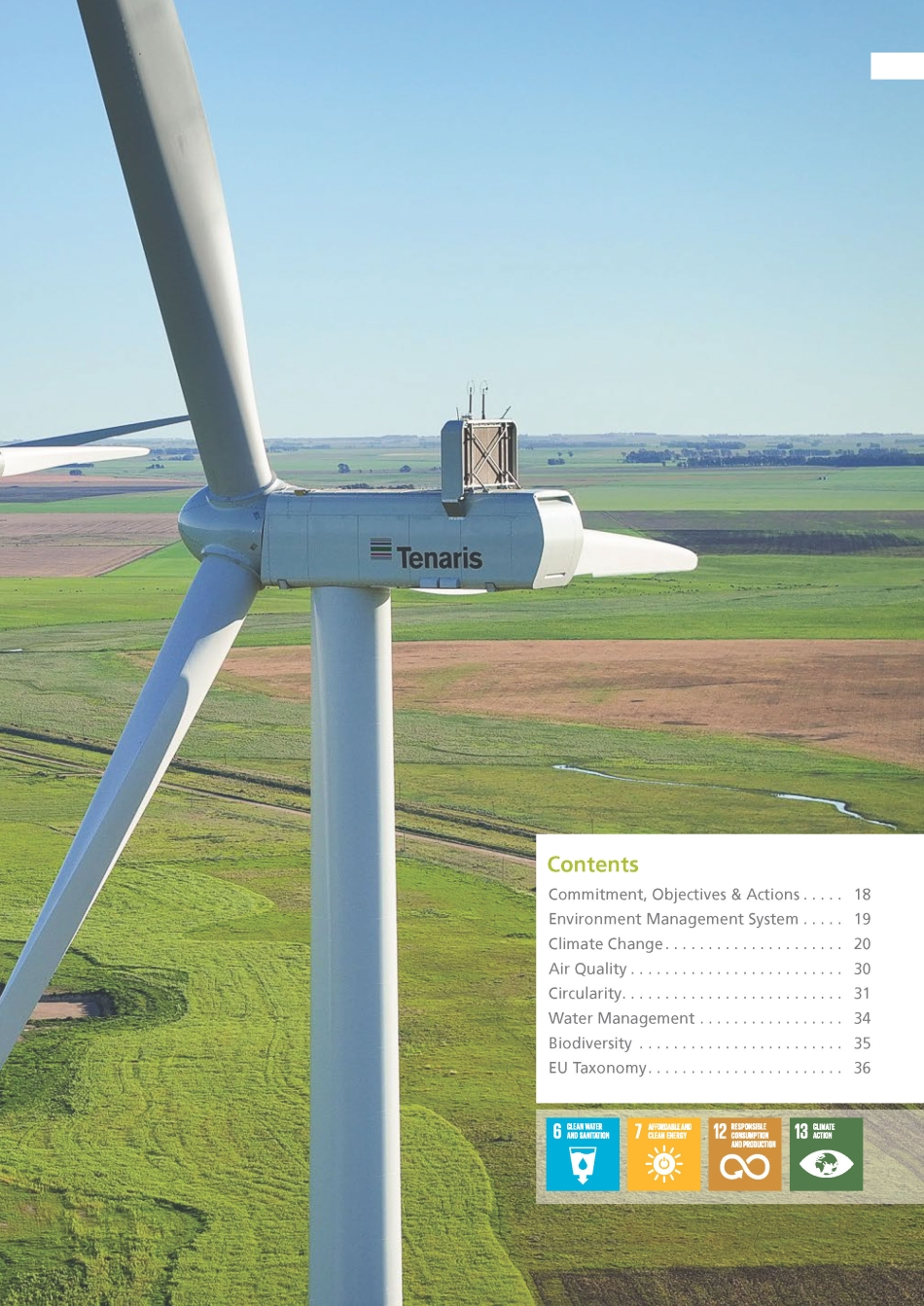
17 Contents Commitment, Objectives & Actions . . . . . 18 Environment Management System . . . . . 19 Climate Change . . . . . . . . . . . . . . . . . . . . . 20 Air Quality . . . . . . . . . . . . . . . . . . . . . . . . . 30 Circularity . . . . . . . . . . . . . . . . . . . . . . . . . . 31 Water Management . . . . . . . . . . . . . . . . . 34 Biodiversity . . . . . . . . . . . . . . . . . . . . . . . . 35 EU Taxonomy . . . . . . . . . . . . . . . . . . . . . . . 36
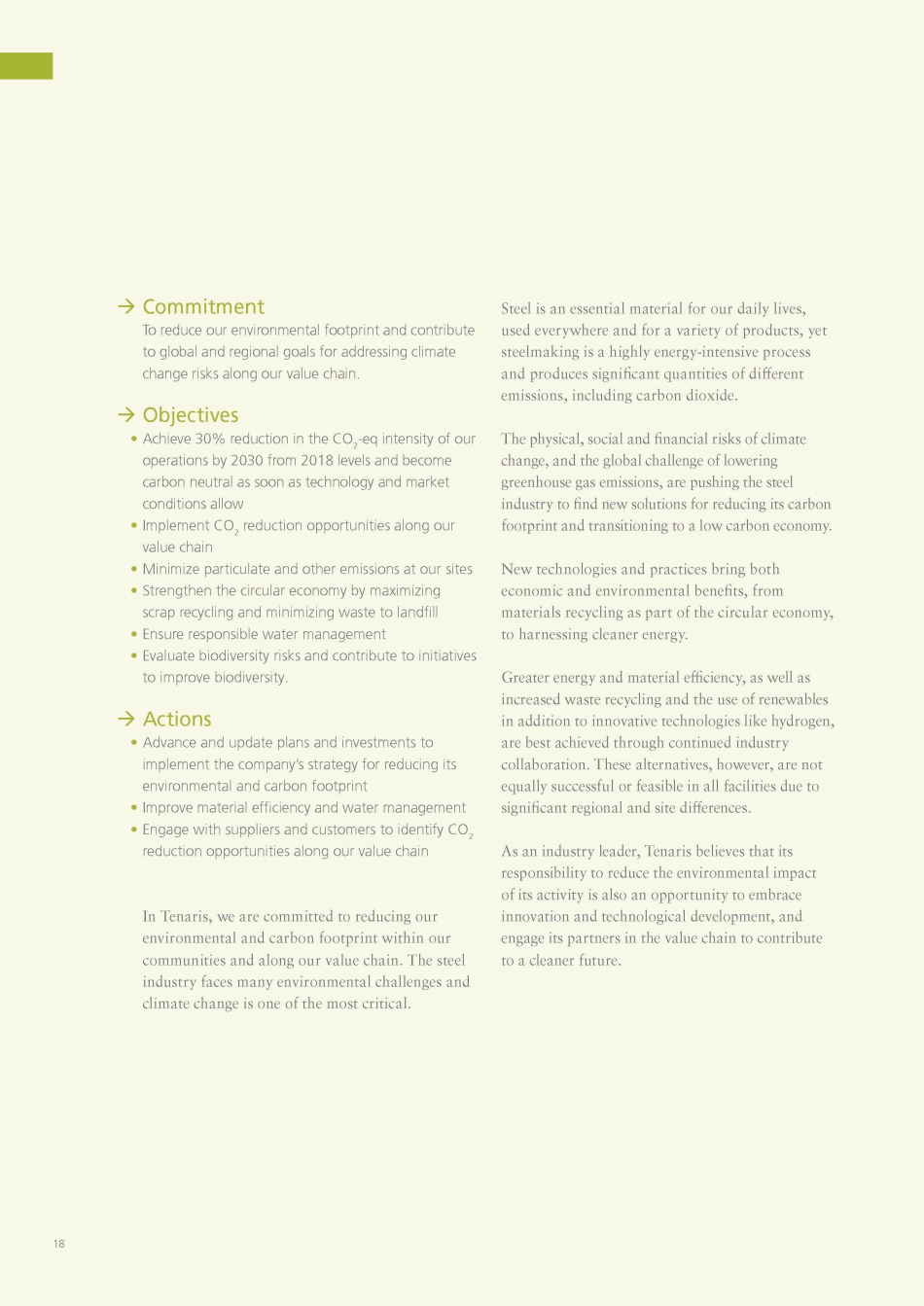
In Tenaris, we are committed to reducing our environmental and carbon footprint within our communities and along our value chain. The steel industry faces many environmental challenges and climate change is one of the most critical. Steel is an essential material for our daily lives, used everywhere and for a variety of products, yet steelmaking is a highly energy - intensive process and produces significant quantities of different emissions, including carbon dioxide. The physical, social and financial risks of climate change, and the global challenge of lowering greenhouse gas emissions, are pushing the steel industry to find new solutions for reducing its carbon footprint and transitioning to a low carbon economy. New technologies and practices bring both economic and environmental benefits, from materials recycling as part of the circular economy, to harnessing cleaner energy. Greater energy and material efficiency, as well as increased waste recycling and the use of renewables in addition to innovative technologies like hydrogen, are best achieved through continued industry collaboration. These alternatives, however, are not equally successful or feasible in all facilities due to significant regional and site differences. As an industry leader, Tenaris believes that its responsibility to reduce the environmental impact of its activity is also an opportunity to embrace innovation and technological development, and engage its partners in the value chain to contribute to a cleaner future. Commitment To reduce our environmental footprint and contribute to global and regional goals for addressing climate change risks along our value chain. Objectives • Achieve 30% reduction in the CO 2 - eq intensity of our operations by 2030 from 2018 levels and become carbon neutral as soon as technology and market conditions allow • Implement CO 2 reduction opportunities along our value chain • Minimize particulate and other emissions at our sites • Strengthen the circular economy by maximizing scrap recycling and minimizing waste to landfill • Ensure responsible water management • Evaluate biodiversity risks and contribute to initiatives to improve biodiversity. Actions • Advance and update plans and investments to implement the company’s strategy for reducing its environmental and carbon footprint • Improve material efficiency and water management • Engage with suppliers and customers to identify CO 2 reduction opportunities along our value chain 18
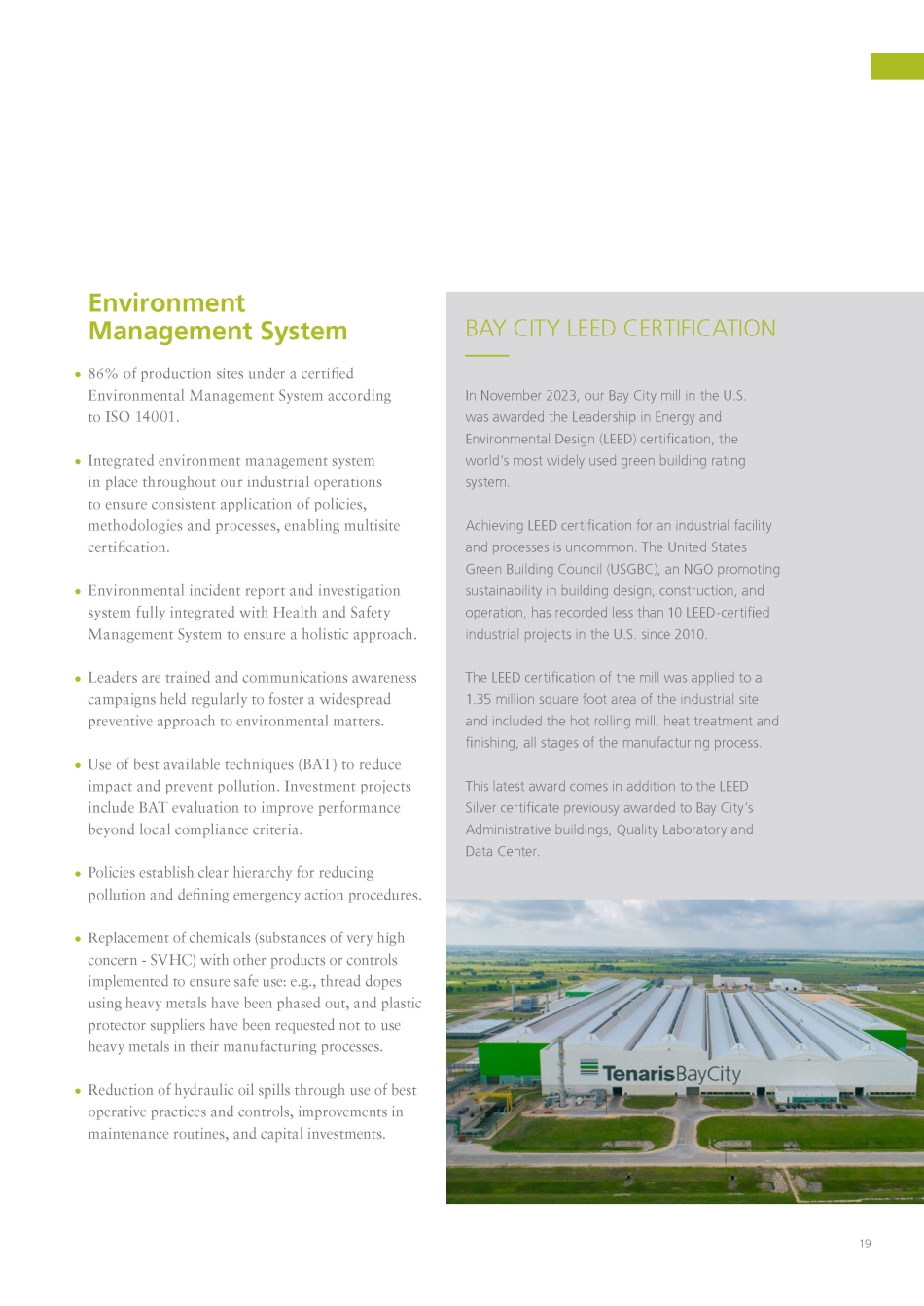
19 Environment Management System • 86% of production sites under a certified Environmental Management System according to ISO 14001. • Integrated environment management system in place throughout our industrial operations to ensure consistent application of policies, methodologies and processes, enabling multisite certification. • Environmental incident report and investigation system fully integrated with Health and Safety Management System to ensure a holistic approach. • Leaders are trained and communications awareness campaigns held regularly to foster a widespread preventive approach to environmental matters. • Use of best available techniques (BAT) to reduce impact and prevent pollution. Investment projects include BAT evaluation to improve performance beyond local compliance criteria. • Policies establish clear hierarchy for reducing pollution and defining emergency action procedures. • Replacement of chemicals (substances of very high concern - SVHC) with other products or controls implemented to ensure safe use: e.g., thread dopes using heavy metals have been phased out, and plastic protector suppliers have been requested not to use heavy metals in their manufacturing processes. • Reduction of hydraulic oil spills through use of best operative practices and controls, improvements in maintenance routines, and capital investments. BAY CITY LEED CERTIFICATION In November 2023, our Bay City mill in the U.S. was awarded the Leadership in Energy and Environmental Design (LEED) certification, the world’s most widely used green building rating system. Achieving LEED certification for an industrial facility and processes is uncommon. The United States Green Building Council (USGBC), an NGO promoting sustainability in building design, construction, and operation, has recorded less than 10 LEED - certified industrial projects in the U.S. since 2010. The LEED certification of the mill was applied to a 1.35 million square foot area of the industrial site and included the hot rolling mill, heat treatment and finishing, all stages of the manufacturing process. This latest award comes in addition to the LEED Silver certificate previousy awarded to Bay City’s Administrative buildings, Quality Laboratory and Data Center.

20 Climate change Our commitment To reduce the intensity of our CO 2 - eq emissions and reach carbon neutrality as soon as technology and market conditions allow. Our objectives • Achieve 30% reduction in the CO 2 - eq intensity of our operations by 2030 from 2018 levels, as a mid - term target towards becoming carbon neutral as soon as technology and market conditions allow • Identify and implement actions to reduce the intensity of CO 2 - eq emissions: e.g., increase scrap and low - carbon electricity usage, utilize hydrogen and carbon capture techniques to progressively replace and/or abate fossil fuel use in operations • Increase energy and materials use efficiency in operations • Offer customers products and services to help minimize their footprint and support their own strategies • Engage with suppliers to encourage production and use of more sustainable products, services and operations . Tenaris recognizes the profound challenges posed by climate change, both to society at large and to our business specifically, considering the markets in which we engage, how government regulations may influence our operations and those of our customers, and the geographical location of our physical assets (see “Risks affecting our business”). At the same time, climate change presents strategic opportunities for us not only to strengthen our market leadership but also to explore new sales avenues. Given the relevance of climate change for the company’s overall business and strategy, our Board of Directors quarterly reviews the progress of our climate change strategy and other relevant factors. As part of our efforts to combat climate change, we are investing in and refining our operations to reduce their carbon intensity. We are also developing products and services tailored for use in low - carbon energy applications. We regularly assess and track global progress towards the energy transition, keeping an eye on policies, regulations, technologies and other global and national developments that could speed up or hinder the progress of this transition in the years to come, as well as other factors that could affect or pose particular risks to our operations. We recently conducted a climate risk assessment t o better understand our most relevant industrial facilities ʼ long - term vulnerability t o climate effects and physical climate risk, using the Intergovernmental Panel on Climate Change (IPCC) high - emissions Representative Concentration Pathway (RCP) 8.5 global warming scenario, which showed no undue exposure to risks for which Tenaris is unprepared. We work closely with our customers to support their efforts to establish sustainable sourcing policies across their supply chain, thus requiring a more detailed disclosure of climate change - related impacts. We thus continue to report to the Carbon Disclosure Program (CDP) and are using the Ecovadis and Open - es sustainability assessment platforms, among others. Our Sustainable Purchasing Policy is a framework supporting further action towards a more sustainable supply chain, allowing us to encourage our suppliers to work in the same direction.

21 In Argentina, where steel scrap availability is limited, we operate a facility to produce DRI using natural gas. Steel produced in electric arc furnaces using a high proportion of scrap in the metallic charge generally has a much lower carbon intensity than steel made using iron ore and metallurgical coal as primary feedstock. We also purchase steel from third - party suppliers, primarily to manufacture welded pipe products. As many of these suppliers make steel products using iron ore and coal, the carbon emissions intensity of the pipes made with this steel is often far greater than that of those manufactured with our own steel. EAF producer All the steel we manufacture is produced in electric arc furnaces using recycled steel scrap as the primary source of metallic feedstock. We supplement the use of steel scrap with metallics such as pig iron, direct reduced iron (DRI) and ferroalloys, to meet quality, productivity and materials specifications. The carbon emissions intensity for steel products produced at our steel manufacturing sites is 37% below the average for the global steel industry in tons, according to worldsteel. Rolling, heat treatment & finishing 0 0.5 1.0 1.5 2.0 2.5 SEAMLESS TUBES STEEL Welding, heat treatment & finishing Scope 1 Scope 2 Scope 3 Average values of CO 2 - eq intensity. Scopes: 1 : Direct emissions from the site. 2 : Indirect emissions related to electricity consumption. 3 : Indirect emissions related to raw materials use. % WELDED TUBES Steel making Natural gas Electricity 0.2 – 0.5 tn CO 2 - eq / ton steel Scope 1 Scope 2 % 0 0.5 1.0 1.5 2.0 2.5 1.1 – 2.5 tn CO 2 - eq / ton steel CO 2 - eq Range 0 0.5 1.0 1.5 2.0 2.5 Scope 2 Scope 3 DRI + Iron ore + Steel plates or coils EAF + Scrap + Pig iron/ hot briquetted iron 0.3 – 1.2 tn CO 2 - eq / ton steel Scope 1 %
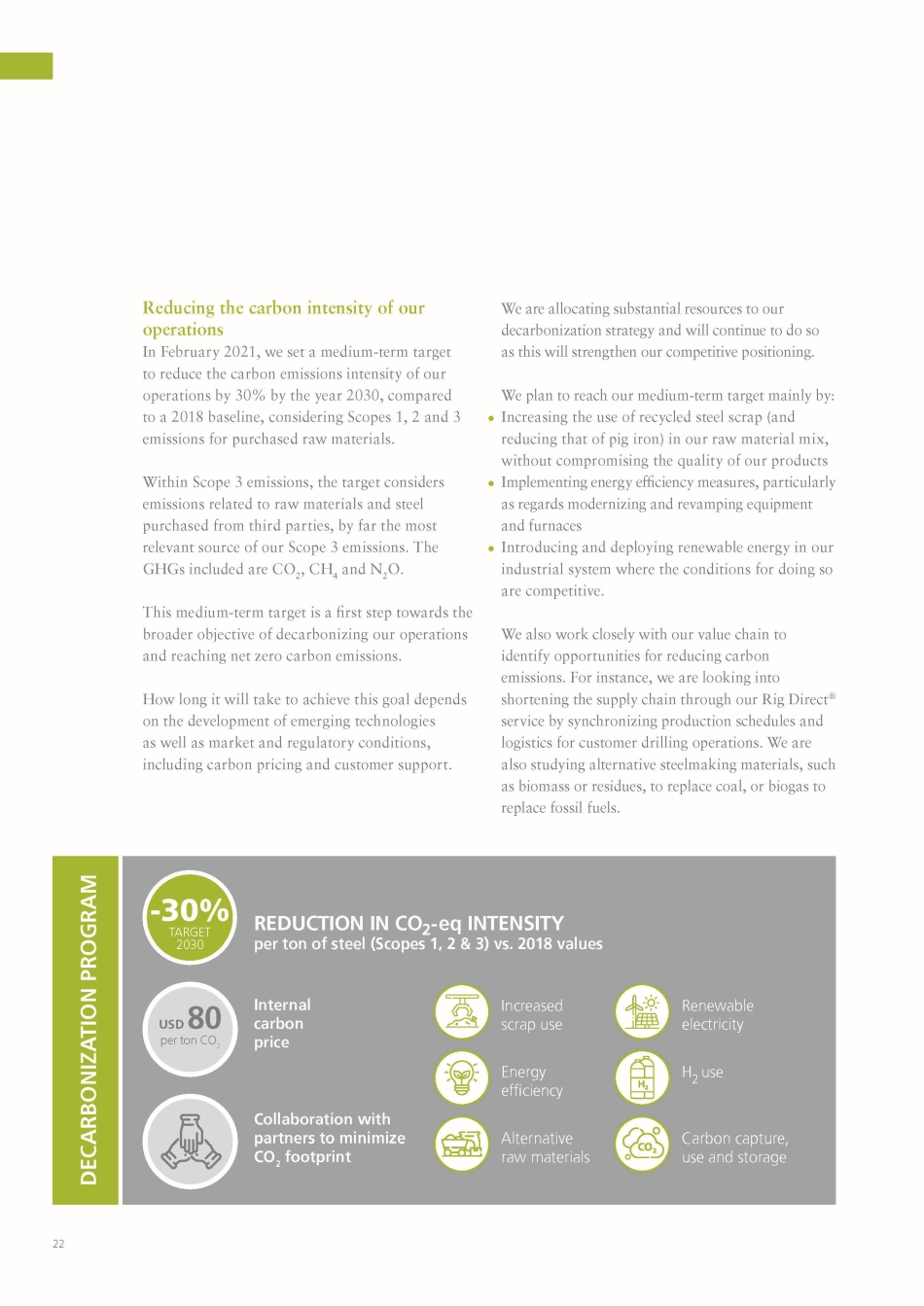
22 We are allocating substantial resources to our decarbonization strategy and will continue to do so as this will strengthen our competitive positioning. We plan to reach our medium - term target mainly by: • Increasing the use of recycled steel scrap (and reducing that of pig iron) in our raw material mix, without compromising the quality of our products • Implementing energy efficiency measures, particularly as regards modernizing and revamping equipment and furnaces • Introducing and deploying renewable energy in our industrial system where the conditions for doing so are competitive . We also work closely with our value chain to identify opportunities for reducing carbon emissions. For instance, we are looking into shortening the supply chain through our Rig Direct ® service by synchronizing production schedules and logistics for customer drilling operations. We are also studying alternative steelmaking materials, such as biomass or residues, to replace coal, or biogas to replace fossil fuels. Reducing the carbon intensity of our operations In February 2021, we set a medium - term target to reduce the carbon emissions intensity of our operations by 30% by the year 2030, compared to a 2018 baseline, considering Scopes 1, 2 and 3 emissions for purchased raw materials. Within Scope 3 emissions, the target considers emissions related to raw materials and steel purchased from third parties, by far the most relevant source of our Scope 3 emissions. The GHGs included are CO 2 , CH 4 and N 2 O. This medium - term target is a first step towards the broader objective of decarbonizing our operations and reaching net zero carbon emissions. How long it will take to achieve this goal depends on the development of emerging technologies as well as market and regulatory conditions, including carbon pricing and customer support. Internal carbon price USD 80 per ton CO 2 - 30% TARGET 2030 REDUCTION IN CO 2 - eq INTENSITY per ton of steel (Scopes 1, 2 & 3) vs. 2018 values Collaboration with partners to minimize CO 2 footprint Energy H 2 use efficiency Increased scrap use Renewable electricity Alternative raw materials Carbon capture, use and storage DECARBONIZATION PROGRAM
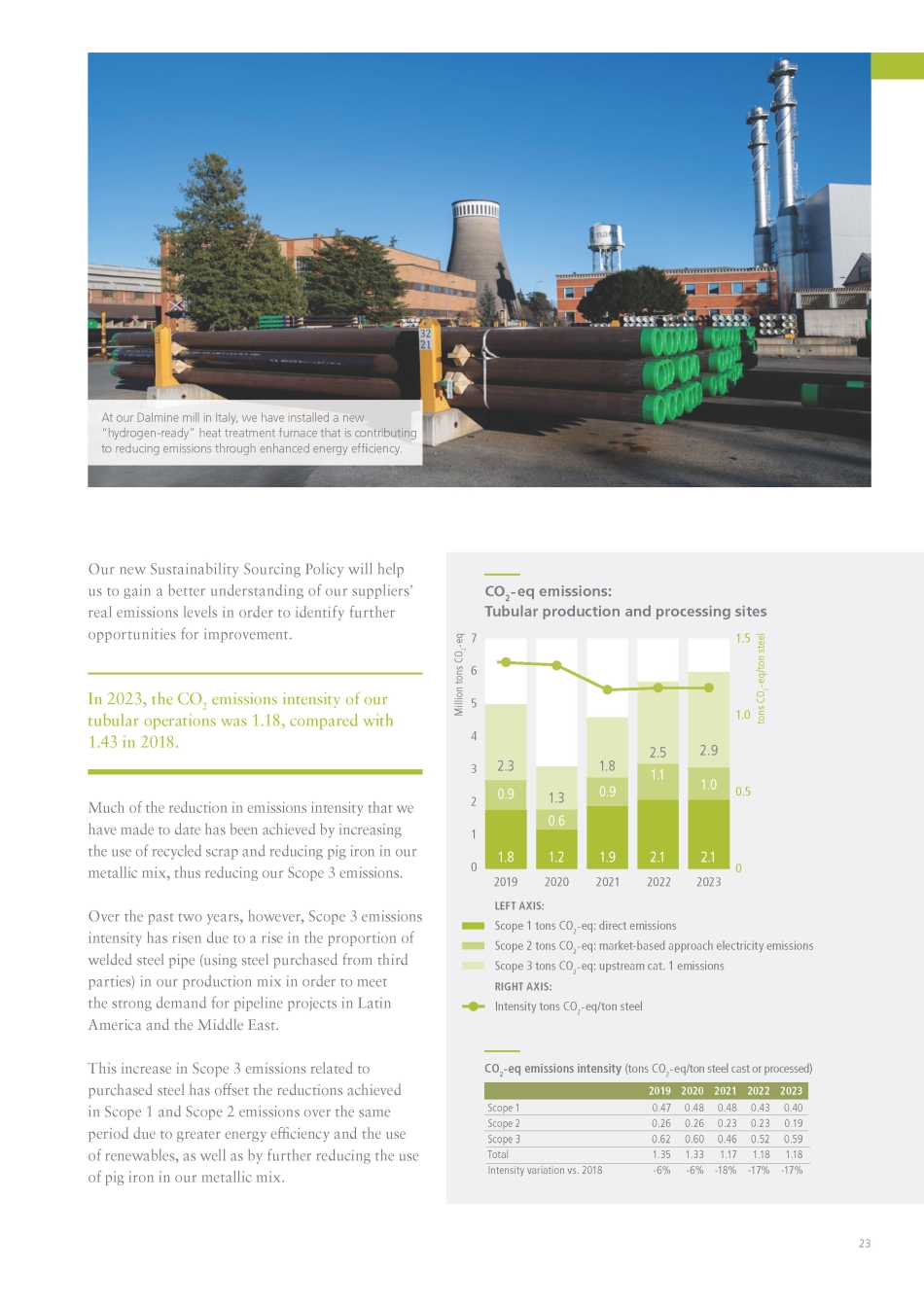
23 Our new Sustainability Sourcing Policy will help us to gain a better understanding of our suppliers’ real emissions levels in order to identify further opportunities for improvement. In 2023, the CO 2 emissions intensity of our tubular operations was 1.18, compared with 1.43 in 2018. Much of the reduction in emissions intensity that we have made to date has been achieved by increasing the use of recycled scrap and reducing pig iron in our metallic mix, thus reducing our Scope 3 emissions. Over the past two years, however, Scope 3 emissions intensity has risen due to a rise in the proportion of welded steel pipe (using steel purchased from third parties) in our production mix in order to meet the strong demand for pipeline projects in Latin America and the Middle East. This increase in Scope 3 emissions related to purchased steel has offset the reductions achieved in Scope 1 and Scope 2 emissions over the same period due to greater energy efficiency and the use of renewables, as well as by further reducing the use of pig iron in our metallic mix. CO 2 - eq emissions: Tubular production and processing sites Scope 1 tons CO - eq: direct emissions 2 Scope 2 tons CO 2 - eq: market - based approach electricity emissions 2 Scope 3 tons CO - eq: upstream cat. 1 emissions RIGHT AXIS: 2 Intensity tons CO - eq/ton steel 1.5 1.0 0.5 0 tons CO 2 - eq/ton steel Million tons CO 2 - eq 7 6 5 4 3 2 1 0 2.1 1.1 2.5 2021 1.9 0.9 1.8 2020 1.2 1.3 0.6 2019 LEFT AXIS: 2.3 1.8 0.9 2022 2023 At our Dalmine mill in Italy, we have installed a new “hydrogen - ready” heat treatment furnace that is contributing to reducing emissions through enhanced energy efficiency. 2.1 1.0 2.9 CO 2 - eq emissions intensity (tons CO 2 - eq/ton steel cast or processed) 2023 2022 2021 2020 2019 0.40 0.43 0.48 0.48 0.47 Scope 1 0.19 0.23 0.23 0.26 0.26 Scope 2 0.59 0.52 0.46 0.60 0.62 Scope 3 1.18 1.18 1.17 1.33 1.35 Total - 17% - 17% - 18% - 6% - 6% Intensity variation vs. 2018
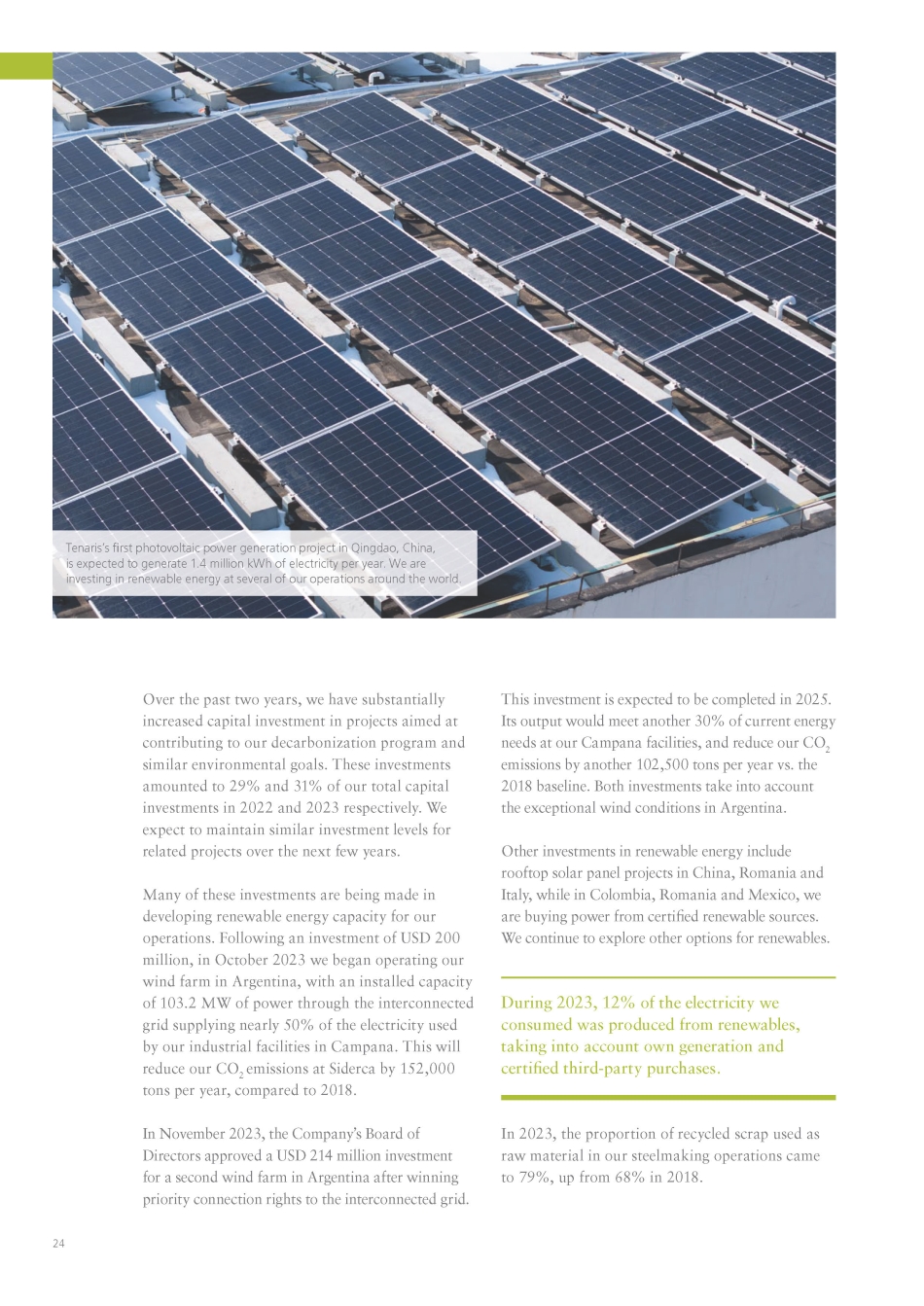
24 Over the past two years, we have substantially increased capital investment in projects aimed at contributing to our decarbonization program and similar environmental goals. These investments amounted to 29% and 31% of our total capital investments in 2022 and 2023 respectively. We expect to maintain similar investment levels for related projects over the next few years. Many of these investments are being made in developing renewable energy capacity for our operations. Following an investment of USD 200 million, in October 2023 we began operating our wind farm in Argentina, with an installed capacity of 103.2 MW of power through the interconnected grid supplying nearly 50% of the electricity used by our industrial facilities in Campana. This will reduce our CO 2 emissions at Siderca by 152,000 tons per year, compared to 2018. In November 2023, the Company ʼ s Board of Directors approved a USD 214 million investment for a second wind farm in Argentina after winning priority connection rights to the interconnected grid. This investment is expected to be completed in 2025. Its output would meet another 30% of current energy needs at our Campana facilities, and reduce our CO 2 emissions by another 102,500 tons per year vs. the 2018 baseline. Both investments take into account the exceptional wind conditions in Argentina. Other investments in renewable energy include rooftop solar panel projects in China, Romania and Italy, while in Colombia, Romania and Mexico, we are buying power from certified renewable sources. We continue to explore other options for renewables. During 2023, 12% of the electricity we consumed was produced from renewables, taking into account own generation and certified third - party purchases. In 2023 , the proportion of recycled scrap used as raw material in our steelmaking operations came to 79 % , up from 68 % in 2018 . Tenaris’s first photovoltaic power generation project in Qingdao, China, is expected to generate 1.4 million kWh of electricity per year. We are investing in renewable energy at several of our operations around the world.
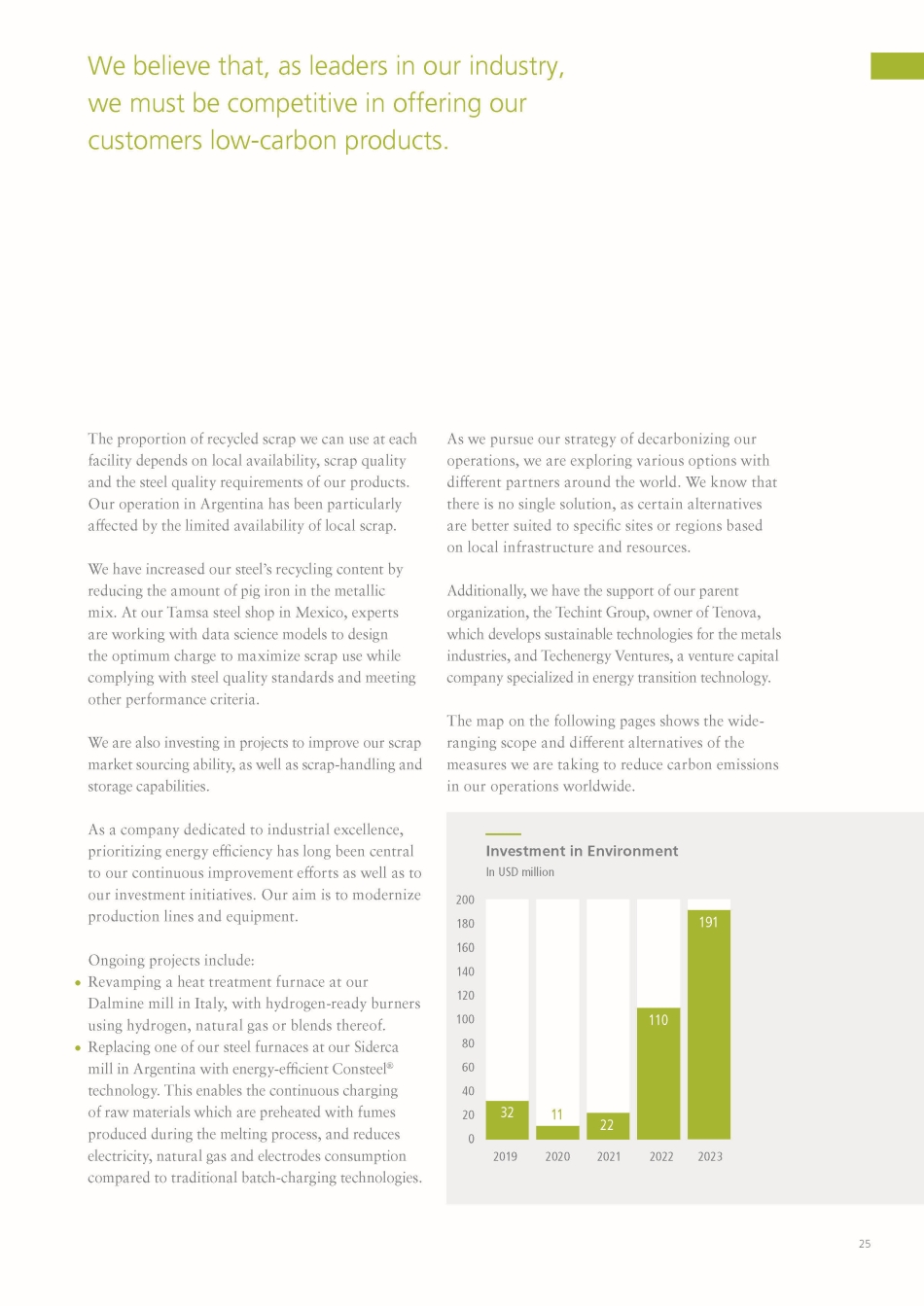
25 The proportion of recycled scrap we can use at each facility depends on local availability, scrap quality and the steel quality requirements of our products. Our operation in Argentina has been particularly affected by the limited availability of local scrap. We have increased our steel’s recycling content by reducing the amount of pig iron in the metallic mix. At our Tamsa steel shop in Mexico, experts are working with data science models to design the optimum charge to maximize scrap use while complying with steel quality standards and meeting other performance criteria. We are also investing in projects to improve our scrap market sourcing ability, as well as scrap - handling and storage capabilities . As a company dedicated to industrial excellence, prioritizing energy efficiency has long been central to our continuous improvement efforts as well as to our investment initiatives. Our aim is to modernize production lines and equipment. Ongoing projects include: • Revamping a heat treatment furnace at our Dalmine mill in Italy, with hydrogen - ready burners using hydrogen, natural gas or blends thereof. • Replacing one of our steel furnaces at our Siderca mill in Argentina with energy - efficient Consteel ® technology. This enables the continuous charging of raw materials which are preheated with fumes produced during the melting process, and reduces electricity, natural gas and electrodes consumption compared to traditional batch - charging technologies. As we pursue our strategy of decarbonizing our operations, we are exploring various options with different partners around the world. We know that there is no single solution, as certain alternatives are better suited to specific sites or regions based on local infrastructure and resources. Additionally, we have the support of our parent organization, the Techint Group, owner of Tenova, which develops sustainable technologies for the metals industries, and Techenergy Ventures, a venture capital company specialized in energy transition technology. The map on the following pages shows the wide - ranging scope and different alternatives of the measures we are taking to reduce carbon emissions in our operations worldwide. We believe that, as leaders in our industry, we must be competitive in offering our customers low - carbon products. Investment in Environment In USD million 200 180 160 140 120 100 80 60 40 20 0 2019 2020 2021 2022 2023 191 22 32 11 110
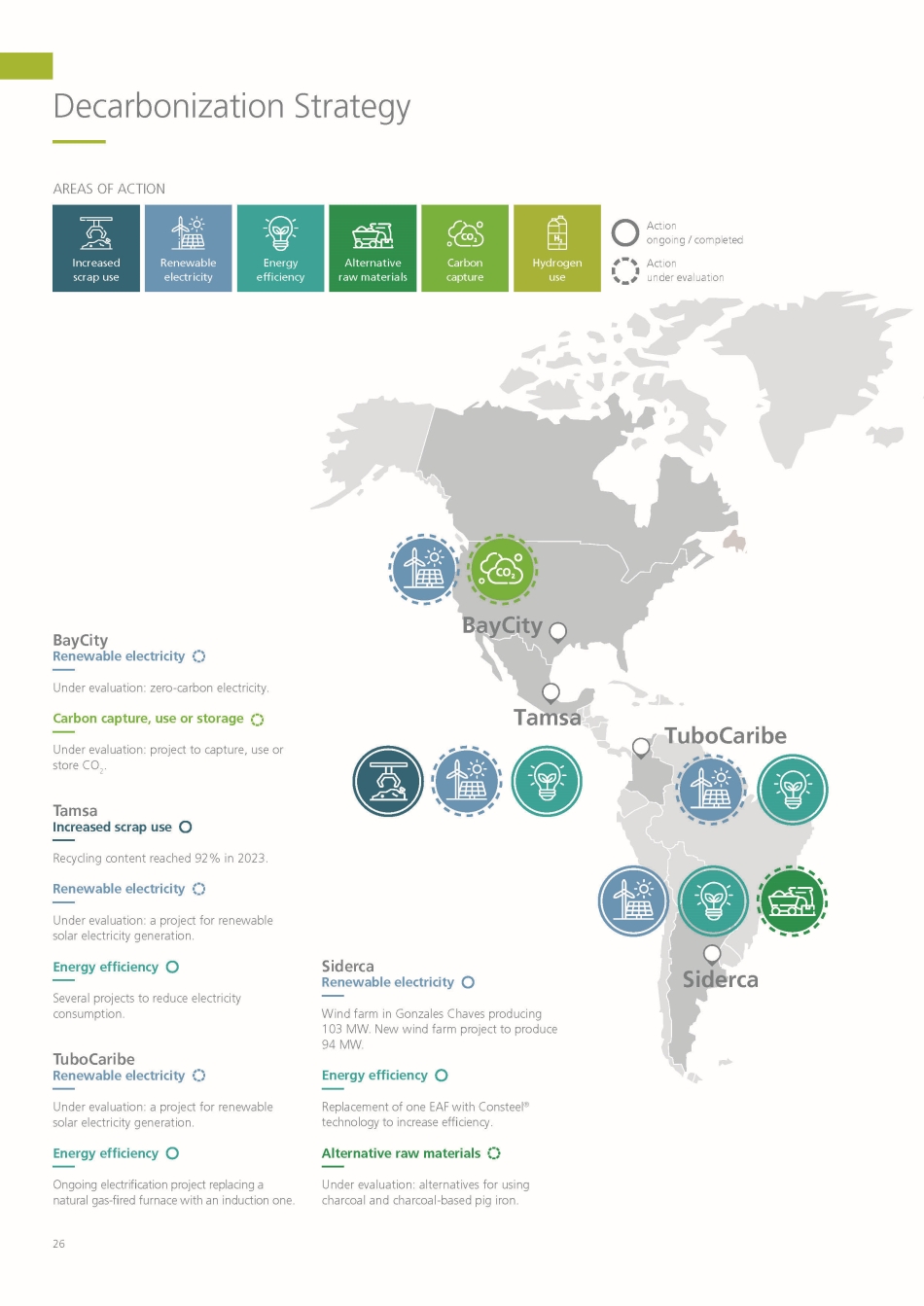
26 Siderca TuboCaribe BayCity Tamsa Decarbonization Strategy BayCity Renewable electricity Under evaluation: zero - carbon electricity. Carbon capture, use or storage Under evaluation: project to capture, use or store CO 2 . Tamsa Increased scrap use Recycling content reached 92% in 2023. Renewable electricity Under evaluation: a project for renewable solar electricity generation. Energy efficiency Several projects to reduce electricity consumption. TuboCaribe Renewable electricity Under evaluation: a project for renewable solar electricity generation. Energy efficiency Ongoing electrification project replacing a natural gas - fired furnace with an induction one. Siderca Renewable electricity Wind farm in Gonzales Chaves producing 103 MW. New wind farm project to produce 94 MW. Energy efficiency Replacement of one EAF with Consteel ® technology to increase efficiency. Alternative raw materials Under evaluation: alternatives for using charcoal and charcoal - based pig iron. Action ongoing / completed Action Hydrogen Carbon Alternative Energy Renewable Increased under evaluation use capture raw materials efficiency electricity scrap use AREAS OF ACTION
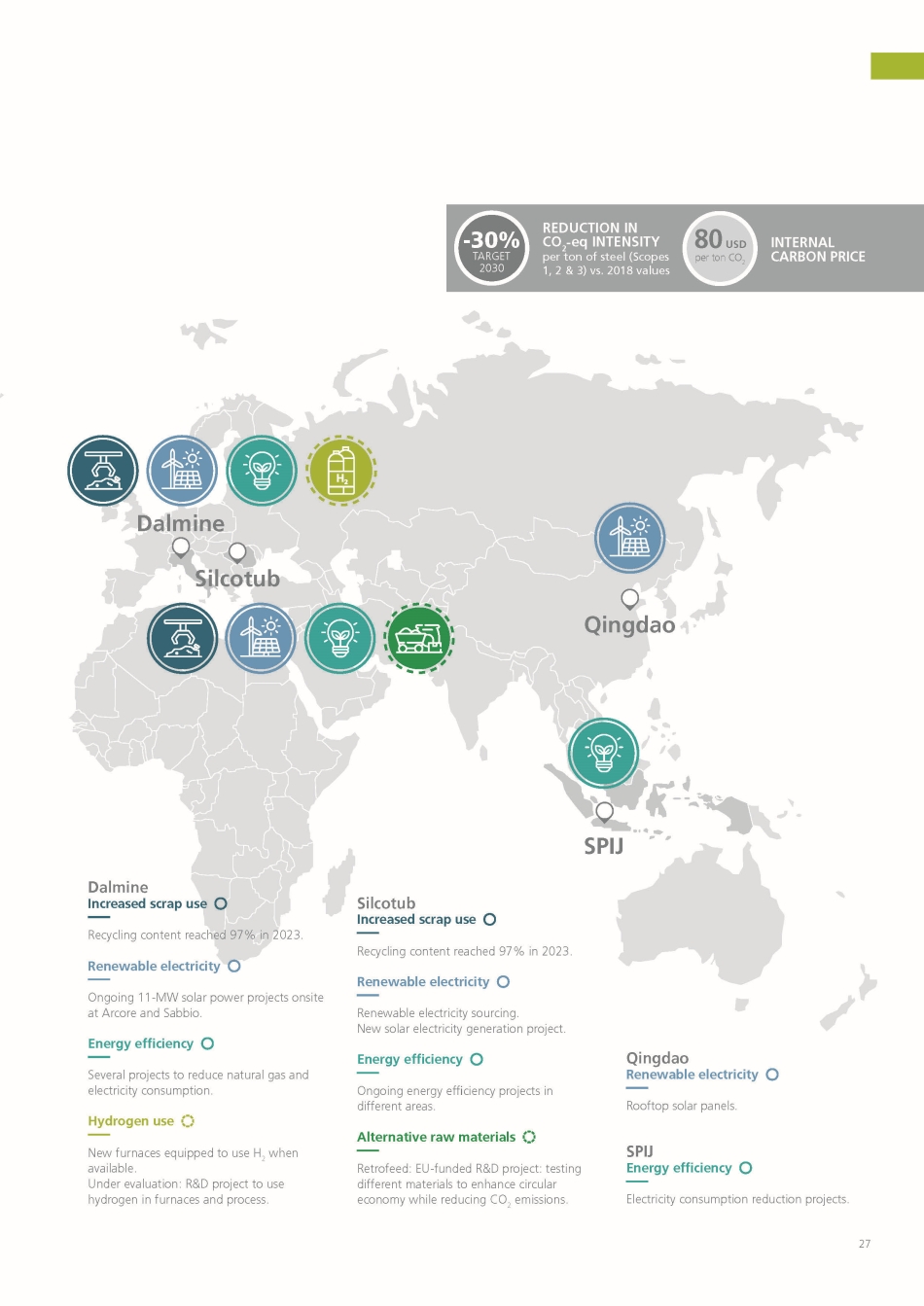
27 Qingdao Dalmine Silcotub SPIJ Qingdao Renewable electricity Rooftop solar panels. SPIJ Energy efficiency Electricity consumption reduction projects. Dalmine Increased scrap use Ongoing 11 - MW solar power projects onsite at Arcore and Sabbio. Energy efficiency Several projects to reduce natural gas and electricity consumption. Hydrogen use New furnaces equipped to use H 2 when available. Under evaluation: R&D project to use hydrogen in furnaces and process. Silcotub Increased scrap use Recycling content reached 97% in 2023. Recycling content reached 97% in 2023. Renewable electricity Renewable electricity Renewable electricity sourcing. New solar electricity generation project. Energy efficiency Ongoing energy efficiency projects in different areas. Alternative raw materials Retrofeed: EU - funded R&D project: testing different materials to enhance circular economy while reducing CO 2 emissions. 2030 REDUCTION IN - 30% CO 2 - eq INTENSITY TARGET per ton of steel (Scopes 1, 2 & 3) vs . 2018 values 80 USD INTERNAL per ton CO 2 CARBON PRICE

28 Tenaris takes these risks into consideration when evaluating its investments in major projects and the acquisition of equipment to produce steel pipes, factoring them into the accounting estimates and assumptions used to assess the carrying value of its assets. Products for the energy transition As suppliers of tubular products and services to the energy industry, the energy transition provides us with an opportunity to develop new products and services for potentially fast - growing segments such as hydrogen transportation and storage, carbon capture and storage (CCS), and geothermal installations. Over the past three years, we have increased our investments in R&D and sharpened our organizational focus in these areas, as they are expected to contribute a highly relevant revenue stream to the company in the future. We have developed a range of materials technologies and products that have been tested for use in hydrogen storage and transportation, CCS injection wells, and geothermal applications. Regarding hydrogen storage and transportation, we are seeing growth in demand for large, high - pressure vessels used in the build out of hydrogen refueling stations for heavy - duty vehicles and buses. Initially in Europe and California, these stations are now becoming more common. We have also observed increasing customer interest in developing geothermal, waste - to - energy and CCS projects. Internal carbon price and financial considerations To speed up the achievement of our decarbonization targets and prepare for the potential adoption of additional carbon pricing mechanisms around the world, in 2021, we introduced an internal carbon price of a minimum of USD 80/ton. This internal carbon price is primarily used to evaluate investments in projects that could help to decarbonize our operations. We continuously track the strategies of our major customers and their projections for future energy demand. This includes aligning with global goals to address climate change by reducing carbon emissions in accordance with the Paris Agreement, as well as supporting national objectives for a carbon - neutral world. We also assess the future market outlook for our products, taking into account different oil and gas demand scenarios as published by our customers, international agencies like the International Energy Agency (IEA), and energy market consultancies, such as Rystad. We pay particular attention to historical records and the potential pace of change in the adoption of new technologies, regulations and behaviors which could affect future oil and gas demand. We use these scenarios and assessments as essential input to shape and assess our business strategy, and how we address the risks and opportunities arising from climate change. The transition from current reliance on fossil fuels, including oil and gas, to cleaner alternatives is uncertain, with a wide range of potential outcomes . This transition is further complicated by the simultaneous expectation of an overall increase in energy demand .

29 We monitor global trends to estimate future energy needs within the context of the energy transition, where gas transmission networks will play an important role.
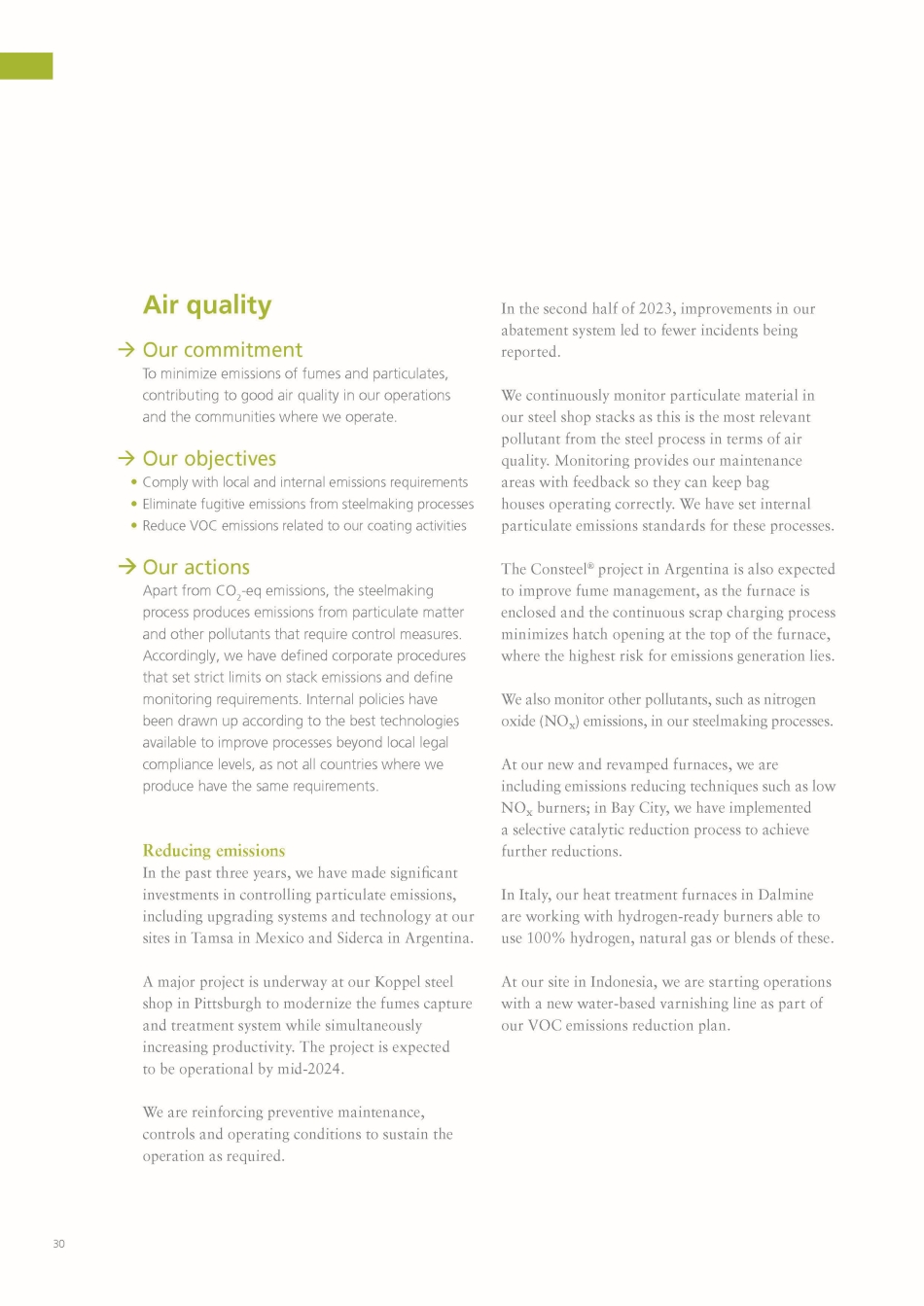
30 Air quality Our commitment To minimize emissions of fumes and particulates, contributing to good air quality in our operations and the communities where we operate . Our objectives • Comply with local and internal emissions requirements • Eliminate fugitive emissions from steelmaking processes • Reduce VOC emissions related to our coating activities Our actions Apart from CO 2 - eq emissions, the steelmaking process produces emissions from particulate matter and other pollutants that require control measures. Accordingly, we have defined corporate procedures that set strict limits on stack emissions and define monitoring requirements. Internal policies have been drawn up according to the best technologies available to improve processes beyond local legal compliance levels, as not all countries where we produce have the same requirements. Reducing emissions In the past three years, we have made significant investments in controlling particulate emissions, including upgrading systems and technology at our sites in Tamsa in Mexico and Siderca in Argentina. A major project is underway at our Koppel steel shop in Pittsburgh to modernize the fumes capture and treatment system while simultaneously increasing productivity. The project is expected to be operational by mid - 2024. We are reinforcing preventive maintenance, controls and operating conditions to sustain the operation as required. In the second half of 2023, improvements in our abatement system led to fewer incidents being reported. We continuously monitor particulate material in our steel shop stacks as this is the most relevant pollutant from the steel process in terms of air quality. Monitoring provides our maintenance areas with feedback so they can keep bag houses operating correctly. We have set internal particulate emissions standards for these processes. The Consteel ® project in Argentina is also expected to improve fume management, as the furnace is enclosed and the continuous scrap charging process minimizes hatch opening at the top of the furnace, where the highest risk for emissions generation lies. We also monitor other pollutants, such as nitrogen oxide (NO x ) emissions, in our steelmaking processes. At our new and revamped furnaces, we are including emissions reducing techniques such as low NO x burners; in Bay City, we have implemented a selective catalytic reduction process to achieve further reductions. In Italy, our heat treatment furnaces in Dalmine are working with hydrogen - ready burners able to use 100% hydrogen, natural gas or blends of these. At our site in Indonesia, we are starting operations with a new water - based varnishing line as part of our VOC emissions reduction plan.

31 Circularity and material efficiency Our commitment To implement circular economy concepts throughout our industrial system. Our objectives • Maximize recycling rates at our facilities • Maximize scrap availability and use • Reduce the amount of materials sent to landfill by reducing generation, reusing and recycling, including revalorization • Minimize pollution Our actions As a permanent resource, steel is fundamental to achieving a circular economy: it can be recycled infinitely without losing any of its properties. This is a way of saving energy, in addition to iron, coal and other materials, as well as producing less CO 2 emissions, and preventing useful material from ending up in landfill as waste. Recycling scrap Our life - cycle approach to scrap recycling helps minimize the environmental footprint of our operations, also an opportunity for the steel industry to reduce CO 2 emissions, using current technology. Scrap is processed into new steel in a closed material recycling loop, avoiding primary steel production. As this currently applies to the whole steel sector, competition for scrap supplies will inevitably increase. We trust that governments in the countries where we operate will recognize this issue and permit steel scrap recycling to occur efficiently, avoiding its classification as a waste stream. Steel produced at our Dalmine, Koppel, Siderca, Silcotub and Tamsa facilities has a recycled content of 79% calculated according to ISO 14021 standards, averaging results from our five steel mills. During 2023, we recycled almost 3,300,000 tons of steel scrap to produce new, high - quality steel products. Siderca in Argentina combines locally - sourced steel scrap with direct reduced iron produced on site using natural gas to provide the metal charge necessary for operations. Differences in processes and raw materials arise from local availability and scrap market conditions. 80 60 40 20 0 2019 2020 2021 2022 2023 Methodology: Proportion of recycled material in our steel calculated according to ISO 14021 standard. 79 77 78 82 70 % 100 Recycling content in our steel

32 RECYCLING 3,300,000 TONS OF SCRAP recycled to produce new steel 120,000 TONS OF SCALE recycled 25,000 TONS OF IRON based products from DRI plant 650,000 TONS OF SLAG recycled Material efficiency: Sites with steel shops 80 60 40 20 0 % 100 2019 2020 2021 2022 2023 Methodology: worldsteel Sites covered: Dalmine, Koppel, Siderca, Silcotub, Tamsa 98.2 97.8 99.0 98.4 98.9 According to worldsteel, each ton of scrap used for steel production avoids the emission of 1.5 tons of CO 2 .
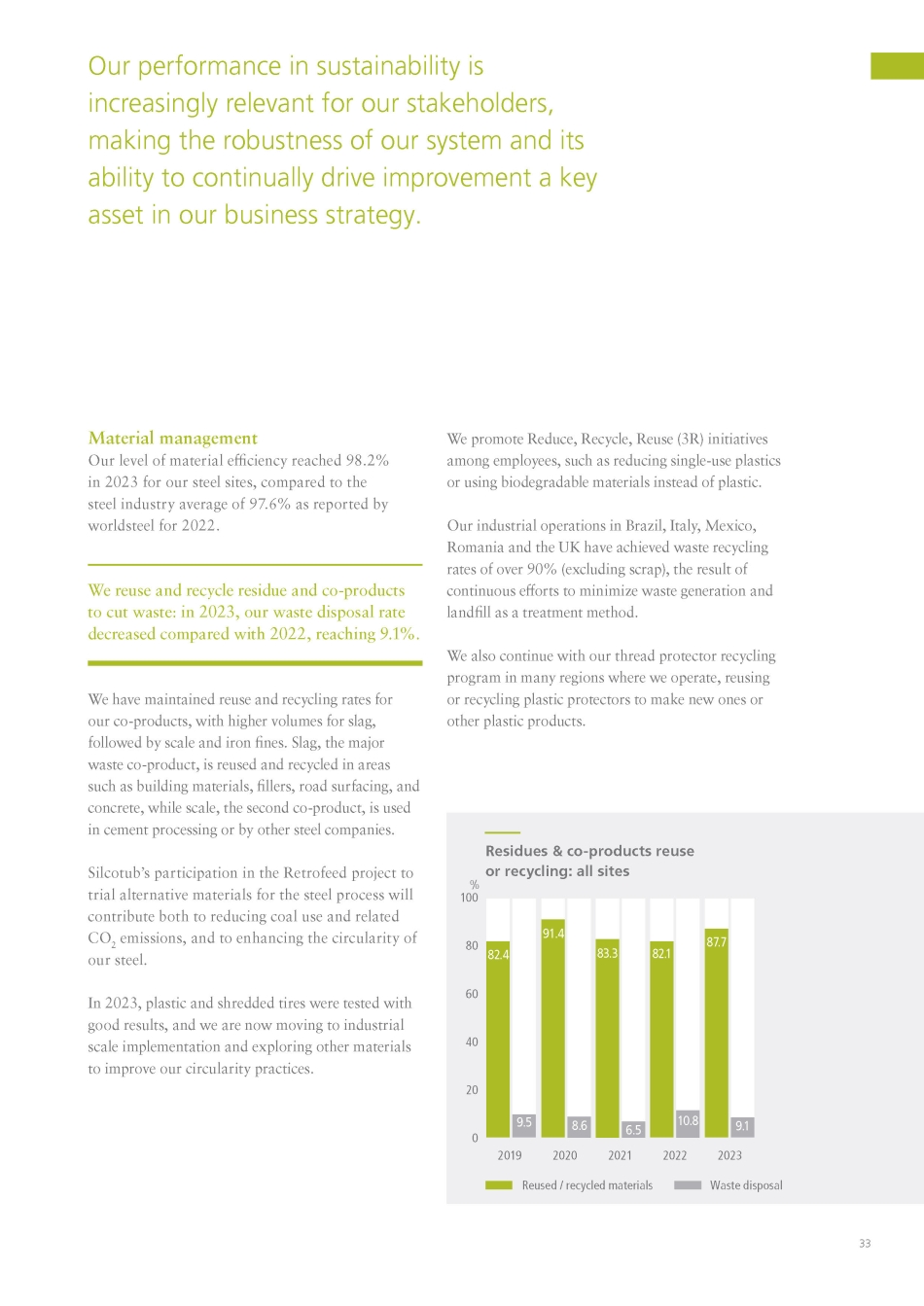
33 Reused / recycled materials Waste disposal Residues & co - products reuse or recycling: all sites 80 60 40 20 0 2019 87.7 % 100 10.8 83.3 6.5 2020 2021 2022 2023 82.4 9.5 91.4 8.6 9.1 82.1 We promote Reduce, Recycle, Reuse (3R) initiatives among employees, such as reducing single - use plastics or using biodegradable materials instead of plastic. Our industrial operations in Brazil, Italy, Mexico, Romania and the UK have achieved waste recycling rates of over 90% (excluding scrap), the result of continuous efforts to minimize waste generation and landfill as a treatment method. We also continue with our thread protector recycling program in many regions where we operate, reusing or recycling plastic protectors to make new ones or other plastic products. Material management Our level of material efficiency reached 98.2% in 2023 for our steel sites, compared to the steel industry average of 97.6% as reported by worldsteel for 2022. We reuse and recycle residue and co - products to cut waste: in 2023, our waste disposal rate decreased compared with 2022, reaching 9.1%. We have maintained reuse and recycling rates for our co - products, with higher volumes for slag, followed by scale and iron fines. Slag, the major waste co - product, is reused and recycled in areas such as building materials, fillers, road surfacing, and concrete, while scale, the second co - product, is used in cement processing or by other steel companies. Silcotub’s participation in the Retrofeed project to trial alternative materials for the steel process will contribute both to reducing coal use and related CO 2 emissions, and to enhancing the circularity of our steel. In 2023, plastic and shredded tires were tested with good results, and we are now moving to industrial scale implementation and exploring other materials to improve our circularity practices. Our performance in sustainability is increasingly relevant for our stakeholders, making the robustness of our system and its ability to continually drive improvement a key asset in our business strategy.

34 Water management Our commitment To ensure the responsible management of water resources. Our objectives • Minimize water intake, especially in water - scarce areas where we have water - intensive operations • Meet water discharge quality targets • Implement the best water - management technologies for new lines Our actions Water plays a major role in steel manufacturing processes, although little of it is consumed as most is reused or returned to source. Aware of its responsibility for managing water resources efficiently, Tenaris constantly evaluates its water conservation and reuse practices. Water intake In 2023, 78% of the water used came from surface water and 20% from subsurface; the rest from local networks. Although water withdrawal poses challenges for the steel industry, particularly where sites are in areas with high consumption or low availability, the quality of the water discharged is no less relevant. Effluent discharge quality is regularly monitored to ensure compliance with local and internal standards, with effluent type and destination determining the type of treatment. Most are secondary physical - chemical treatments for internal sewage wastewater systems, used in locations lacking adequate infrastructure. Improving water use and management We have evaluated water stress levels at our facilities, especially those with high water - use rates for seamless pipe making, rolling and heat treatment, as processes for welded pipe and finishing plants use less water. We carried out a mapping analysis of our water withdrawal locations according to the World Resources Institute’s Aqueduct global water risk mapping tool. Only 0.3% of our total water withdrawal is located in areas classified as high to extremely - high water stress areas; 0.4% is located in medium to high stress areas, and around 99% is located in low / low - to - medium areas. Most of our more intensive water - use facilities lie in areas of low or medium water stress risk, according to the Aqueduct Water Risk Atlas, and these sites currently display high recycling rates. Managing resources responsibly goes further than reducing our site water footprint. Regarding products, our Dopeless ® connections require no water for cleaning when running in the field, while a standard dope thread needs between 10 - 20 liters of water per connection. Source: Aqueduct Water risk levels across Tenaris’s locations Low to medium 90.9% Medium to high 0.4% High or Extremely high 0.3% Low 8.4%

35 Rewilding Argentina is part of the Tompkins Conservation organization, whose work in Esteros del Ibera to create a successful conservation model was ranked by the National Geographic Society as one the top seven best projects of its kind in 2020. Tenaris contributes by supplying pipes to build corrals, bridges or cages to support efforts to reintroduce local fauna such as ocelots, jaguar, giant otter and several local bird species. In the “Ciervo de los Pantanos” National Park neighboring Siderca, Tenaris has provided support for local technical school students to build sustainable domes aimed at encouraging schoolchildren to participate in the educational activities organized by the National Park. Biodiversity EVALUATING IMPACT AND CONTRIBUTING TO CONSERVATION PROJECTS Biodiversity and its connection to climate change are gaining global significance as awareness grows about the impact of business activities and climate change on plant and animal diversity. We are improving our management and governance approach to acknowledge and address the impacts on biodiversity and climate change, and conduct targeted activities in specific regions to engage with and contribute to local ecosystems. In Argentina, Tenaris signed an agreement with the Rewilding Argentina foundation in 2021 to continue working together in partnership to conserve and restore local fauna in different projects throughout Argentina. These include the Esteros del Ibera reserve in Northeast Argentina, El Impenetrable in the North, and two areas in Patagonia. Noise nuisance Several of our long - standing industrial facilities are situated near residential areas, and we recognize the potential for causing noise inconvenience to our neighbors. This environmental aspect is crucial for certain sites and is thus included in our management system. When designing new lines, we analyze the best technologies available that take noise into account, aiming to minimize indoor noise, reduce impact on our employees, and avoid undue disturbance to neighboring communities. Any complaints received are thoroughly investigated and handled as incidents in order to identify the root causes and define appropriate actions.
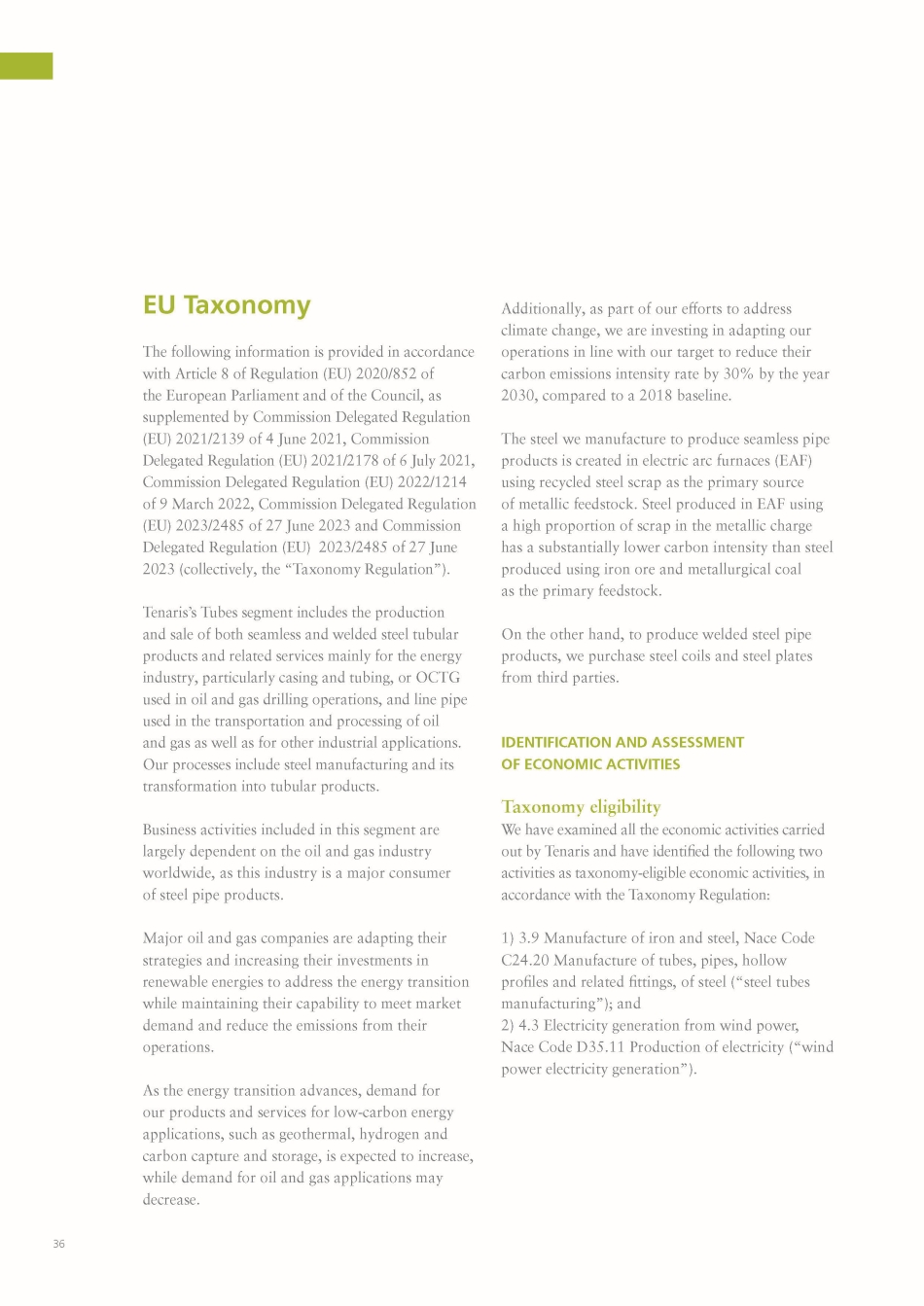
36 EU Taxonomy The following information is provided in accordance with Article 8 of Regulation (EU) 2020/852 of the European Parliament and of the Council, as supplemented by Commission Delegated Regulation (EU) 2021/2139 of 4 June 2021, Commission Delegated Regulation (EU) 2021/2178 of 6 July 2021, Commission Delegated Regulation (EU) 2022/1214 of 9 March 2022, Commission Delegated Regulation (EU) 2023/2485 of 27 June 2023 and Commission Delegated Regulation (EU) 2023/2485 of 27 June 2023 (collectively, the “Taxonomy Regulation”). Tenaris’s Tubes segment includes the production and sale of both seamless and welded steel tubular products and related services mainly for the energy industry, particularly casing and tubing, or OCTG used in oil and gas drilling operations, and line pipe used in the transportation and processing of oil and gas as well as for other industrial applications. Our processes include steel manufacturing and its transformation into tubular products. Business activities included in this segment are largely dependent on the oil and gas industry worldwide, as this industry is a major consumer of steel pipe products. Major oil and gas companies are adapting their strategies and increasing their investments in renewable energies to address the energy transition while maintaining their capability to meet market demand and reduce the emissions from their operations. As the energy transition advances, demand for our products and services for low - carbon energy applications, such as geothermal, hydrogen and carbon capture and storage, is expected to increase, while demand for oil and gas applications may decrease. Additionally, as part of our efforts to address climate change, we are investing in adapting our operations in line with our target to reduce their carbon emissions intensity rate by 30% by the year 2030, compared to a 2018 baseline. The steel we manufacture to produce seamless pipe products is created in electric arc furnaces (EAF) using recycled steel scrap as the primary source of metallic feedstock. Steel produced in EAF using a high proportion of scrap in the metallic charge has a substantially lower carbon intensity than steel produced using iron ore and metallurgical coal as the primary feedstock. On the other hand, to produce welded steel pipe products, we purchase steel coils and steel plates from third parties . IDENTIFICATION AND ASSESSMENT OF ECONOMIC ACTIVITIES Taxonomy eligibility We have examined all the economic activities carried out by Tenaris and have identified the following two activities as taxonomy - eligible economic activities, in accordance with the Taxonomy Regulation : 1) 3.9 Manufacture of iron and steel, Nace Code C24.20 Manufacture of tubes, pipes, hollow profiles and related fittings, of steel (“steel tubes manufacturing”); and 2) 4.3 Electricity generation from wind power, Nace Code D35.11 Production of electricity (“wind power electricity generation”).
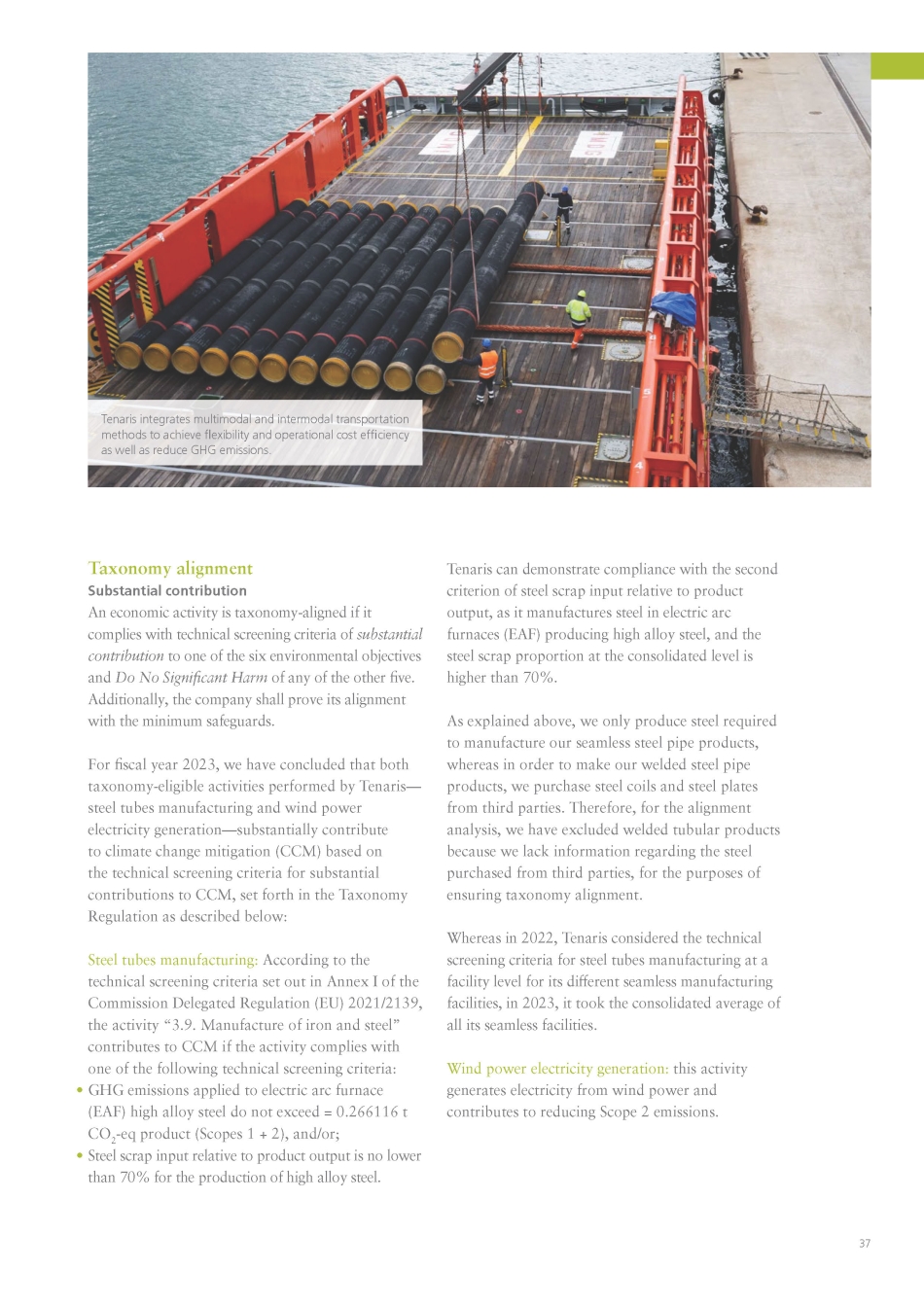
37 Tenaris can demonstrate compliance with the second criterion of steel scrap input relative to product output, as it manufactures steel in electric arc furnaces (EAF) producing high alloy steel, and the steel scrap proportion at the consolidated level is higher than 70%. As explained above, we only produce steel required to manufacture our seamless steel pipe products, whereas in order to make our welded steel pipe products, we purchase steel coils and steel plates from third parties. Therefore, for the alignment analysis, we have excluded welded tubular products because we lack information regarding the steel purchased from third parties, for the purposes of ensuring taxonomy alignment. Whereas in 2022, Tenaris considered the technical screening criteria for steel tubes manufacturing at a facility level for its different seamless manufacturing facilities, in 2023, it took the consolidated average of all its seamless facilities. Wind power electricity generation: this activity generates electricity from wind power and contributes to reducing Scope 2 emissions. Taxonomy alignment Substantial contribution An economic activity is taxonomy - aligned if it complies with technical screening criteria of substantial contribution to one of the six environmental objectives and Do No Significant Harm of any of the other five. Additionally, the company shall prove its alignment with the minimum safeguards. For fiscal year 2023, we have concluded that both taxonomy - eligible activities performed by Tenaris — steel tubes manufacturing and wind power electricity generation — substantially contribute to climate change mitigation (CCM) based on the technical screening criteria for substantial contributions to CCM, set forth in the Taxonomy Regulation as described below: Steel tubes manufacturing: According to the technical screening criteria set out in Annex I of the Commission Delegated Regulation (EU) 2021/2139, the activity “3.9. Manufacture of iron and steel” contributes to CCM if the activity complies with one of the following technical screening criteria: • GHG emissions applied to electric arc furnace (EAF) high alloy steel do not exceed = 0.266116 t CO 2 - eq product (Scopes 1 + 2), and/or; • Steel scrap input relative to product output is no lower than 70% for the production of high alloy steel. Tenaris integrates multimodal and intermodal transportation methods to achieve flexibility and operational cost efficiency as well as reduce GHG emissions .

38 Do No Significant Harm (DNSH) We have analyzed the DNSH criteria for both taxonomy - eligible activities that contribute substantially to CCM by assessing those sites where we perform those economic activities. For fiscal year 2023, we have conducted an assessment of all the DNSH criteria. The rationale for our compliance with the DNSH regarding our tubes manufacturing activities is given below. Climate change adaptation Regarding the DNSH for Climate Change Adaptation, a physical climate risk assessment was performed in 2023 in accordance with the Taxonomy Regulation. The DNSH for Climate Change Adaptation requires the company to perform a Climate Risk and Vulnerability Assessment to establish the adaptation capacity of its economic activity according to the climate scenarios defined by the IPCC up to 2050. This assessment varies in line with the lifespan of the activity according to the best available methodology for Climate Risk and Vulnerability Assessment. Risk assessment is conducted by taking into consideration exposure, climate hazards, and the vulnerability of the economic activity. Firstly, we identified the climate risks for a selection of Tenaris’s main assets in different scenarios, and for different time horizons. This part of the assessment also provided us with ratings for the different climate hazards at each location. Secondly, we selected the assets with a high level of climate hazard gravity and likelihood in accordance with climate projections and regional scenarios. For these seamless pipe manufacturing plants, which are eligible for EU Taxonomy, we performed a full Vulnerability Assessment. Thirdly, we assessed the vulnerability of these assets with regard to the climate risks identified. This resulted in a list of potential consequences arising from the climate events, and severity scores qualifying these consequences. The last step consisted of building a Risk & Vulnerability Matrix to serve as a basis to determine the need for an adaptation solution plan. Overall physical risk scores were obtained by multiplying likelihood scores (ratings) and severity scores. The Climate Risk & Vulnerability Assessment concludes that none of the sites requires an adaptation plan for any of the climate risk categories under the RCP 8.5 scenario in 2050. Indeed, the highest overall physical score is 12 (medium) for the wind risk at Tamsa. Sustainable use and protection of water and marine resources Tenaris has procedures in place covering water use and protection. These include mapping potential pollution sources, implementing maintenance programs for water treatment systems, monitoring programs and defining improvement actions depending on the criticalities identified. Water stress risk is evaluated for each location, allowing Tenaris to prioritize criticalities for different sites and establish the definition and implementation of actions to improve water management. Furthermore, 86% of our production sites are working under management systems certified according to ISO standards. Pollution prevention and control Tenaris possesses all the requisite EU and national legal authorizations indicated for the use of chemical substances, including some CMR, applicable to its manufacturing process for seamless steel pipes according to local applicable requirements. In its current formulation, Appendix C does not provide any concentration limits, except for point (a) and (b).

39 The criterion in point (g) aims to broaden the list of substances to which Appendix C potentially applies. It seeks to identify substances — whether on their own, in mixtures or making up an article — that meet the criteria outlined in Article 57 of REACH but are not yet included in the Candidate list, which makes it challenging for Tenaris to map unauthorized substances. Moreover, the requisites deemed “essential for society” or of “essential use” have no legal definition. In an official note published in December 2022, the European Commission claimed that it was drawing up a document to clarify the application of the requisite in question. However, as of the date of this report, no official document has been issued on the matter. The compliance rationale adopted by Tenaris is aligned with one of the “essential for society” criteria enshrined in the Montreal Protocol. This is the same as the one cited by the European Commission as reference, whereby all economically feasible steps have been taken to minimize the essential use and any associated emission of the controlled substance. Protection and restoration of biodiversity and ecosystems As previously explained, 86% of our production sites, including our major sites, are working under management systems certified according to ISO standards. Main sites were evaluated to determine if they are located within key biodiversity areas. Our analysis showed that none of our major sites, including steel processing and/or rolling mills lie within these areas. Similarly, the wind farm meets the different DNSH criteria. As it is located onshore, Tenaris is not required to perform any assessment with regard to water protection. In terms of the circular economy objective, the wind turbines components are durable and resistant, and their output has a material efficiency of 90%. The components of the wind turbines are also highly recyclable. Finally, the wind farm is not located in or near any key biodiversity area, and therefore does not require any specific assessment. However, this aspect is included in the local environmental permits for the wind farm. Minimum Safeguards (MS) The final step for determining taxonomy alignment is compliance with minimum safeguards to ensure that the company has adopted procedures implemented to ensure the alignment with the OECD Guidelines for Multinational Enterprises and the Climate Risk & Vulnerability Matrix Wind farm Calarasi Sault Ste Marie Siderca Bay City Tamsa 1 1 1 3 2 1 Flooding 4 4 6 3 6 12 Wind 2 3 4 3 6 4 Heat waves and extreme temperature 2 4 1 6 6 6 Extreme precipitation 1 2 1 1 1 1 Drought 1 1 1 1 2 1 Wildfire Severity Likelihood 5 4 3 2 1 5 4 3 2 1 1 10 8 6 4 2 2 15 12 9 6 3 3 20 16 12 8 4 4 25 20 15 10 5 5 Score Risk Rating 1 - 5 Very Low 6 - 10 Low 11 - 15 Medium 16 - 20 High 21 - 25 Very High to Extremely High
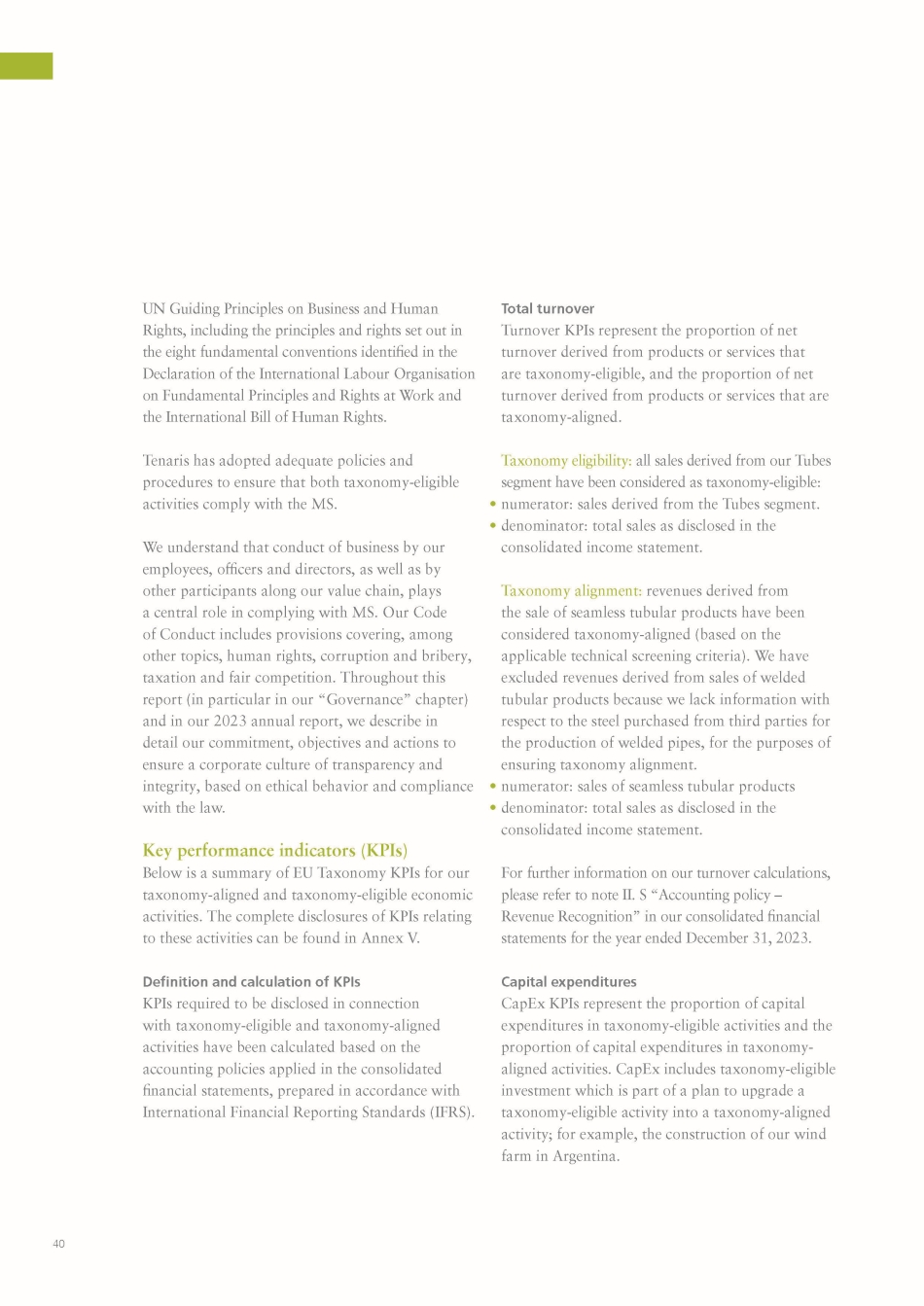
40 UN Guiding Principles on Business and Human Rights, including the principles and rights set out in the eight fundamental conventions identified in the Declaration of the International Labour Organisation on Fundamental Principles and Rights at Work and the International Bill of Human Rights. Tenaris has adopted adequate policies and procedures to ensure that both taxonomy - eligible activities comply with the MS. We understand that conduct of business by our employees, officers and directors, as well as by other participants along our value chain, plays a central role in complying with MS. Our Code of Conduct includes provisions covering, among other topics, human rights, corruption and bribery, taxation and fair competition. Throughout this report (in particular in our “Governance” chapter) and in our 2023 annual report, we describe in detail our commitment, objectives and actions to ensure a corporate culture of transparency and integrity, based on ethical behavior and compliance with the law. Key performance indicators (KPIs) Below is a summary of EU Taxonomy KPIs for our taxonomy - aligned and taxonomy - eligible economic activities . The complete disclosures of KPIs relating to these activities can be found in Annex V . Definition and calculation of KPIs KPIs required to be disclosed in connection with taxonomy - eligible and taxonomy - aligned activities have been calculated based on the accounting policies applied in the consolidated financial statements, prepared in accordance with International Financial Reporting Standards (IFRS). Total turnover Turnover KPIs represent the proportion of net turnover derived from products or services that are taxonomy - eligible, and the proportion of net turnover derived from products or services that are taxonomy - aligned. Taxonomy eligibility: all sales derived from our Tubes segment have been considered as taxonomy - eligible: • numerator: sales derived from the Tubes segment. • denominator: total sales as disclosed in the consolidated income statement. Taxonomy alignment: revenues derived from the sale of seamless tubular products have been considered taxonomy - aligned (based on the applicable technical screening criteria). We have excluded revenues derived from sales of welded tubular products because we lack information with respect to the steel purchased from third parties for the production of welded pipes, for the purposes of ensuring taxonomy alignment . • numerator: sales of seamless tubular products • denominator: total sales as disclosed in the consolidated income statement. For further information on our turnover calculations, please refer to note II. S “Accounting policy – Revenue Recognition” in our consolidated financial statements for the year ended December 31, 2023. Capital expenditures CapEx KPIs represent the proportion of capital expenditures in taxonomy - eligible activities and the proportion of capital expenditures in taxonomy - aligned activities. CapEx includes taxonomy - eligible investment which is part of a plan to upgrade a taxonomy - eligible activity into a taxonomy - aligned activity; for example, the construction of our wind farm in Argentina.
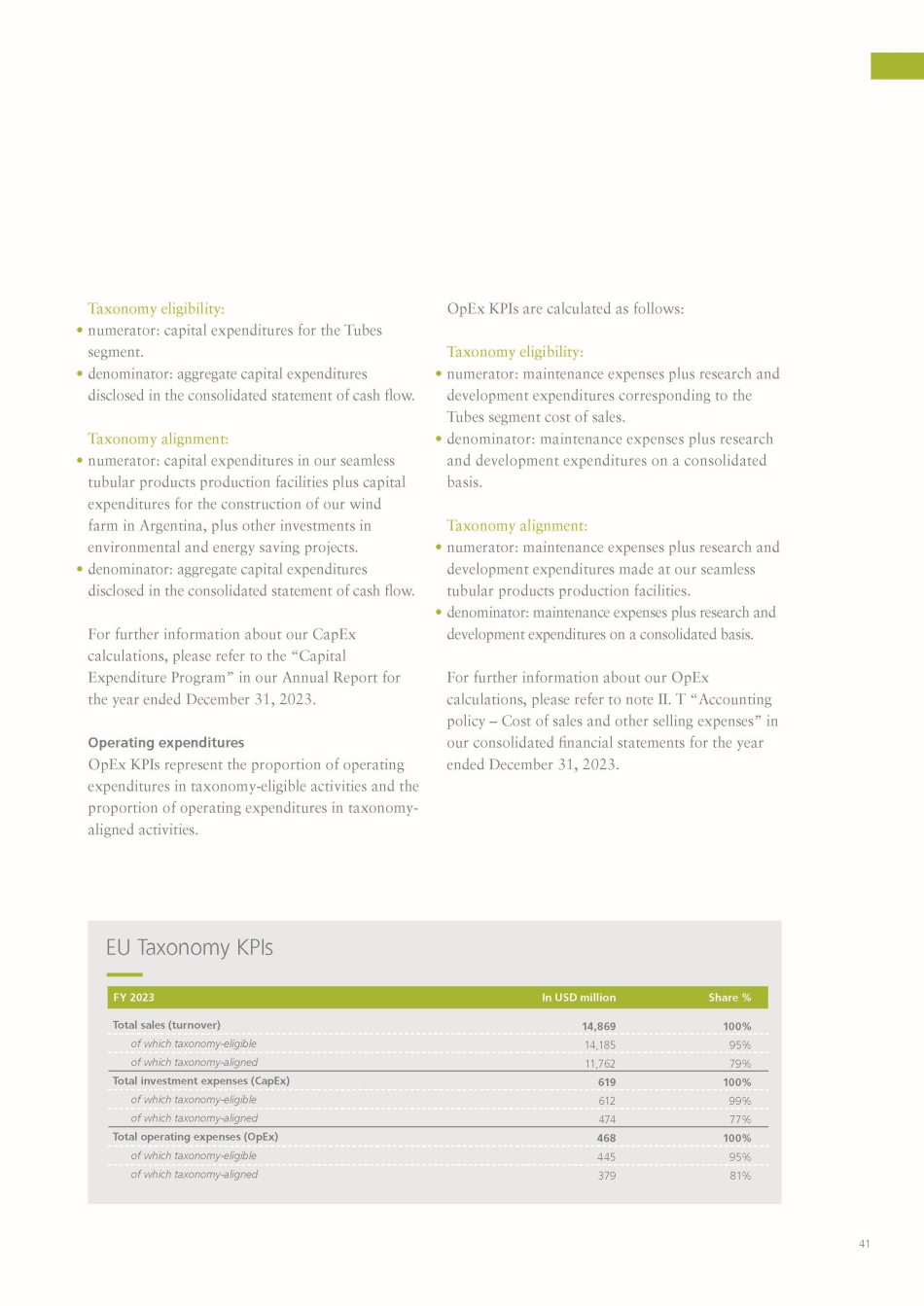
41 Taxonomy eligibility: • numerator: capital expenditures for the Tubes segment. • denominator: aggregate capital expenditures disclosed in the consolidated statement of cash flow. Taxonomy alignment: • numerator: capital expenditures in our seamless tubular products production facilities plus capital expenditures for the construction of our wind farm in Argentina, plus other investments in environmental and energy saving projects. • denominator: aggregate capital expenditures disclosed in the consolidated statement of cash flow. For further information about our CapEx calculations, please refer to the “Capital Expenditure Program” in our Annual Report for the year ended December 31, 2023. Operating expenditures OpEx KPIs represent the proportion of operating expenditures in taxonomy - eligible activities and the proportion of operating expenditures in taxonomy - aligned activities. OpEx KPIs are calculated as follows: Taxonomy eligibility: • numerator: maintenance expenses plus research and development expenditures corresponding to the Tubes segment cost of sales. • denominator: maintenance expenses plus research and development expenditures on a consolidated basis. Taxonomy alignment: • numerator: maintenance expenses plus research and development expenditures made at our seamless tubular products production facilities. • denominator: maintenance expenses plus research and development expenditures on a consolidated basis. For further information about our OpEx calculations, please refer to note II. T “Accounting policy – Cost of sales and other selling expenses” in our consolidated financial statements for the year ended December 31, 2023. EU Taxonomy KPIs Share % In USD million FY 2023 100% 14,869 Total sales (turnover) 95% 14,185 of which taxonomy - eligible 79% 11,762 of which taxonomy - aligned 100% 619 Total investment expenses (CapEx) 99% 612 of which taxonomy - eligible 77% 474 of which taxonomy - aligned 100% 468 Total operating expenses (OpEx) 95% 445 of which taxonomy - eligible 81% 379 of which taxonomy - aligned
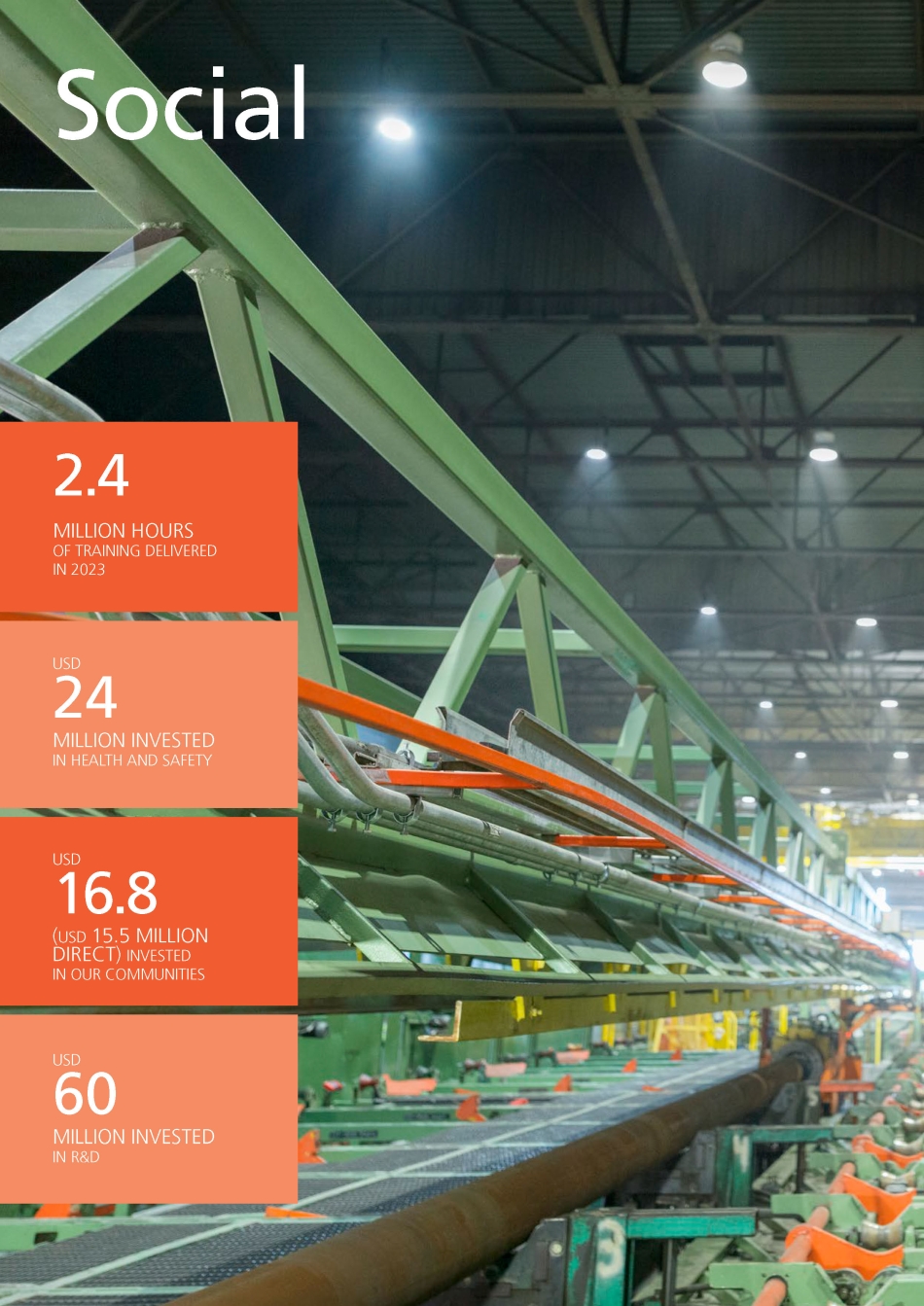
42 Social 2 .4 MILLION HOURS OF TRAINING DELIVERED IN 2023 USD 24 MILLION INVESTED IN HEALTH AND SAFETY USD 16 .8 ( USD 15.5 MILLION DIRECT) INVESTED IN OUR COMMUNITIES USD 60 MILLION INVESTED IN R&D

43 Contents Human Capital . . . . . . . . . . . . . . . . . . . . . . 44 Health & Safety . . . . . . . . . . . . . . . . . . . . . 52 Community Relations . . . . . . . . . . . . . . . . 60 Innovation & the Value Chain . . . . . . . . . 66
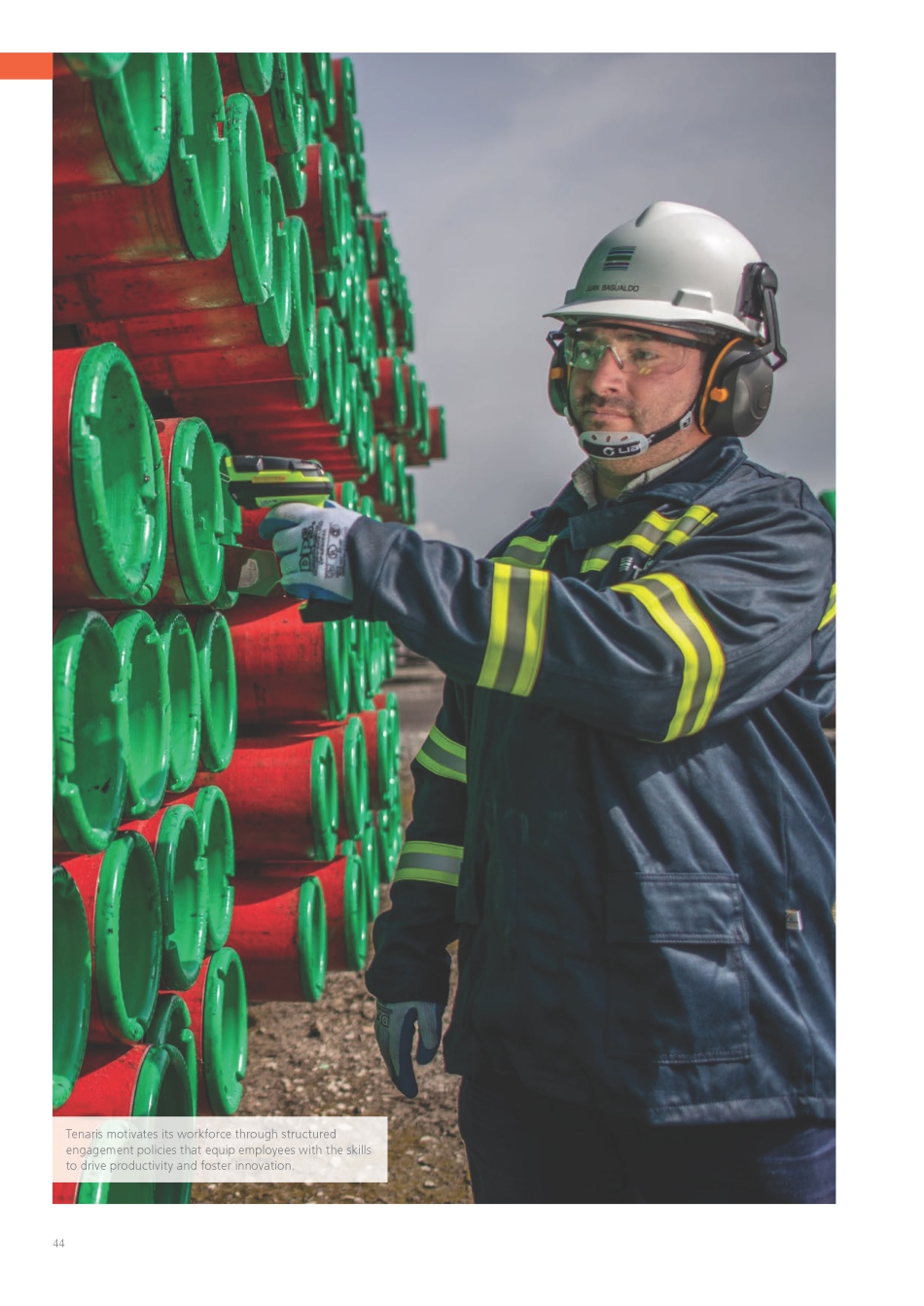
44 Tenaris motivates its workforce through structured engagement policies that equip employees with the skills to drive productivity and foster innovation.
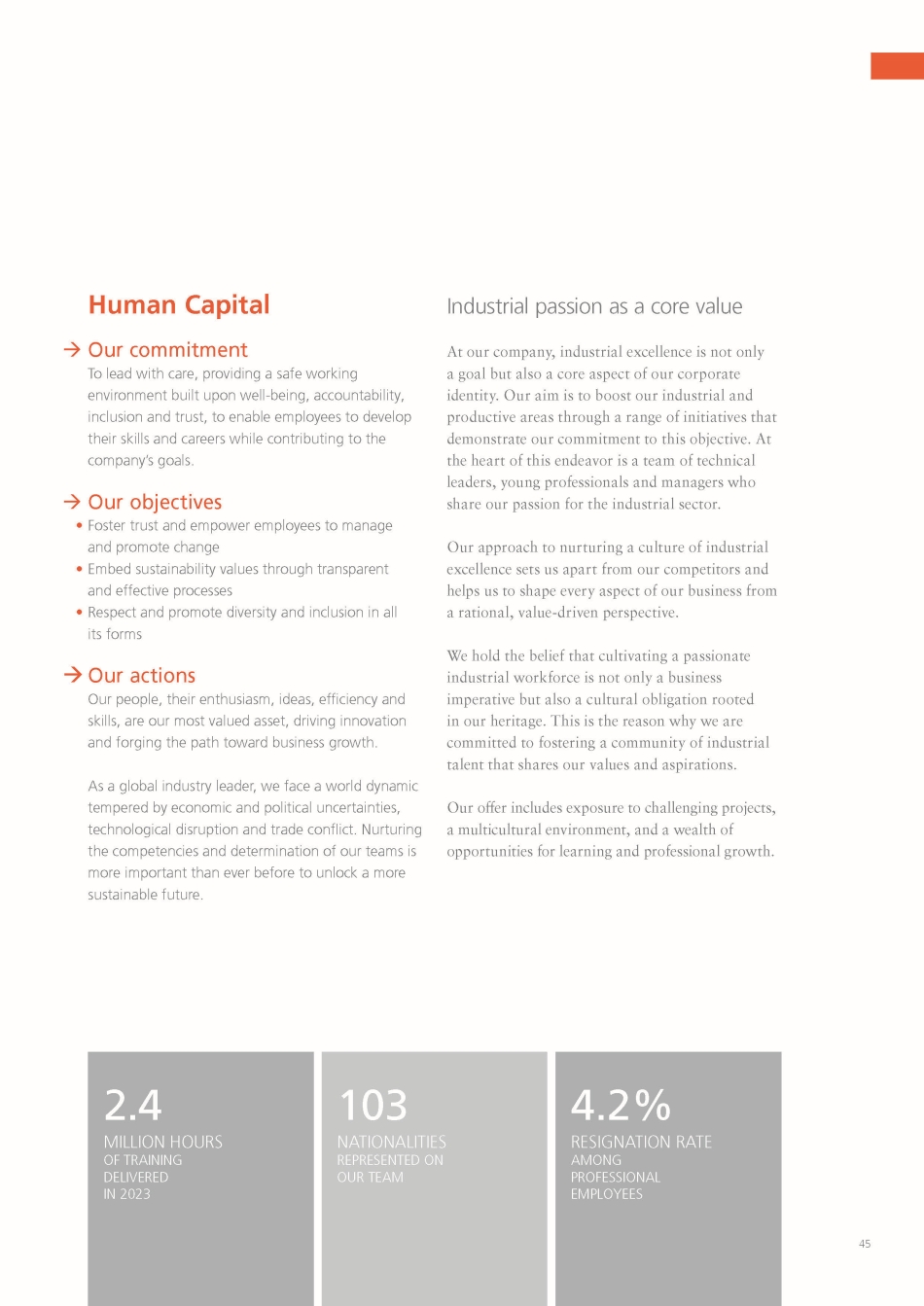
45 Human Capital Our commitment To lead with care, providing a safe working environment built upon well - being, accountability, inclusion and trust, to enable employees to develop their skills and careers while contributing to the company’s goals. Our objectives • Foster trust and empower employees to manage and promote change • Embed sustainability values through transparent and effective processes • Respect and promote diversity and inclusion in all its forms Our actions Our people, their enthusiasm, ideas, efficiency and skills, are our most valued asset, driving innovation and forging the path toward business growth . As a global industry leader, we face a world dynamic tempered by economic and political uncertainties, technological disruption and trade conflict. Nurturing the competencies and determination of our teams is more important than ever before to unlock a more sustainable future. Industrial passion as a core value At our company, industrial excellence is not only a goal but also a core aspect of our corporate identity. Our aim is to boost our industrial and productive areas through a range of initiatives that demonstrate our commitment to this objective. At the heart of this endeavor is a team of technical leaders, young professionals and managers who share our passion for the industrial sector. Our approach to nurturing a culture of industrial excellence sets us apart from our competitors and helps us to shape every aspect of our business from a rational, value - driven perspective. We hold the belief that cultivating a passionate industrial workforce is not only a business imperative but also a cultural obligation rooted in our heritage. This is the reason why we are committed to fostering a community of industrial talent that shares our values and aspirations. Our offer includes exposure to challenging projects, a multicultural environment, and a wealth of opportunities for learning and professional growth. 2 .4 MILLION HOURS OF TRAINING DELIVERED IN 2023 103 NATIONALITIES REPRESENTED ON OUR TEAM 4 .2% RESIGNATION RATE AMONG PROFESSIONAL EMPLOYEES
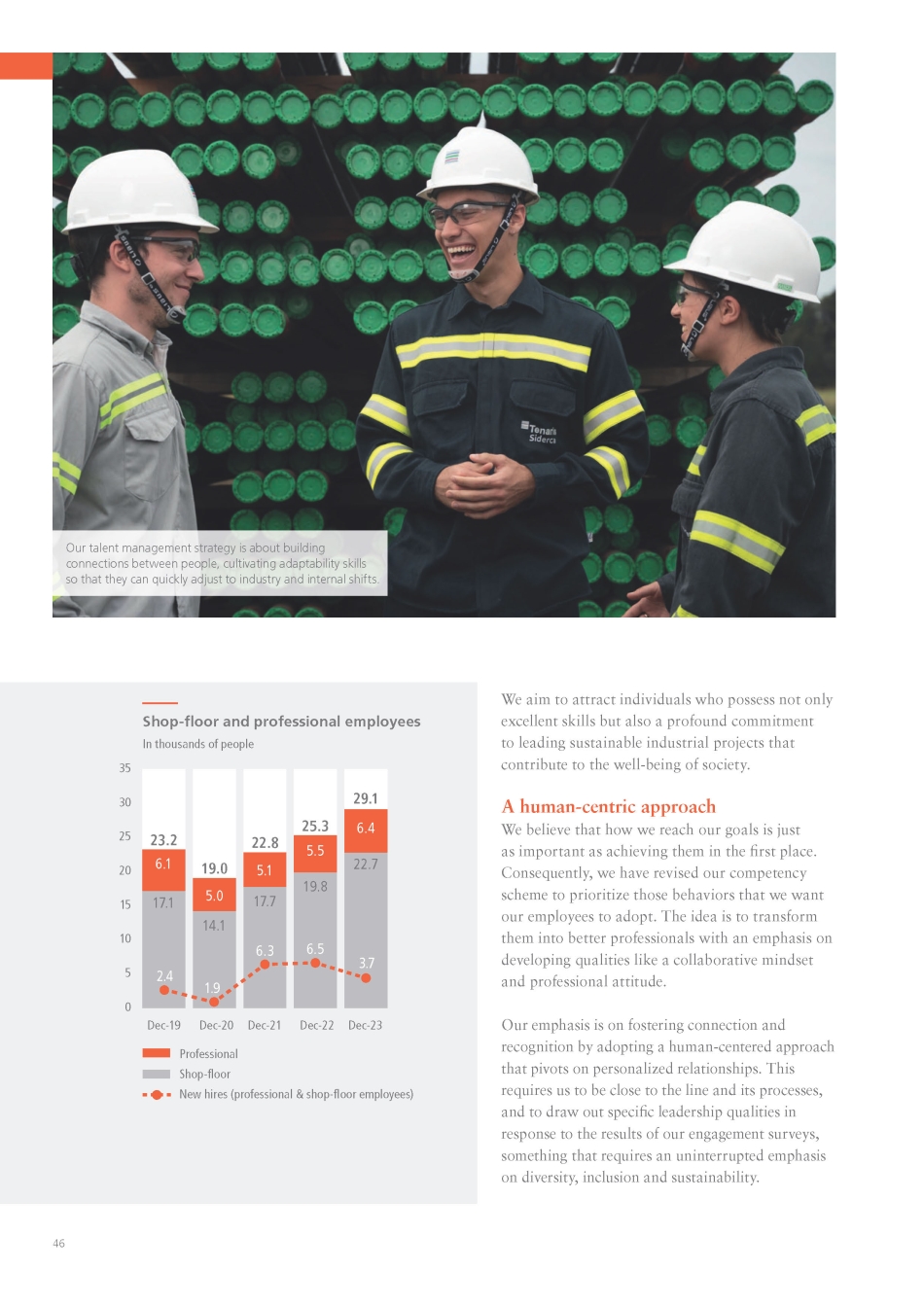
46 17.1 23.2 6.1 2.4 19.0 5.0 14.1 1.9 22.8 5.1 17.7 6.3 19.8 6.5 We aim to attract individuals who possess not only excellent skills but also a profound commitment to leading sustainable industrial projects that contribute to the well - being of society. A human - centric approach We believe that how we reach our goals is just as important as achieving them in the first place. Consequently, we have revised our competency scheme to prioritize those behaviors that we want our employees to adopt. The idea is to transform them into better professionals with an emphasis on developing qualities like a collaborative mindset and professional attitude. Our emphasis is on fostering connection and recognition by adopting a human - centered approach that pivots on personalized relationships. This requires us to be close to the line and its processes, and to draw out specific leadership qualities in response to the results of our engagement surveys, something that requires an uninterrupted emphasis on diversity, inclusion and sustainability. Shop - floor and professional employees In thousands of people 35 30 25 20 15 10 5 0 22.7 29.1 25.3 6.4 5.5 3.7 Dec - 19 Dec - 20 Dec - 21 Dec - 22 Dec - 23 Professional Shop - floor New hires (professional & shop - floor employees) Our talent management strategy is about building connections between people, cultivating adaptability skills so that they can quickly adjust to industry and internal shifts.

47 Our workforce: steady expansion During 2023, our headcount increased by 3,842, a rise driven by two major acquisitions. In December, we incorporated Mattr’s pipe coating business unit (Shawcor) to complement Tenaris's product and services offer, thus expanding our presence worldwide. Featuring an additional nine coating mills and two R&D centers, the acquisition increased our workforce by nearly 2,800 employees, mostly in Indonesia and Mexico, but also in Canada, the U.S., Norway and the UAE. We also completed the acquisition of Global Pipe Company (GPC), a welded tubes producer in Saudi Arabia, adding ~400 employees to our headcount. After two years of higher - than - usual resignations, in 2023, the rate for professional employees went down from 6.2% to 4.2%. Overall, the resignation rate also decreased from 6.2% to 5.0%. New talent attraction drive As the dynamics of attracting top talent continue to shift, driven by evolving candidate preferences and market demands, we are seeing a distinct trend towards prioritizing emotional fulfilment over transactional engagements. This has led to a widespread shortage of talent, notably within our industry, compelling us to devise novel strategies to meet expectations and ensure we attract, engage and retain the human and professional skills needed. As a global company, we know that our career development and rotation prospects are an attractive differential for both industrial and administrative profiles. Our value proposition for candidates is further enhanced with career development and growth opportunities that include international assignments and business travel. Today, the dynamic nature of our business requires us to talk in terms of project functions and experiences rather than adhering to static job descriptions. At the same time, the sense of belonging to a community and culture with a significant geographical and cultural presence is a value that is much appreciated by all those who choose to pursue a career with us. As a global company, we can offer candidates clear career progression paths, mentorship programs, and continuous learning opportunities with experience abroad. Professional employee resignation rate 2019 2020 2021 2022 2023 6.9 4.7 4.5 6.2 % 10 9 8 7 6 5 4 3 2 1 0 4.2

48 Training people to be the best We believe that when you grow as a professional, you grow as a person. Our main goal is to support our employees on their path to becoming the best version of themselves. We are continuously refining opportunities and tools for Tenaris employees to grow and fulfill their potential, including partnerships with centers of educational excellence, such as Rice University in Houston or IMD in Switzerland. We offer high quality job - specific training programs that are learner - centric, allowing employees to train at their own pace and from anywhere. Our partnership with the Degreed learning platform enables users to learn, develop and measure their skills in line with the latest trends. Revamped over the last couple of years to combine recent developments in learning with technology, our global management programs now offer participants new and more effective ways of networking. The programs also incorporate the values of peer learning communities to promote a better understanding of course material and foster the development of practical and softer skills. • TenarisUniversity Induction Camp (TUIC) • Management Development Program (MDP) • Advanced Management Program (AMP) • Leadership Program (LP) • Business Acumen Program (BA) • Management Essentials Program (ME) Our programs offer a broad - based, structured range of management training, featuring participation from prominent business schools, with particular application to our industry. Employee participation in Global Management Programs Participants per course ME BA LP AMP MDP TUIC Year 39 52 105 183 2019 85 30 - - 49 - 2020 83 36 86 2021 77 33 42 - 96 162 2022 110 32 - 54 109 209 2023 TUIC: TenarisUniversity Induction Camp MDP: Management Development Program AMP: Advanced Management Program LP: Leadership Program BA: Business Acumen Program ME: Management Essentials Program Total training hours 150 120 90 60 30 0 2019 2020 2021 2022 2023 Per professional employee Per shop - floor employee (including on - the - job training) Per shop - floor employee (excluding on - the - job training) 57 46 122 35 36 111 37 68 22 34 46 144 37 39 105

49 Peer - to - peer learning is an opportunity to promote cross - functional relationships, allowing employees to explore different ways of growing in the organization. Growing the knowledge ecosystem As knowledge is one of our most important assets, we are building a network of collaborative learning by sharing our people ʼ s expertise with the rest of the organization and encouraging them to upskill. One example is the Citizen Development Program (CDP), part of Tenaris ʼ s strategy to drive digital transformation. Employees with no prior IT experience are encouraged to create and customize digital solutions that respond to specific needs they have identified themselves. These solutions also aim to improve overall process efficiency by using IT - approved low code/no code (LCNC) platforms. Opening the door to young talent As a strategic initiative, the Global Trainee Program (GTP) aims to cultivate the next generation of leaders by providing training in technical and soft skills. It includes structured rotation across various roles, exposure to industrial scenarios, and mentorship. Mindful of the need to stay current with the shifting landscape of training content for the GTP, TenarisUniversity is expanding the digital mindset and embracing new technologies. The idea is to improve processes, achieve greater efficiency, and reduce transactional tasks. Following a major influx of candidates we ended 2023 with over 500 Global Trainees, mostly with an industrial profile from regional universities. 350 300 250 200 150 100 50 2023 2022 2021 2020 2019 0 251 316 219 54 161 120 103 85 196 50 148 134 111 18 36 GT new hires Female Male

50 On the same footing For Tenaris, workplace diversity is one of the foundational pillars of a positive company culture, contributing to increased productivity, higher employee retention, and overall job satisfaction. A diverse mix of ages, abilities and nationalities, as well as a dedicated effort to advance gender equality throughout the organization, have set the course for inclusion at all levels. Integral to our talent management strategy is the commitment to maintaining a substantial percentage of local staff at each of our locations. On average, we aim for 83% of employees to be native to the respective country. We continue with our efforts to improve the gender balance, focusing on attracting more women to our GT and entry - level programs, as well as our corporate internships. Our goal here is to achieve a gender balance with an equal representation of women and men. As a company that prioritizes internal growth, we have implemented a range of internal programs to foster the development of our female talent, which include long - term career planning and support. Tenaris is introducing initiatives to support the development of female employees, balancing long - term career guidance with ongoing assistance to help them progress in their careers. Employees by nationality Senior managers by nationality 27% 7,850 Mexican 22% 6,462 Argentine 3,057 11% U.S. 2,145 7% Italian 1,911 7% Romanian 1,557 5% Indonesian 1,509 5% Brazilian 1,156 4% Colombian 1,107 4% Canadian 2,380 8% Others 37% Argentine Mexican 16% Italian 15% Other Indonesian 1% 10% Canadian 2% Colombian 3% Brazilian 5% Romanian 5% U .S . 6%
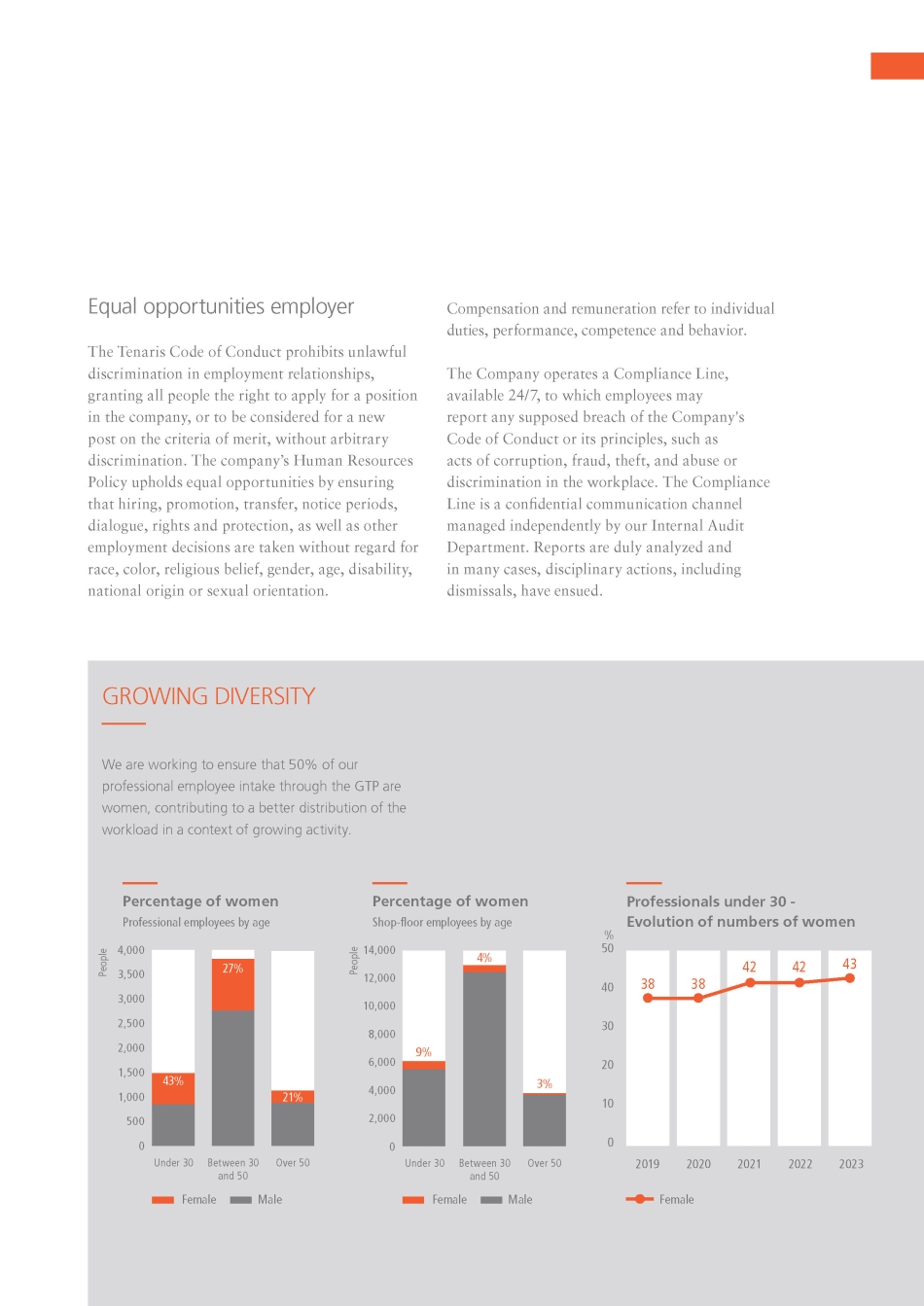
51 Equal opportunities employer The Tenaris Code of Conduct prohibits unlawful discrimination in employment relationships, granting all people the right to apply for a position in the company, or to be considered for a new post on the criteria of merit, without arbitrary discrimination. The company’s Human Resources Policy upholds equal opportunities by ensuring that hiring, promotion, transfer, notice periods, dialogue, rights and protection, as well as other employment decisions are taken without regard for race, color, religious belief, gender, age, disability, national origin or sexual orientation. Compensation and remuneration refer to individual duties, performance, competence and behavior. The Company operates a Compliance Line, available 24/7, to which employees may report any supposed breach of the Company's Code of Conduct or its principles, such as acts of corruption, fraud, theft, and abuse or discrimination in the workplace. The Compliance Line is a confidential communication channel managed independently by our Internal Audit Department. Reports are duly analyzed and in many cases, disciplinary actions, including dismissals, have ensued. GROWING DIVERSITY We are working to ensure that 50% of our professional employee intake through the GTP are women, contributing to a better distribution of the workload in a context of growing activity. Percentage of women Professional employees by age 4,000 3,500 3,000 2,500 2,000 1,500 1,000 500 0 21% People Under 30 Between 30 Over 50 and 50 Female Male 27% Female Male Percentage of women Shop - floor employees by age 14,000 12,000 10,000 8,000 6,000 4,000 2,000 0 Over 50 3% People Under 30 Between 30 and 50 4% Female Professionals under 30 - Evolution of numbers of women 40 30 20 10 0 2019 2020 2021 2022 2023 42 42 43 38 38 % 50 9% 43%

52 Creating and maintaining a workplace culture able to guarantee the health, safety and well - being of our employees is a top priority for Tenaris.
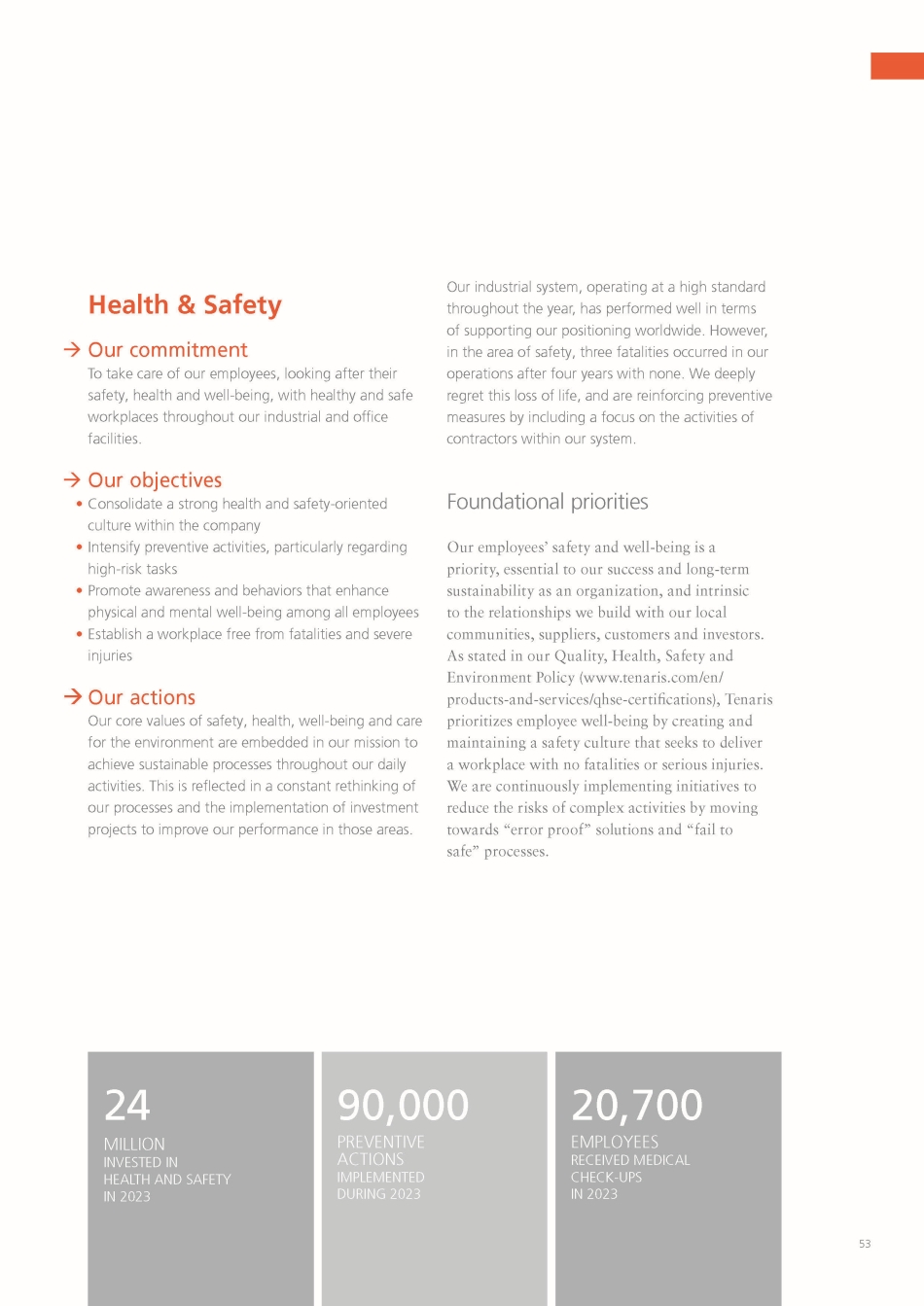
53 Health & Safety Our commitment To take care of our employees, looking after their safety, health and well - being, with healthy and safe workplaces throughout our industrial and office facilities. Our objectives • Consolidate a strong health and safety - oriented culture within the company • Intensify preventive activities, particularly regarding high - risk tasks • Promote awareness and behaviors that enhance physical and mental well - being among all employees • Establish a workplace free from fatalities and severe injuries Our actions Our core values of safety, health, well - being and care for the environment are embedded in our mission to achieve sustainable processes throughout our daily activities. This is reflected in a constant rethinking of our processes and the implementation of investment projects to improve our performance in those areas. Our industrial system, operating at a high standard throughout the year, has performed well in terms of supporting our positioning worldwide. However, in the area of safety, three fatalities occurred in our operations after four years with none. We deeply regret this loss of life, and are reinforcing preventive measures by including a focus on the activities of contractors within our system. Foundational priorities Our employees’ safety and well - being is a priority, essential to our success and long - term sustainability as an organization, and intrinsic to the relationships we build with our local communities, suppliers, customers and investors. As stated in our Quality, Health, Safety and Environment Policy ( www.tenaris.com/en/ products - and - services/qhse - certifications ), Tenaris prioritizes employee well - being by creating and maintaining a safety culture that seeks to deliver a workplace with no fatalities or serious injuries. We are continuously implementing initiatives to reduce the risks of complex activities by moving towards “error proof” solutions and “fail to safe” processes. 24 MILLION INVESTED IN HEALTH AND SAFETY IN 2023 90,000 PREVENTIVE ACTIONS IMPLEMENTED DURING 2023 20,700 EMPLOYEES RECEIVED MEDICAL CHECK - UPS IN 2023
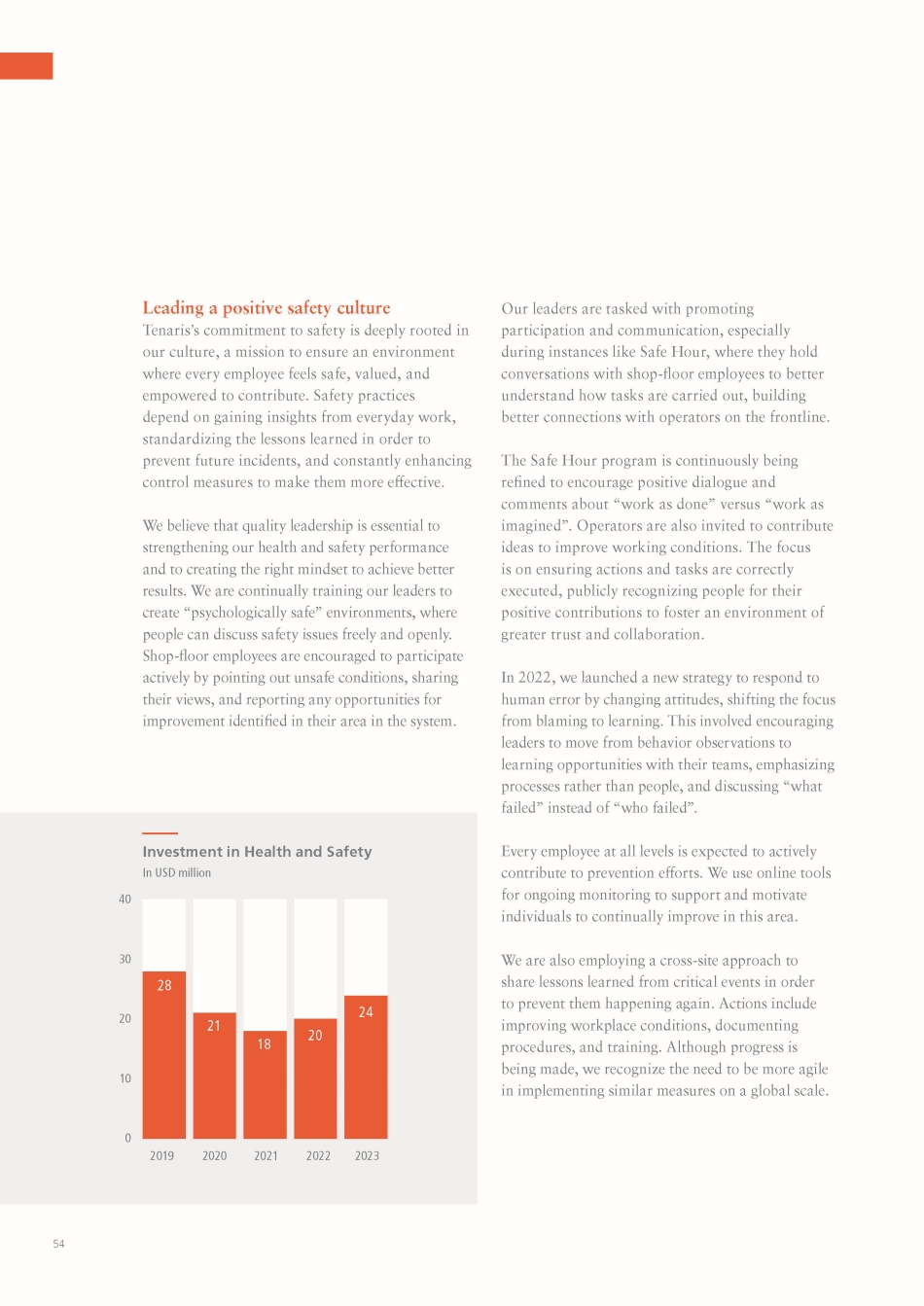
54 Leading a positive safety culture Tenaris’s commitment to safety is deeply rooted in our culture, a mission to ensure an environment where every employee feels safe, valued, and empowered to contribute. Safety practices depend on gaining insights from everyday work, standardizing the lessons learned in order to prevent future incidents, and constantly enhancing control measures to make them more effective. We believe that quality leadership is essential to strengthening our health and safety performance and to creating the right mindset to achieve better results. We are continually training our leaders to create “psychologically safe” environments, where people can discuss safety issues freely and openly. Shop - floor employees are encouraged to participate actively by pointing out unsafe conditions, sharing their views, and reporting any opportunities for improvement identified in their area in the system. Our leaders are tasked with promoting participation and communication, especially during instances like Safe Hour, where they hold conversations with shop - floor employees to better understand how tasks are carried out, building better connections with operators on the frontline. The Safe Hour program is continuously being refined to encourage positive dialogue and comments about “work as done” versus “work as imagined”. Operators are also invited to contribute ideas to improve working conditions. The focus is on ensuring actions and tasks are correctly executed, publicly recognizing people for their positive contributions to foster an environment of greater trust and collaboration. In 2022, we launched a new strategy to respond to human error by changing attitudes, shifting the focus from blaming to learning. This involved encouraging leaders to move from behavior observations to learning opportunities with their teams, emphasizing processes rather than people, and discussing “what failed” instead of “who failed”. Every employee at all levels is expected to actively contribute to prevention efforts. We use online tools for ongoing monitoring to support and motivate individuals to continually improve in this area. We are also employing a cross - site approach to share lessons learned from critical events in order to prevent them happening again. Actions include improving workplace conditions, documenting procedures, and training. Although progress is being made, we recognize the need to be more agile in implementing similar measures on a global scale. Investment in Health and Safety In USD million 40 30 20 10 0 2019 2020 2021 2022 2023 18 28 21 20 24

55 Leveraging training and communications Putting safety at the heart of industrial growth and transformation involves substantial investment in training and communications. We believe everyone can help to prevent accidents and incidents and contribute to a culture of excellence and responsibility. Recognizing the crucial role played by supervisors and managers in growing a safety culture, we are now training leaders in Human and Organizational Performance (HOP) to improve risk mitigation strategies and strengthen fail - safe capabilities. Through webinars held initially for leaders in the U.S., Mexico and Italy, the idea is to integrate HOP principles into preventive activities. The HOP approach centers on people and their roles, working with shop - floor employees who are closest to the potential risks to design and test risk controls. This line of action enhances our understanding of how individuals perform their jobs. The end - game is to build systems that are error - proof, taking into account human error. We are also targeting shift leaders whose role in setting an example and transmitting knowledge is crucial to our safety strategy . In 2022 , we restructured our health and safety course portfolio into a three - year plan targeting the full spectrum of leaders, from novices to veterans needing refresher courses. By end - 2023, 90% of shift leaders had completed the first year of training, including topics such as their role in HSE, risk assessment and safety event investigation. Injury frequency rates 6 5 4 3 2 1 0 2019 2020 2021 2022 2023 Injury frequency rate Lost time injury frequency rate Major injury frequency rate Methodology: Number of injuries per million hours worked 3.2 1.2 0.53 2.8 3.1 3.1 3.4 1.1 1.1 1.0 0.47 0.9 0.33 0.27 0.26 TIFR and Opportunities 12 10 8 4 2 0 2019 2020 2021 2022 2023 Total Injury Frecuency Rate Opportunities rate 2.0 6 1.7 2.0 6.5 6.5 8.4 6.0 2.5 3.0 2.5 2.0 1.5 1 0.5 0 TIFR Opportunities 2.6 6.3
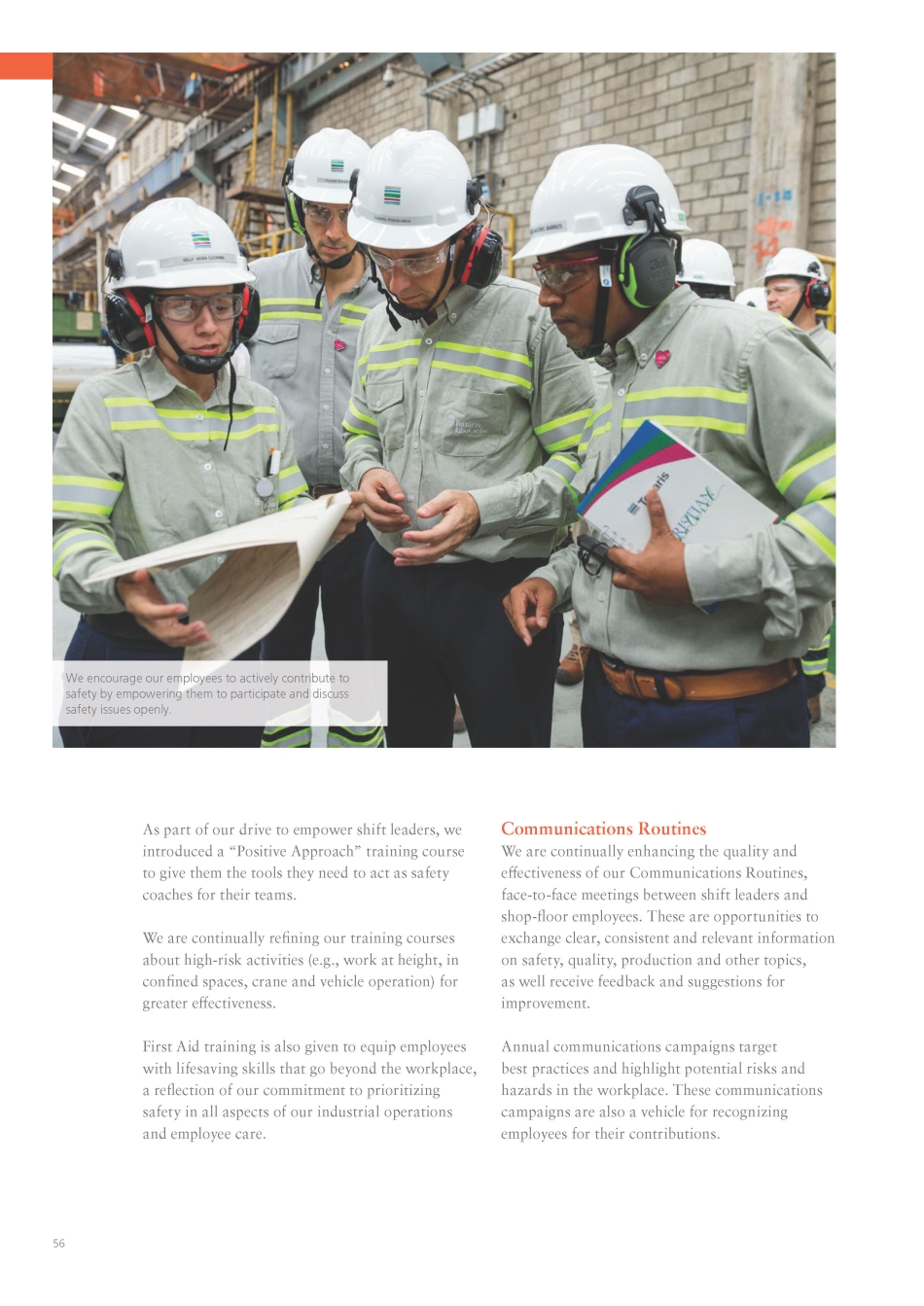
56 As part of our drive to empower shift leaders, we introduced a “Positive Approach” training course to give them the tools they need to act as safety coaches for their teams. We are continually refining our training courses about high - risk activities (e . g . , work at height, in confined spaces, crane and vehicle operation) for greater effectiveness . First Aid training is also given to equip employees with lifesaving skills that go beyond the workplace, a reflection of our commitment to prioritizing safety in all aspects of our industrial operations and employee care. Communications Routines We are continually enhancing the quality and effectiveness of our Communications Routines, face - to - face meetings between shift leaders and shop - floor employees. These are opportunities to exchange clear, consistent and relevant information on safety, quality, production and other topics, as well receive feedback and suggestions for improvement. Annual communications campaigns target best practices and highlight potential risks and hazards in the workplace. These communications campaigns are also a vehicle for recognizing employees for their contributions. We encourage our employees to actively contribute to safety by empowering them to participate and discuss safety issues openly .
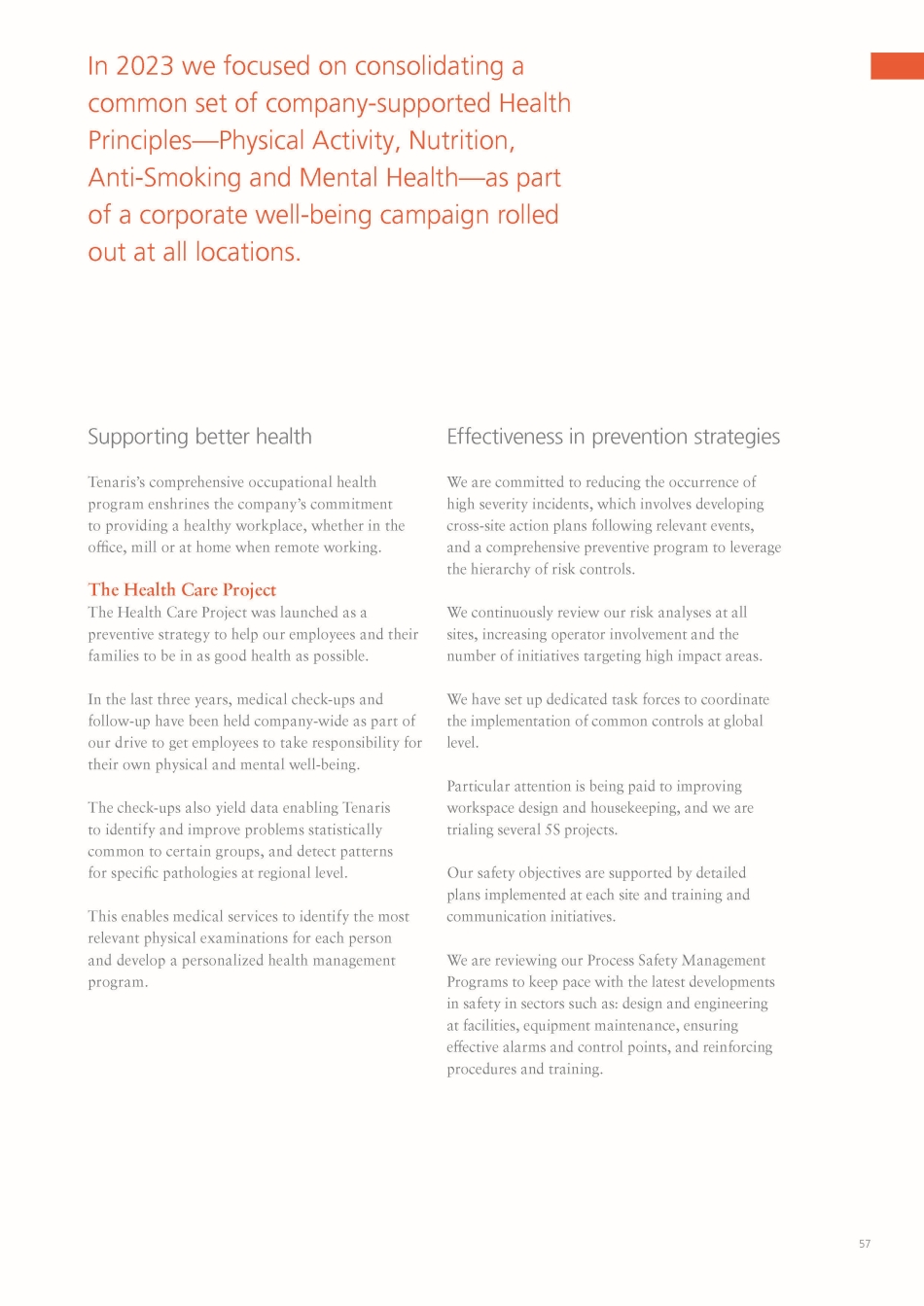
57 Supporting better health Tenaris’s comprehensive occupational health program enshrines the company’s commitment to providing a healthy workplace, whether in the office, mill or at home when remote working. The Health Care Project The Health Care Project was launched as a preventive strategy to help our employees and their families to be in as good health as possible. In the last three years, medical check - ups and follow - up have been held company - wide as part of our drive to get employees to take responsibility for their own physical and mental well - being. The check - ups also yield data enabling Tenaris to identify and improve problems statistically common to certain groups, and detect patterns for specific pathologies at regional level. This enables medical services to identify the most relevant physical examinations for each person and develop a personalized health management program. Effectiveness in prevention strategies We are committed to reducing the occurrence of high severity incidents, which involves developing cross - site action plans following relevant events, and a comprehensive preventive program to leverage the hierarchy of risk controls. We continuously review our risk analyses at all sites, increasing operator involvement and the number of initiatives targeting high impact areas. We have set up dedicated task forces to coordinate the implementation of common controls at global level. Particular attention is being paid to improving workspace design and housekeeping, and we are trialing several 5S projects. Our safety objectives are supported by detailed plans implemented at each site and training and communication initiatives . We are reviewing our Process Safety Management Programs to keep pace with the latest developments in safety in sectors such as: design and engineering at facilities, equipment maintenance, ensuring effective alarms and control points, and reinforcing procedures and training. In 2023 we focused on consolidating a common set of company - supported Health Principles — Physical Activity, Nutrition, Anti - Smoking and Mental Health — as part of a corporate well - being campaign rolled out at all locations .

58 Special task forces have been set up to define appropriate activities, including preventive maintenance routines and shift checklists. Operators must be certified for tasks presenting hazards, such as handling cranes, vehicles and moving machinery, as well as certain manual tasks and tools. Our safety objectives are supported by detailed plans implemented at each site and training and communication initiatives . Our Process Safety Management Program enables us to keep pace with the latest developments in safety in sectors such as: design and engineering at facilities, equipment maintenance, ensuring effective alarms and control points, and reinforcing procedures and training. Contractor safety We include all contractors working at our sites in the Tenaris Safety Management System to ensure our prevention programs are truly effective . In 2023, following three fatal accidents involving contractor employees, we revamped our Contractor HSE Management Process to ensure the integrity of all contractor personnel. More stringent requirements were defined as well as onsite prevention protocols involving all departments . Global procedures related to Contractor HSE Management are currently being extensively reviewed . As members of worldsteel’s safety groups, we work with other leading steel producing companies to share information, constantly enhancing our safety management guidelines in different areas. Global recognition In 2023, we launched the “Tenaris Health & Safety Award” initiative to encourage local teams to contribute tried - and - tested schemes to improve health and safety aspects of specific processes. The Awards are organized as a contest, with the added thrill of presenting solutions at global level, where the masterminds behind the solutions are appropriately recognized. The scheme leads to the creation of best practices that can be shared throughout the company. So far, 17 initiatives have been submitted, with three winners rewarded for achieving a stricter alignment with our H&S core initiatives at global level. These involved shop - floor employees and led to improvements in ergonomic conditions and mitigating the risks of moving machinery. Specific procedures, preventive routines and shift checklists form part of our onsite prevention protocols designed to minimize safety risk.

59 WORLDSTEEL RECOGNITION In 2023, worldsteel recognized six of its member companies for delivering improvements in safety and health, and included Tenaris in the occupational health management category for its ergonomics program developed in Brazil. The program launched in 2016 when Tenaris in Brazil began to evaluate ergonomic conditions in its pipe mills, revealing that some 42 employees annually faced work restrictions due to injuries associated with poor ergonomic conditions. Following the assessment of 178 high - risk activities, a three - year ergonomics program was implemented, including engineering solutions and targeted improvements in specific work areas. The focus was on fostering an ergonomic culture through employee engagement. By 2022, the program had reviewed 716 activities, leading to a significant drop in ergonomic injuries and reducing average yearly incidence from 42 to 7, while the number of high - risk tasks fell from 35% to 17%. We’re not only actively listening to employees’ concerns and acting on their feedback but also encouraging them to take ownership of their workplace safety.
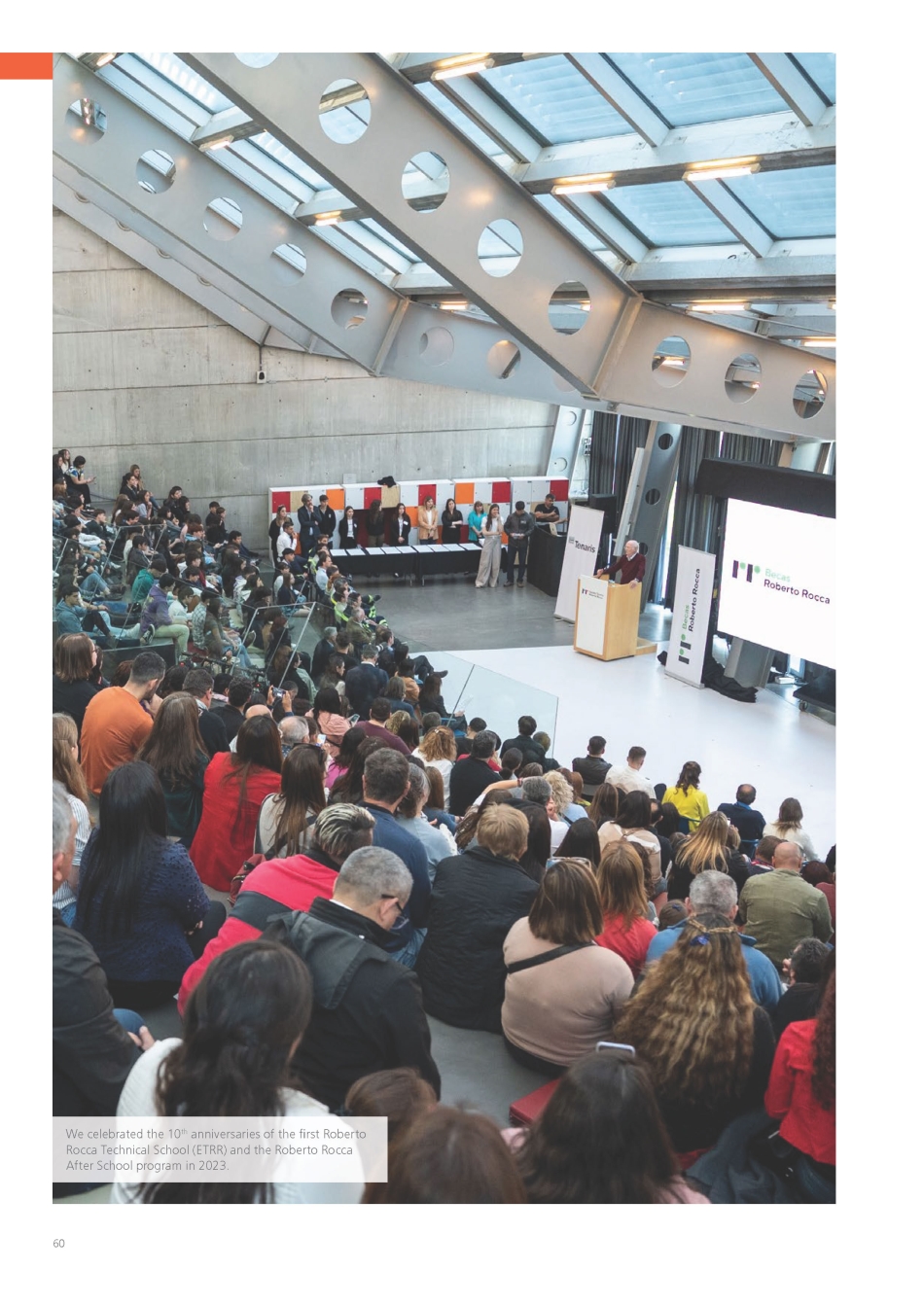
60 We celebrated the 10 th anniversaries of the first Roberto Rocca Technical School (ETRR) and the Roberto Rocca After School program in 2023.
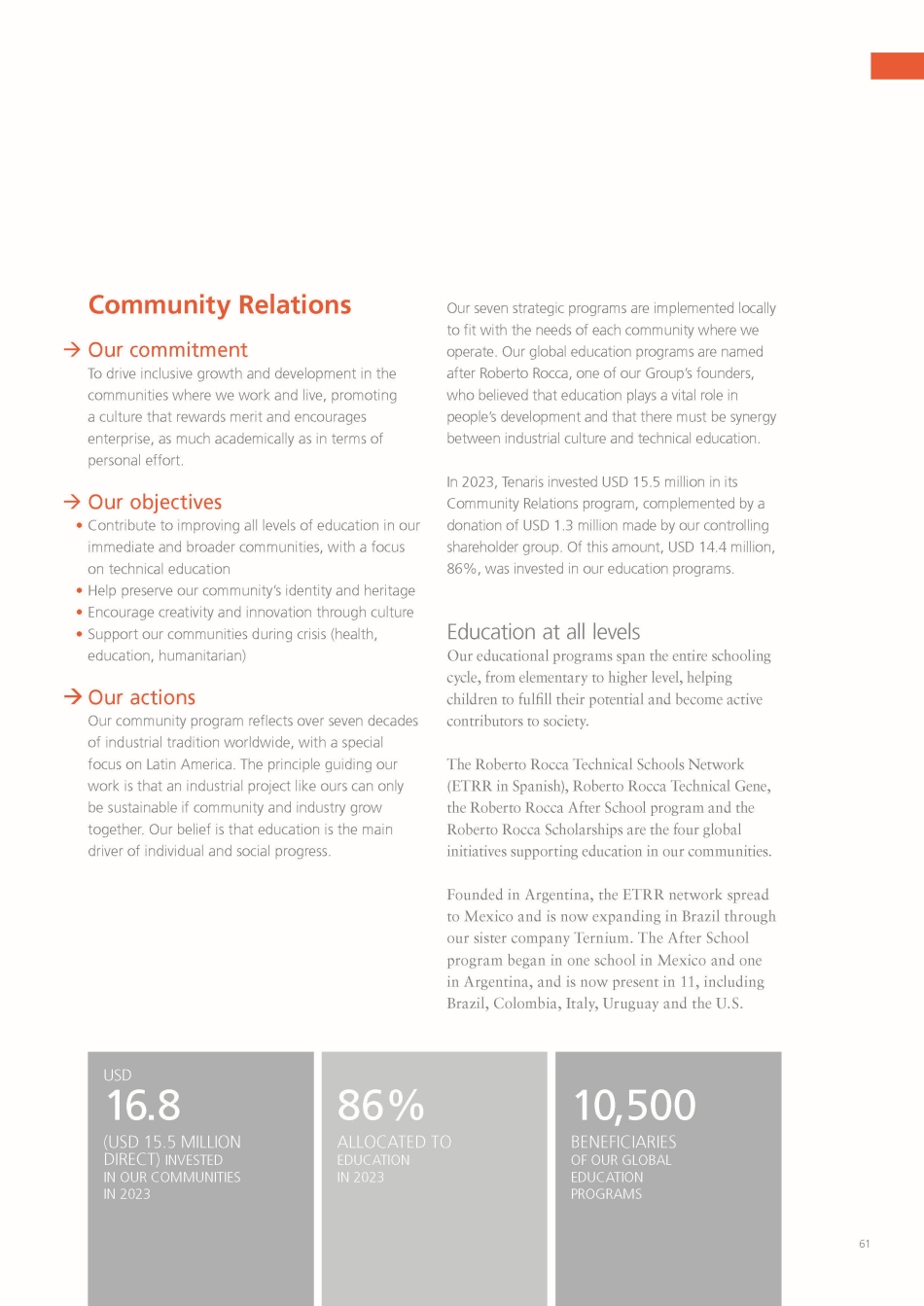
61 USD 16 .8 (USD 15.5 MILLION DIRECT) INVESTED IN OUR COMMUNITIES IN 2023 86% ALLOCATED TO EDUCATION IN 2023 10,500 BENEFICIARIES OF OUR GLOBAL EDUCATION PROGRAMS Community Relations Our commitment To drive inclusive growth and development in the communities where we work and live, promoting a culture that rewards merit and encourages enterprise, as much academically as in terms of personal effort. Our objectives • Contribute to improving all levels of education in our immediate and broader communities, with a focus on technical education • Help preserve our community’s identity and heritage • Encourage creativity and innovation through culture • Support our communities during crisis (health, education, humanitarian) Our actions Our community program reflects over seven decades of industrial tradition worldwide, with a special focus on Latin America. The principle guiding our work is that an industrial project like ours can only be sustainable if community and industry grow together. Our belief is that education is the main driver of individual and social progress. Our seven strategic programs are implemented locally to fit with the needs of each community where we operate. Our global education programs are named after Roberto Rocca, one of our Group’s founders, who believed that education plays a vital role in people’s development and that there must be synergy between industrial culture and technical education. In 2023, Tenaris invested USD 15.5 million in its Community Relations program, complemented by a donation of USD 1.3 million made by our controlling shareholder group. Of this amount, USD 14.4 million, 86%, was invested in our education programs. Education at all levels Our educational programs span the entire schooling cycle, from elementary to higher level, helping children to fulfill their potential and become active contributors to society. The Roberto Rocca Technical Schools Network (ETRR in Spanish), Roberto Rocca Technical Gene, the Roberto Rocca After School program and the Roberto Rocca Scholarships are the four global initiatives supporting education in our communities. Founded in Argentina, the ETRR network spread to Mexico and is now expanding in Brazil through our sister company Ternium. The After School program began in one school in Mexico and one in Argentina, and is now present in 11, including Brazil, Colombia, Italy, Uruguay and the U.S.

62 Developing high standards of technical education The Roberto Rocca Technical Schools (ETRR) network aims to level the playing field and create equal opportunities for children to access technical education, offering all students needs - based scholarships. The ETRR also offers technical courses to other schools and people in the community. The international organization T4 Education ranked the Argentine ETRR among the ten most innovative schools in the world, singling out its educational environment and active learning model. Expanding the network The first ETRR opened in Campana, Argentina, in 2013 and today has 444 students. Our sister company Ternium inaugurated a technical school in Pesquería, Mexico in 2016, now with 406 students, and a third is being built in Santa Cruz, Brazil, for 576 students. New intake rates at the Campana ETRR rose from an initial ceiling of 60 to 72 in 2023. Students achieve high math and technical levels and over 90% go on to university, in many cases being the first in their families to do so. ETRR RECOGNITION In 2023, the Campana ETRR was shortlisted for the World’s Best School Prize in the category of Innovation, ranking among the ten most innovative educational establishments in the world. Organized by the global T4 Education Movement for transformative education, these highly prestigious awards recognize schools that lead by applying new ideas, technology and unique programs for a more inclusive and equitable learning environment. The Roberto Rocca After School program has a track - record of performance and attendance rates which have resulted in improved Math and Literacy skills for children on the program.

63 In 2023, the Campana ETRR scored the highest performance in Math in the tests held by the Austral University to evaluate standards at private schools of a medium - high socioeconomic level in the province of Buenos Aires. The ETRR's performance exceeded the average by 37%. This is doubly commendable, as the other schools assessed have a student intake from better - off socioeconomic backgrounds. The approach taken to offering quality education and equal opportunities reduces the initial gap between low and high - income entry - level students over the seven years of their schooling. By the time they graduate, all students have levelled up, independently of their economic background. Another focus is on encouraging women to study STEM subjects: the percentage of female students at the ETRR has risen from 11% in the first admissions process in 2013 to nearly 40% in 2023. Certified as the first technical training center in Argentina, the Campana ETRR partners with industrial automation companies FESTO and Siemens to certify students from other schools in Industry 4.0 skills. The ETRR also offers Math and Language courses for all elementary school - leavers about to begin high school. In 2023, the ETRR trained over 964 people from the local community. We believe that gifted and committed teachers are crucial to achieving academic excellence. We evaluate our teachers using student feedback surveys, as well as conduct and disciplinary records. Roberto Rocca Technical School (Campana) Students involved Other students from the community ETRR students 1,400 1,200 1,000 800 400 200 0 830 444 2019 2020 2021 2022 2023 322 526 428 436 600 276 393 271 410 Teachers Students 2,000 1,000 0 2019 2020 2021 2022 2023 148 5,196 328 3,216 Technical Gene Students and teachers involved 7,000 6,000 113 5,656 5,000 4,000 126 3,000 3,374 102 1,131 Our commitment to strengthening education, focused on STEM (Science, Technology, Engineering, Math) subjects, is a strategic one, benefiting the future of our companies and communities, in the interests of creating greater prosperity for society as a whole.

64 Strengthening technical education in the community The Roberto Rocca Technical Gene program provides schools with infrastructure and equipment, student and teacher training, and on - the - job internships for high - school students. Launched in 2006, Technical Gene is present in 25 schools in 9 countries. In 2023, 5,344 students and teachers took part in the program. Part of the program provides students with practical experience through technological projects and internships. In 2023, 225 students from Campana, Pindamonhangaba, Bergamo, Veracruz and Zalău did internships at our plants. In Campana, Veracruz, Pindamonhangaba, Cartagena and Zalău, the agenda includes Project - based learning, Math and Technical subjects, as well as FESTO Certifications. In 2023, to remedy the 40 - point post - pandemic performance slide, we stepped up Math training, and 41 teachers from 6 schools took the program while 156 students qualified in technical areas. We provide schools with infrastructure support to refurbish workshops and equipment: in 2023, we upgraded three technical schools in Romania, complementing this investment with a 2 - year training path to enhance student employability. We set up a FESTO lab at a school in Veracruz and in Cartagena we equipped the environmental monitoring laboratory. After School program Students involved Roberto Rocca Scholarships program Students involved 2,400 2,000 1,600 1,200 800 400 0 2023 2019 2020 2021 2022 University and PhD High school 527 1,325 542 1,843 1,222 484 1,606 432 1,335 415 2,100 1,800 1,500 1,200 900 600 300 0 2019 1,257 2,026 1,482 1,492 1,473 2023 2022 2021 2020 Note: 2023 includes other students trained from the community

65 Starting at a young age The Roberto Rocca After School program for children aged 6 - 15 focuses on all - around development, in particular basic literacy, Math, Science and social - emotional skills by offering extra - curricular education four days a week. The program is underway in 11 schools in 7 countries, reaching over 1,400 regular students. In 2023, to celebrate After School’s 10 th anniversary, we held educational workshops with international speakers for teachers from our communities as part of Roberto Rocca Education Day. In 2023 , After School expanded to include 180 children in Campana with four new classrooms built at the school . The program was extended to secondary level in Dalmine where 146 students joined . Encouraging educational excellence Launched in 1976 in Argentina, the Roberto Rocca Scholarships program encourages academic performance and commitment among high - school students, undergraduate and graduate students living in Tenaris communities. In addition to academic excellence, the criteria for selection include a socioeconomic evaluation as part of the drive to promote equal opportunities and social mobility. In 2023, 1,325 scholarships were awarded to high performing secondary school students, 523 to undergraduates, and 4 to doctoral students. Culture and tradition Sharing horizons and celebrating diversity For Tenaris and its sister companies in the Techint Group, art and culture are a source of innovation as well as a means of celebrating diversity. The foundation of our global arts programs is our partnership with the contemporary art Fundación PROA in Argentina, and our support for the Galleria d’Arte Moderna e Contemporanea in Bergamo. During 2023, PROA received over 90,000 in - person visitors. In 2023, Tenaris organized cultural activities, including Film Festivals, in Campana, Houston, Blytheville, Dalmine, Cartagena, Zalău, Campina, Calarasi and Montevideo, attracting a total of 8,787 spectators. History in the making and education for the future In Italy, the Fondazione Dalmine in Bergamo is responsible for disseminating Tenaris’s history and industrial culture through cultural events and exhibitions. To celebrate our industrial heritage, in 2023, we began work to convert a historic building in Dalmine into a community Education and Cultural center offering technological courses, cultural activities and exhibitions. Our photo libraries in Campana, Pindamonhangaba, Veracruz and Montevideo, house photographic records of the history of the communities where we work and live, available online to the community.
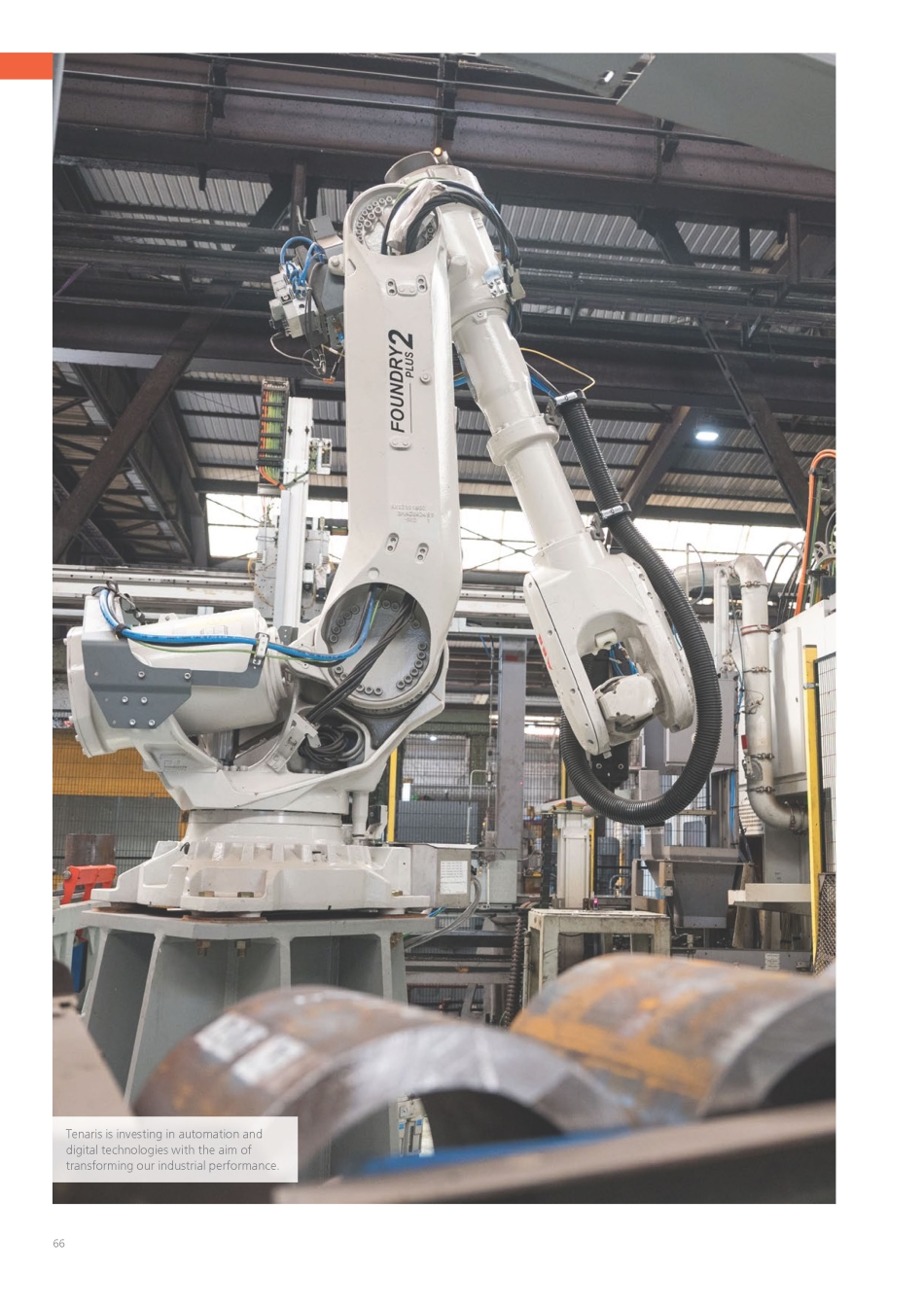
66 Tenaris is investing in automation and digital technologies with the aim of transforming our industrial performance.
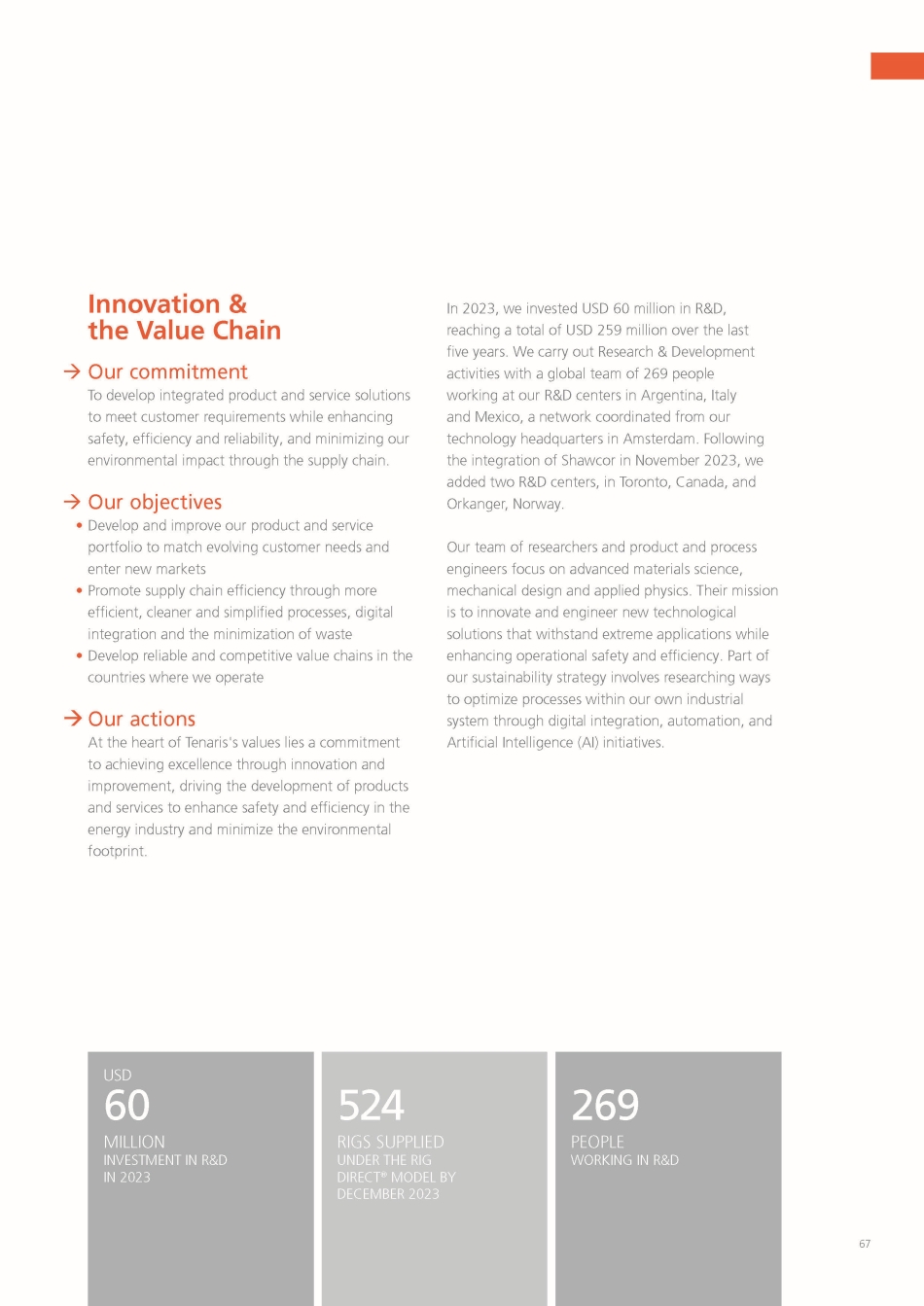
67 Innovation & the Value Chain Our commitment To develop integrated product and service solutions to meet customer requirements while enhancing safety, efficiency and reliability, and minimizing our environmental impact through the supply chain. Our objectives • Develop and improve our product and service portfolio to match evolving customer needs and enter new markets • Promote supply chain efficiency through more efficient, cleaner and simplified processes, digital integration and the minimization of waste • Develop reliable and competitive value chains in the countries where we operate Our actions At the heart of Tenaris's values lies a commitment to achieving excellence through innovation and improvement, driving the development of products and services to enhance safety and efficiency in the energy industry and minimize the environmental footprint. In 2023, we invested USD 60 million in R&D, reaching a total of USD 259 million over the last five years. We carry out Research & Development activities with a global team of 269 people working at our R&D centers in Argentina, Italy and Mexico, a network coordinated from our technology headquarters in Amsterdam. Following the integration of Shawcor in November 2023, we added two R&D centers, in Toronto, Canada, and Orkanger, Norway. Our team of researchers and product and process engineers focus on advanced materials science, mechanical design and applied physics. Their mission is to innovate and engineer new technological solutions that withstand extreme applications while enhancing operational safety and efficiency. Part of our sustainability strategy involves researching ways to optimize processes within our own industrial system through digital integration, automation, and Artificial Intelligence (AI) initiatives. USD 60 MILLION INVESTMENT IN R&D IN 2023 524 RIGS SUPPLIED UNDER THE RIG DIRECT ® MODEL BY DECEMBER 2023 269 PEOPLE WORKING IN R&D

68 Solutions for shale operations We focus on two main aspects in our R&D work: serving the energy market, especially the oil and gas sector, and supporting our industry and customers in transitioning to cleaner energy. We are contributing to the development of unconventional resources for shale plays worldwide through a comprehensive offer that combines technological solutions and our Rig Direct ® services. Our TenarisHydril Wedge Series 400 connections address the demands of extreme torque capabilities and faster installation speeds, as well as the need for overall connection robustness imposed by the growing trend for longer laterals. In 2023, our Wedge 461 ® connection was instrumental to the record - breaking lateral lengths achieved by wells in onshore operations in the U.S. Our Rig Direct ® strategy involves working closely with customers through every step of their projects, lowering operational costs through an integrated services solution. This approach covers technical advice for product selection, collaborative demand and supply planning, as well as efficient supply chain management and on site technical assistance. We have further simplified operations by including our RunReady service in the Rig Direct ® value proposition. With RunReady , pipes are prepared at Tenaris’s mills and delivered ready for running in the well, which reduces the need for pipe handling in addition to the people required on site and the number of operative processes, enhancing safety and minimizing environmental impact. To complement the range of digital solutions offered under Rig Direct ® , in 2023, we launched a series of new technological tools designed to support well integrity. Our torque - turn monitoring system enables us to collect and analyze torque data from rig operations in real time during running. This improves decision - making, enhancing the reliability of connection make - up, which not only reduces the risk of errors but also guarantees the integrity of assembly. Our iRun Casing technology is a Cloud - based monitoring tool that connects to the drilling rig and processes large amounts of data during casing installation operations. By highlighting the evolution of critical variables, it provides information to guide the safe installation of casing in real time. Investment in R&D In USD million 100 80 60 40 20 0 2019 2020 2021 2022 2023 60 51 45 61 42 The expansion of our Rig Direct ® mill - to - well service model is the result of our customer partnership strategy and has contributed to the progressive transformation of the energy supply chain over the last ten years.
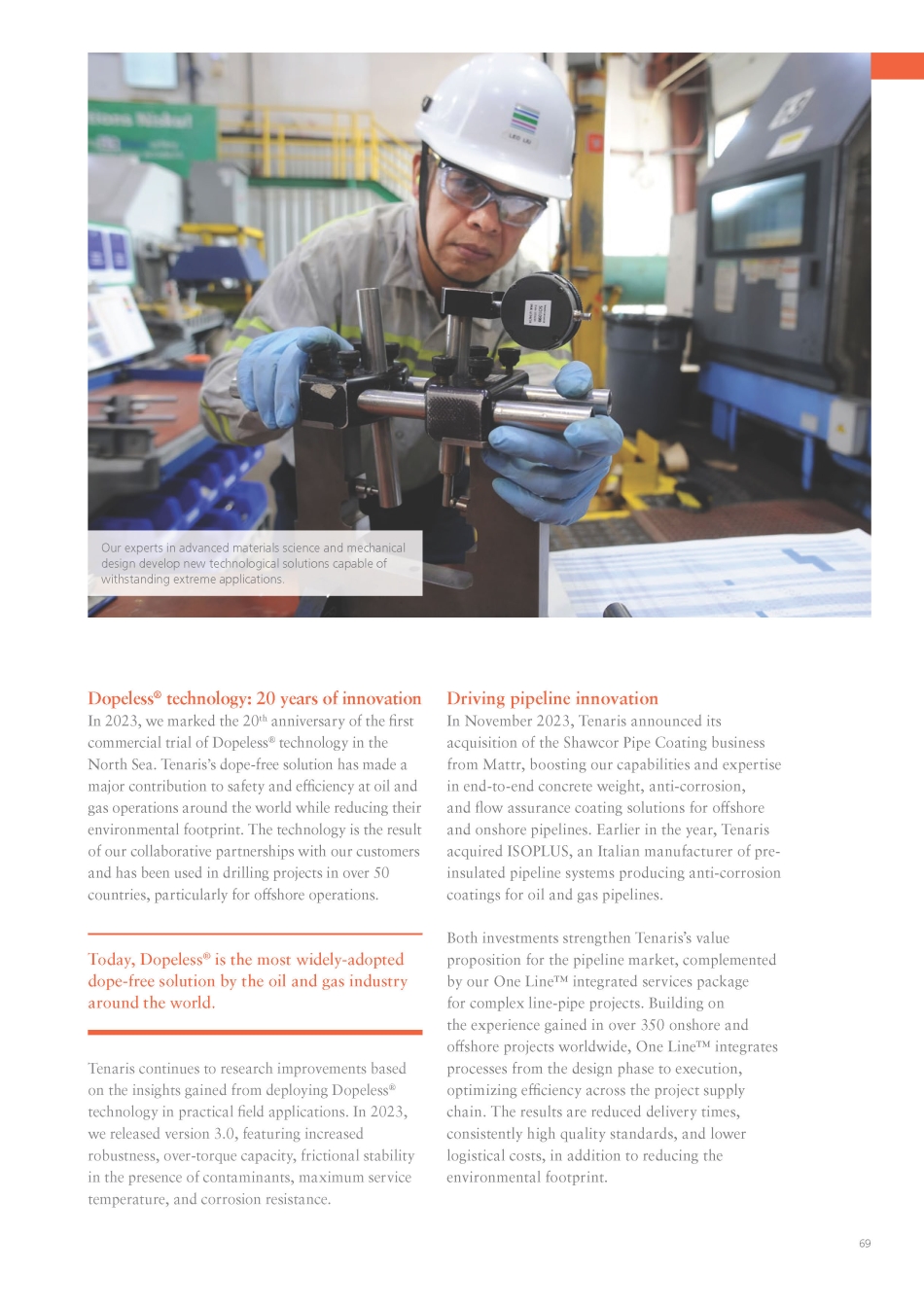
69 Dopeless ® technology: 20 years of innovation In 2023, we marked the 20 th anniversary of the first commercial trial of Dopeless ® technology in the North Sea. Tenaris’s dope - free solution has made a major contribution to safety and efficiency at oil and gas operations around the world while reducing their environmental footprint. The technology is the result of our collaborative partnerships with our customers and has been used in drilling projects in over 50 countries, particularly for offshore operations . Today, Dopeless ® is the most widely - adopted dope - free solution by the oil and gas industry around the world . Tenaris continues to research improvements based on the insights gained from deploying Dopeless ® technology in practical field applications. In 2023, we released version 3.0, featuring increased robustness, over - torque capacity, frictional stability in the presence of contaminants, maximum service temperature, and corrosion resistance. Driving pipeline innovation In November 2023, Tenaris announced its acquisition of the Shawcor Pipe Coating business from Mattr, boosting our capabilities and expertise in end - to - end concrete weight, anti - corrosion, and flow assurance coating solutions for offshore and onshore pipelines. Earlier in the year, Tenaris acquired ISOPLUS, an Italian manufacturer of pre - insulated pipeline systems producing anti - corrosion coatings for oil and gas pipelines. Both investments strengthen Tenaris ʼ s value proposition for the pipeline market, complemented by our One Line integrated services package for complex line - pipe projects. Building on the experience gained in over 350 onshore and offshore projects worldwide, One Line integrates processes from the design phase to execution, optimizing efficiency across the project supply chain. The results are reduced delivery times, consistently high quality standards, and lower logistical costs, in addition to reducing the environmental footprint. Our experts in advanced materials science and mechanical design develop new technological solutions capable of withstanding extreme applications.

70 Supporting the energy transition We are dedicated to developing a low - carbon product portfolio for the next generation of energy requirements, including solutions for hydrogen storage and transportation, carbon capture and storage (CCS), and geothermal energy. Drawing on its experience and expertise in developing and testing tubular technologies to support CCS initiatives, Tenaris is collaborating with leading public and private entities and operators, gathering valuable insights for materials testing. In 2023, we were awarded the Fluxys contract to supply 500 pipes and One Line coating services to the Belgian Hydrogen Backbone, an initiative launched to capitalize on Belgium's strategic geographical location and existing gas infrastructure in order to establish a robust hydrogen network. Low temperatures and corrosion represent the main technical challenges for CO 2 transportation and storage. In collaboration with the Italian energy multinational Eni, Tenaris has run full - scale testing for TenarisHydril Blue ® premium connections with Dopeless ® technology under cryogenic conditions. In the absence of standardized protocols qualifying connections for CCS wells, Eni and Tenaris have developed a testing procedure based on the actual challenges encountered by Eni in their initial CCS projects in Europe, particularly for CO 2 injection wells. The results showed the suitability of the Blue ® Dopeless ® connection for CCS injection wells, as it can withstand thermal shock while maintaining its sealability and structural integrity. HYDROGEN SOLUTIONS As the relevance of hydrogen in the pursuit of net zero emissions continues to expand, Tenaris is developing innovative hydrogen storage and transport solutions. We actively participate in Joint Industry Projects, Research Task Forces and normative bodies to further hydrogen and CCS use in both Europe and the Americas. In 2023, Tenaris extended its THera technology portfolio with a new linear storage solution to support the hydrogen segment. Offering enhanced storage capacity for 5 - 100 tons, it is designed for high - pressure hydrogen storage applications, as the materials take into account the fatigue life of components within the hydrogen environment.
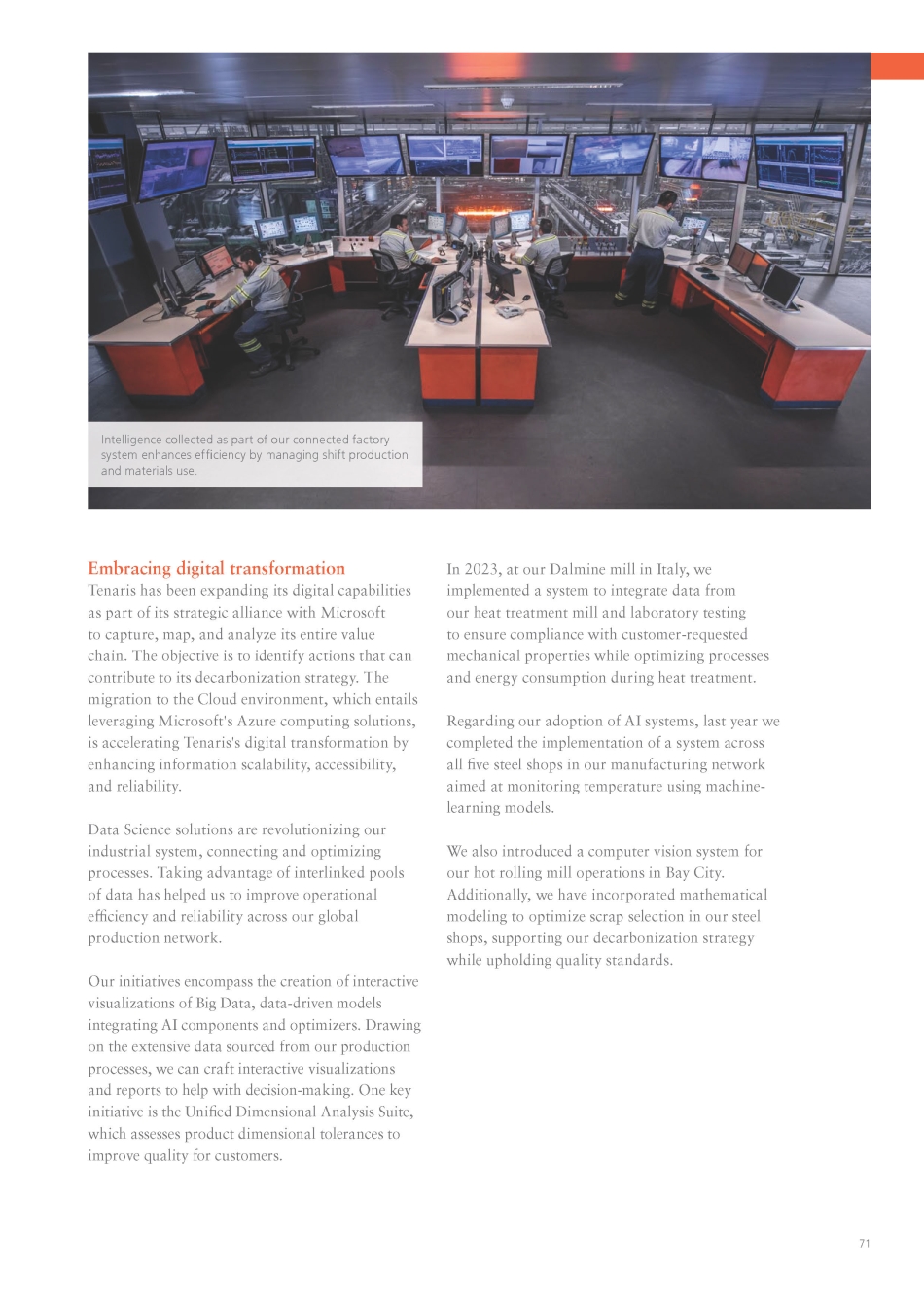
71 Embracing digital transformation Tenaris has been expanding its digital capabilities as part of its strategic alliance with Microsoft to capture, map, and analyze its entire value chain. The objective is to identify actions that can contribute to its decarbonization strategy. The migration to the Cloud environment, which entails leveraging Microsoft's Azure computing solutions, is accelerating Tenaris's digital transformation by enhancing information scalability, accessibility, and reliability. Data Science solutions are revolutionizing our industrial system, connecting and optimizing processes. Taking advantage of interlinked pools of data has helped us to improve operational efficiency and reliability across our global production network. Our initiatives encompass the creation of interactive visualizations of Big Data, data - driven models integrating AI components and optimizers. Drawing on the extensive data sourced from our production processes, we can craft interactive visualizations and reports to help with decision - making. One key initiative is the Unified Dimensional Analysis Suite, which assesses product dimensional tolerances to improve quality for customers. In 2023, at our Dalmine mill in Italy, we implemented a system to integrate data from our heat treatment mill and laboratory testing to ensure compliance with customer - requested mechanical properties while optimizing processes and energy consumption during heat treatment. Regarding our adoption of AI systems, last year we completed the implementation of a system across all five steel shops in our manufacturing network aimed at monitoring temperature using machine - learning models. We also introduced a computer vision system for our hot rolling mill operations in Bay City. Additionally, we have incorporated mathematical modeling to optimize scrap selection in our steel shops, supporting our decarbonization strategy while upholding quality standards. Intelligence collected as part of our connected factory system enhances efficiency by managing shift production and materials use.

72 The Value Chain The trend of disruption in the supply chain, despite the slight slowdown in the inflationary context, seems set to stay, as hotspots of conflict and geopolitical unrest emerge around the world, impacting how companies run their businesses. The need to build resilience into the supply chain is as strong as ever, with new generative AI and other innovative logistics management technologies moving into the front seat as companies strengthen and diversify their sourcing strategies . In this context, Tenaris is devoting considerable resources to strengthening its supplier relationships, with a view to reducing transaction costs, as well as enhancing flexibility and fostering greater adaptability for more efficient problem - solving. By deepening our approach to value - chain management, we are also extending existing policies implemented by our procurement company Exiros for a sharper focus on environmental performance. Sustainable sourcing In 2023, Tenaris adopted a Sustainable Sourcing Policy to foster closer dialogue with suppliers and improve their awareness of sustainability concepts so that they can accompany us in meeting the standards required in our operations, providing support and training as needed. Our vision is to help our supply chain become more competitive by adopting global quality, safety and environmental standards, acquiring the resilience to withstand market changes and sustain a solid value chain. We are currently implementing the Open - es platform, an open and collaborative ecosystem that aims to involve all the supply chain actors in the energy transition. The platform offers sustainability analysis tools to help us work with key suppliers. Suppliers by country (*) Argentina Mexico U.S. Italy Romania Brazil Canada Colombia Saudi Arabia Indonesia China Nigeria UAE 400 800 1,200 1,600 2,000 (*) 81% of our suppliers are local Local suppliers Suppliers from abroad Contractual payment terms 25% Less than 30 days More than 60 days 5% Between 30 and 60 days 15% 55% 30 days

73 Raw materials Most of our products are manufactured using EAF in integrated steelmaking operations from steel scrap, DRI, HBI, pig iron and ferroalloys. In Argentina, we make our own DRI from iron ore in pellet form, using natural gas as a reductant. In 2023, annual iron ore consumption, mostly from Brazil and Canada, was some 850,000 tons. Prices and availability of iron ore or other raw materials may be negatively affected by production interruptions, such as accidents or natural disasters. To mitigate risks and reduce dependency, we have been developing alternative suppliers. With our procurement company Exiros, we hold a selection process to ensure suppliers comply with the Company’s Code of Conduct and local laws. Our new Sustainable Sourcing Policy is being integrated into this process as well as regular assessments of our suppliers’ sustainability status. All business partners are required to meet internal standards governing ethical behavior, legal compliance, and HSE responsibilities. Our HSE audits help suppliers manage long - term risks, certifying that those performing high HSE - risk activities have the right capabilities. As of the date of this report, we have audited and certified 92% of our high - HSE risk active service suppliers, required to award a service contract. The audit is based on Tenaris’s standard self - assessment process for suppliers wishing to provide services. In 2023, 510 new audits were held. Tenaris purchases most of its supplies through Exiros, whose quality system is certified to ISO 9001 standards. In December 2023, Exiros had nearly 54,000 registered suppliers, of which over 16,000 were active during the year, with 9,100 supplying Tenaris. PROPYMES: COLLABORATION IN TIMES OF CHANGE Launched in December 2002, the ProPymes Program supports Small and Medium - sized Enterprises (SMEs) making up the value chain of Tenaris and its sister companies Ternium, Tecpetrol and Techint Engineering & Construction. The Program aimed to build an integrated ecosystem with the companies in the value chain by helping them grow, innovate and develop successful export strategies. Today, the Program works with 1,109 firms which have received technical assistance to train some 52,000 employees and over USD 78 million in credit support from the Techint Group. These firms have exported goods and services worth USD 263 million to other Group companies. In 2023, the Program provided 80,000 training hours. The 22 nd edition of the Group’s annual ProPymes seminar in December 2023 brought together SMEs from the value chain to analyze the situation in Argentina and the region, and discuss the outlook for sustainability, technical education, innovation and Industry 4.0. Attended by 650 online and in - person SME representatives, there were speeches by Tenaris CEO Paolo Rocca and other leaders, such as Javier Martínez Álvarez, Tenaris President for the Southern Cone. They discussed the challenges related to international trade and productivity, and the opportunities arising in the energy transition. ProPymes supports the Group’s community education program Technical Gene. In 2023, SMEs helped technical schools train 1,600 young people in workplace skills through on - the - job training.

74 Governance
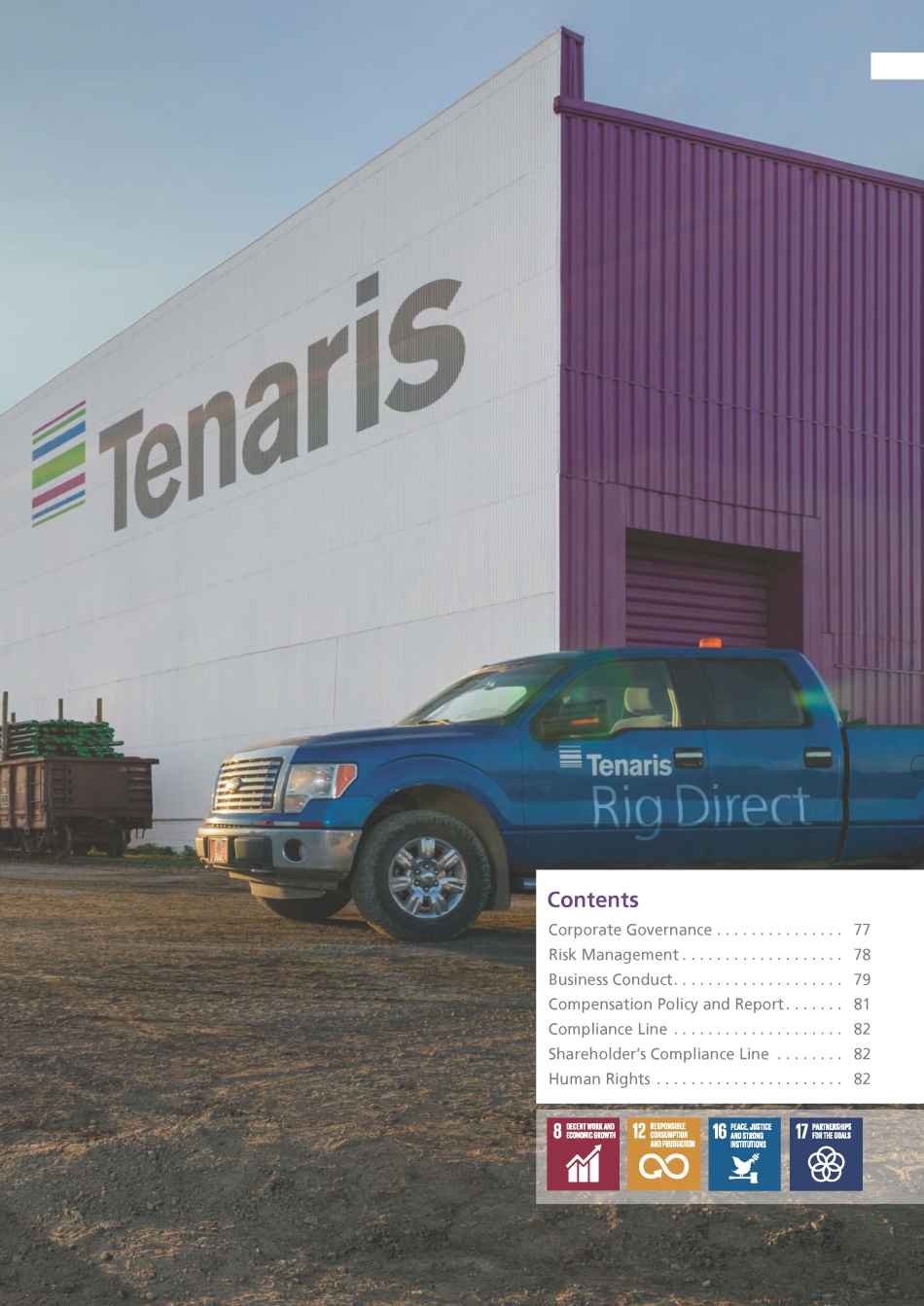
75 Contents Corporate Governance . . . . . . . . . . . . . . . 77 Risk Management . . . . . . . . . . . . . . . . . . . 78 Business Conduct . . . . . . . . . . . . . . . . . . . . 79 Compensation Policy and Report . . . . . . . 81 Compliance Line . . . . . . . . . . . . . . . . . . . . 82 Shareholder’s Compliance Line . . . . . . . . 82 Human Rights . . . . . . . . . . . . . . . . . . . . . . 82
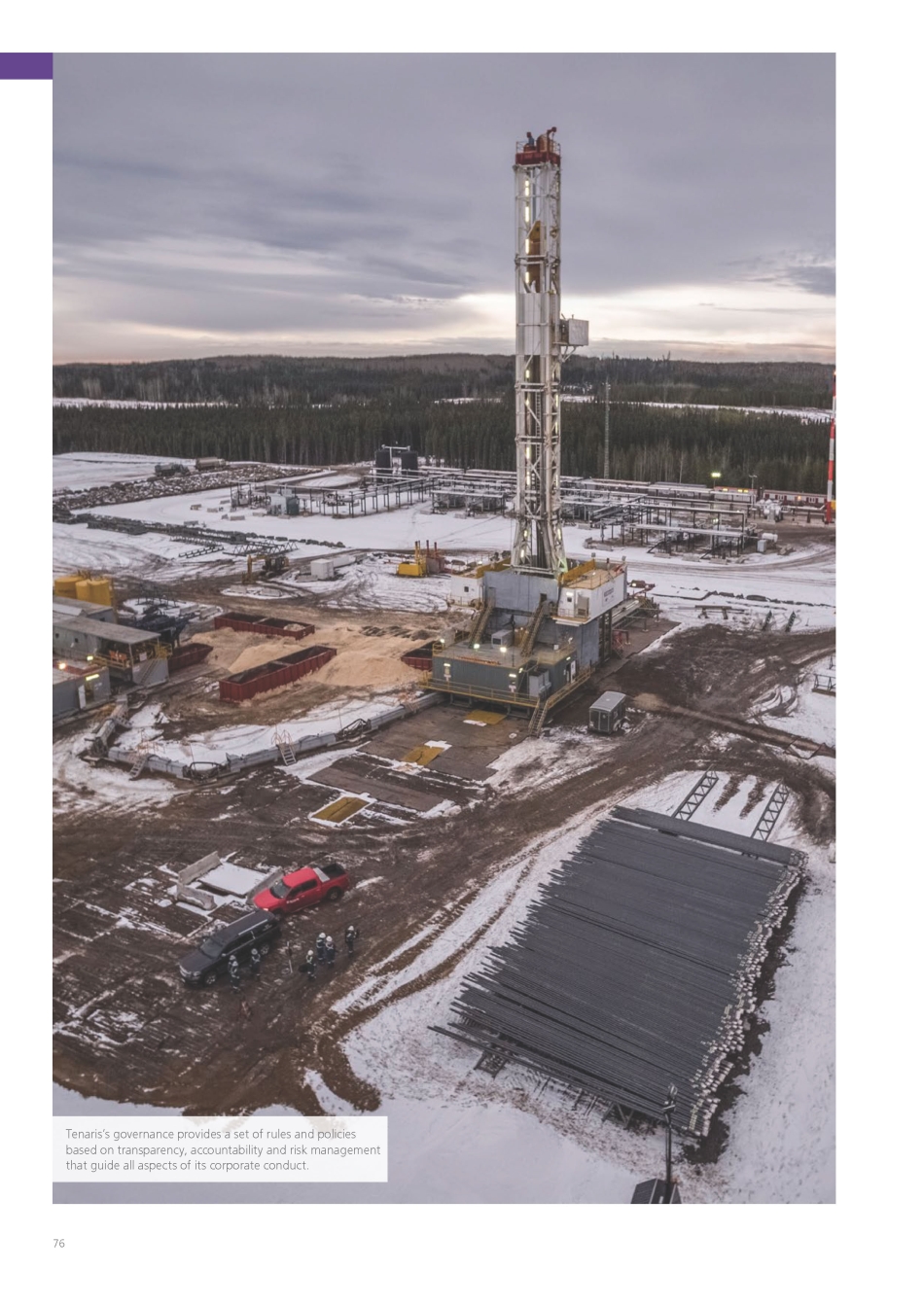
76 Tenaris’s governance provides a set of rules and policies based on transparency, accountability and risk management that guide all aspects of its corporate conduct.

77 Our commitment To build a corporate culture of transparency and integrity based on ethical behavior and compliance with the law. Our objectives • Develop and oversee Tenaris’s strategy and risk management, taking into account financial, social, environmental and ethical considerations to ensure our long - term sustainability. Corporate governance Tenaris S.A. (the “Company”), is a société anonyme organized under the laws of the Grand Duchy of Luxembourg. As of December 31, 2023, San Faustin S.A. owned 60.45% of the Company’s issued share capital, through its wholly owned subsidiary Techint Holdings S.à r.l. San Faustin has controlling interests in Ternium, the leading steel producer in Latin America; Tecpetrol, an oil and gas company; Techint, an engineering and construction company; Tenova, supplying equipment and technologies for iron and steel and mining; and Humanitas, a research hospital network in Italy. The Company’s shares are listed and traded on the Italian Stock Exchange and the Mexican Stock Exchange; and in addition, the Company’s American Depositary Shares (ADSs) are listed and traded on the New York Stock Exchange. Management of the Company is vested in a board of directors with the broadest powers to act on behalf of the Company and accomplish or authorize all acts and transactions of management and disposal that are within its corporate purpose and not specifically reserved in the articles of association, or by applicable law, to the general shareholders’ meeting. The Company’s current board of directors is composed of ten directors, of which four qualify as independent directors under applicable U.S. securities regulations, and the Company’s articles of association. The board of directors meets as often as required by the interests of the Company and at least four times per year . In 2023 , the Company’s board of directors met seven times and adopted one unanimous written resolution. On May 3, 2023, the board of directors appointed Mr. Paolo Rocca as administrateur délégué (CEO) and delegated to him the power to manage the Company’s affairs within the ordinary course of business to the full extent permitted by Luxembourg law; to direct and supervise the business activities of the Company’s subsidiaries; and to represent the Company in relation to such matters. The Company’s board of directors has an audit committee, which currently consists of three independent directors both for the purposes of Exchange Act Rule 10A - 3(b) (1), and under the Company’s articles of association.
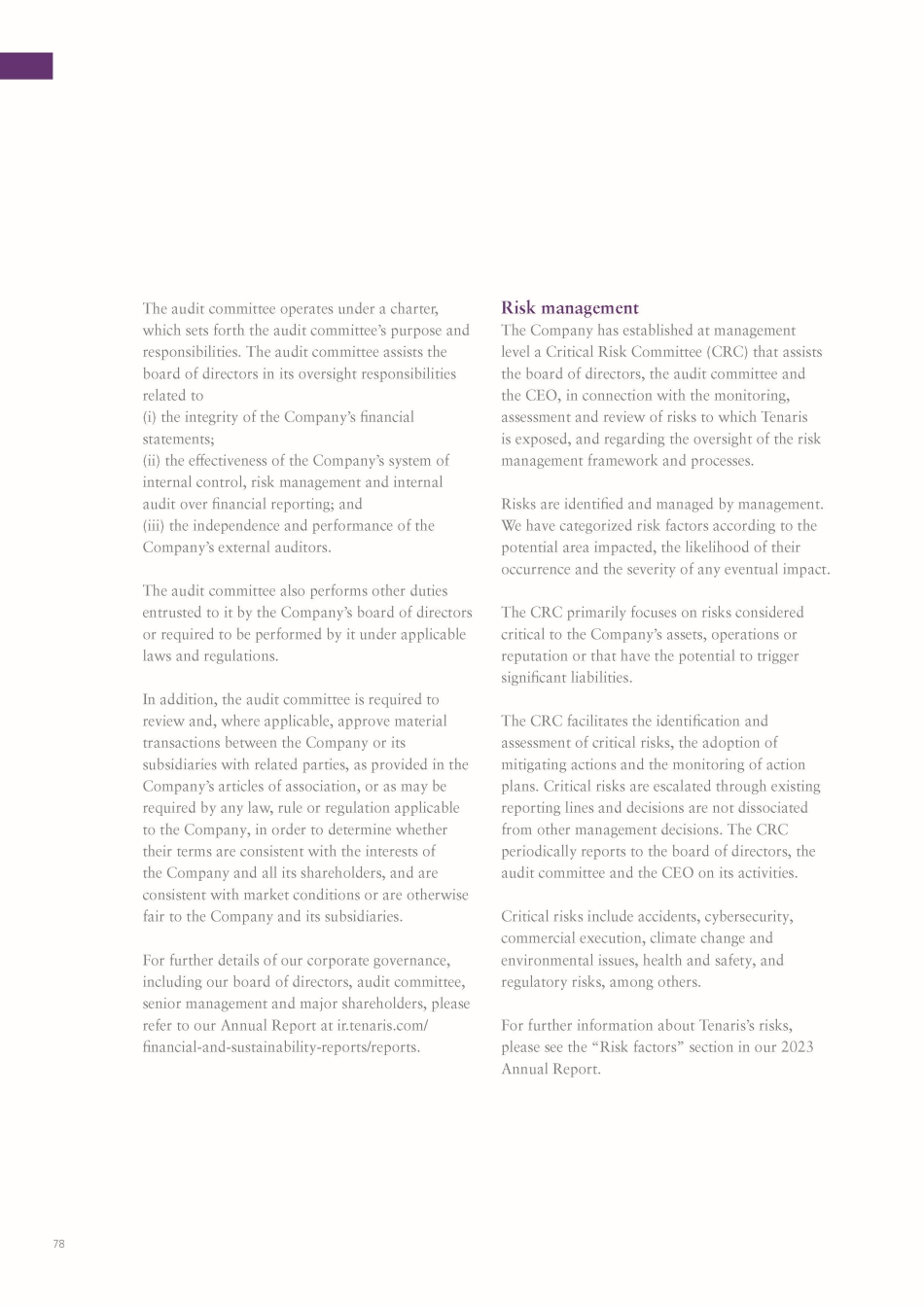
78 The audit committee operates under a charter, which sets forth the audit committee’s purpose and responsibilities. The audit committee assists the board of directors in its oversight responsibilities related to (i) the integrity of the Company’s financial statements; (ii) the effectiveness of the Company’s system of internal control, risk management and internal audit over financial reporting; and (iii) the independence and performance of the Company’s external auditors. The audit committee also performs other duties entrusted to it by the Company’s board of directors or required to be performed by it under applicable laws and regulations. In addition, the audit committee is required to review and, where applicable, approve material transactions between the Company or its subsidiaries with related parties, as provided in the Company’s articles of association, or as may be required by any law, rule or regulation applicable to the Company, in order to determine whether their terms are consistent with the interests of the Company and all its shareholders, and are consistent with market conditions or are otherwise fair to the Company and its subsidiaries. For further details of our corporate governance, including our board of directors, audit committee, senior management and major shareholders, please refer to our Annual Report at ir.tenaris.com/ financial - and - sustainability - reports/reports . Risk management The Company has established at management level a Critical Risk Committee (CRC) that assists the board of directors, the audit committee and the CEO, in connection with the monitoring, assessment and review of risks to which Tenaris is exposed, and regarding the oversight of the risk management framework and processes. Risks are identified and managed by management. We have categorized risk factors according to the potential area impacted, the likelihood of their occurrence and the severity of any eventual impact. The CRC primarily focuses on risks considered critical to the Company’s assets, operations or reputation or that have the potential to trigger significant liabilities. The CRC facilitates the identification and assessment of critical risks, the adoption of mitigating actions and the monitoring of action plans. Critical risks are escalated through existing reporting lines and decisions are not dissociated from other management decisions. The CRC periodically reports to the board of directors, the audit committee and the CEO on its activities. Critical risks include accidents, cybersecurity, commercial execution, climate change and environmental issues, health and safety, and regulatory risks, among others. For further information about Tenaris’s risks, please see the “Risk factors” section in our 2023 Annual Report.

79 Business Conduct: committed to Compliance Tenaris is committed to building a corporate culture of business ethics based on ethical behavior and compliance with the law. The Company has adopted a Code of Conduct incorporating guidelines and standards of integrity and transparency applicable to all of our directors, officers and employees. As far as the nature of each relation permits, all the principles detailed in the Company’s Code of Conduct also apply to relations with our contractors, subcontractors, suppliers and associated persons. In addition, the Company has adopted a Code of Ethics for Senior Financial Officers, intended to supplement the Company’s Code of Conduct. It applies specifically to the principal executive officer, the principal financial officer, the principal accounting officer or controller, as well as persons performing similar functions. The Company Policy on Business Conduct sets forth principles and procedures designed to ensure that Tenaris S.A. and its Subsidiaries comply with the requirements of the Code of Conduct and various national laws prohibiting bribery and corruption, which, in some cases, also penalize criminal conduct occurring outside their territories. The Company’s Business Conduct Compliance Officer is responsible for implementing the Business Conduct Compliance Program aimed at identifying and mitigating corruption risks, managing third - party corruption risk and fostering a culture of compliance, ethical behavior, integrity and transparency. The Company regularly issues, reviews and validates its codes, policies, procedures and standards following anti - corruption and ethical business regulations and its developments, including the U.S. Foreign Corrupt Practices Act (FCPA), the UK Bribery Act, and the fundamentals of the OECD Convention on Combating Bribery of Foreign Public Officials. The Company’s Board of Directors approved an updated Code of Conduct and Policy on Business Conduct in November 2023. The Company’s Business Conduct Compliance Program is a single, risk - based approach to how the Company develops, structures and implements anti - corruption and anti - bribery compliance and adherence to ethical business, regulating interaction with public officials, governmental entities, customers, communities, any public and private corporations, business partners and third - party employees. The Business Conduct Compliance Program develops several preventive actions within the following ten core compliance areas: Risk Assessment and Planning, Normative, Advising and Guidance, Communications, Training, Certifications, Third Parties, Monitoring and Audit, Discipline and Remediation, and Profession. These activities are based on regular risk evaluations, and best practices to meet regulatory expectations in the development of each activity to identify, respond and focus on critical factors, with special attention to risk prevention through education and communication, emphasizing the importance of controls and awareness. Tenaris understands that high standards of integrity and transparency can only be achieved by setting common rules among its employees, officers and directors, as well as the third parties with which it engages in business.
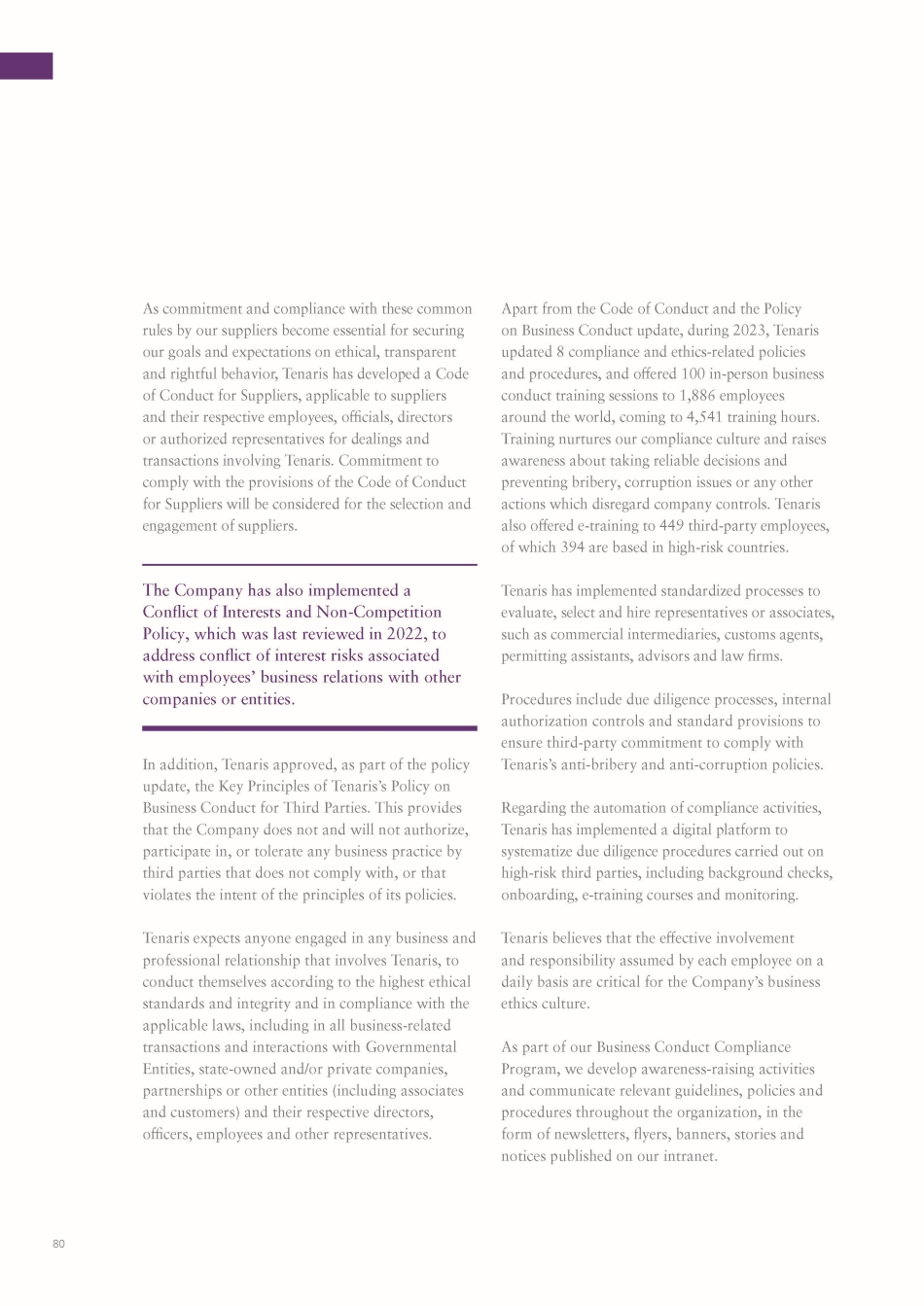
80 As commitment and compliance with these common rules by our suppliers become essential for securing our goals and expectations on ethical, transparent and rightful behavior, Tenaris has developed a Code of Conduct for Suppliers, applicable to suppliers and their respective employees, officials, directors or authorized representatives for dealings and transactions involving Tenaris. Commitment to comply with the provisions of the Code of Conduct for Suppliers will be considered for the selection and engagement of suppliers. The Company has also implemented a Conflict of Interests and Non - Competition Policy, which was last reviewed in 2022, to address conflict of interest risks associated with employees’ business relations with other companies or entities. In addition, Tenaris approved, as part of the policy update, the Key Principles of Tenaris’s Policy on Business Conduct for Third Parties. This provides that the Company does not and will not authorize, participate in, or tolerate any business practice by third parties that does not comply with, or that violates the intent of the principles of its policies. Tenaris expects anyone engaged in any business and professional relationship that involves Tenaris, to conduct themselves according to the highest ethical standards and integrity and in compliance with the applicable laws, including in all business - related transactions and interactions with Governmental Entities, state - owned and/or private companies, partnerships or other entities (including associates and customers) and their respective directors, officers, employees and other representatives. Apart from the Code of Conduct and the Policy on Business Conduct update, during 2023, Tenaris updated 8 compliance and ethics - related policies and procedures, and offered 100 in - person business conduct training sessions to 1,886 employees around the world, coming to 4,541 training hours. Training nurtures our compliance culture and raises awareness about taking reliable decisions and preventing bribery, corruption issues or any other actions which disregard company controls. Tenaris also offered e - training to 449 third - party employees, of which 394 are based in high - risk countries. Tenaris has implemented standardized processes to evaluate, select and hire representatives or associates, such as commercial intermediaries, customs agents, permitting assistants, advisors and law firms. Procedures include due diligence processes, internal authorization controls and standard provisions to ensure third - party commitment to comply with Tenaris’s anti - bribery and anti - corruption policies. Regarding the automation of compliance activities, Tenaris has implemented a digital platform to systematize due diligence procedures carried out on high - risk third parties, including background checks, onboarding, e - training courses and monitoring. Tenaris believes that the effective involvement and responsibility assumed by each employee on a daily basis are critical for the Company’s business ethics culture . As part of our Business Conduct Compliance Program, we develop awareness - raising activities and communicate relevant guidelines, policies and procedures throughout the organization, in the form of newsletters, flyers, banners, stories and notices published on our intranet.

81 The Compliance area regularly holds management meetings and distributes educational materials aligned with the industry’s best practices. In 2023, our Company issued 51 communication pieces with a global reach within Tenaris. Regular monitoring and audit activities are performed to verify compliance and to gauge our response capacity worldwide. Compensation Policy and Report Tenaris has adopted a Compensation Policy, in compliance with applicable Luxembourg law. The Compensation Policy, on the Company’s website, sets forth the principles and guidelines for purposes of determining the compensation payable to the members of the Company’s board of directors and the CEO. Tenaris’s Compensation Policy seeks to: • attract, motivate and retain individuals of high • professional standing and experience • promote internal pay equity • incentivize long - term decision making • promote sustainability, efficiency and growth • ensure maximum transparency. By doing so, Tenaris seeks to continue encouraging long - term shareholder engagement. The Company’s board of directors approved, at its meeting held on April 29, 2020, the Compensation Policy of the Company, which was submitted to an advisory non - binding vote at the shareholders meeting held on June 2, 2020, and approved by majority vote. At its meeting held on February 21, 2024, the Company’s board of directors approved certain amendments to the Compensation Policy, which will be submitted to an advisory non - binding vote at the shareholders meeting scheduled to be held on April 30, 2024. Our senior management team is responsible for implementing the company’s long - term sustainability strategy.
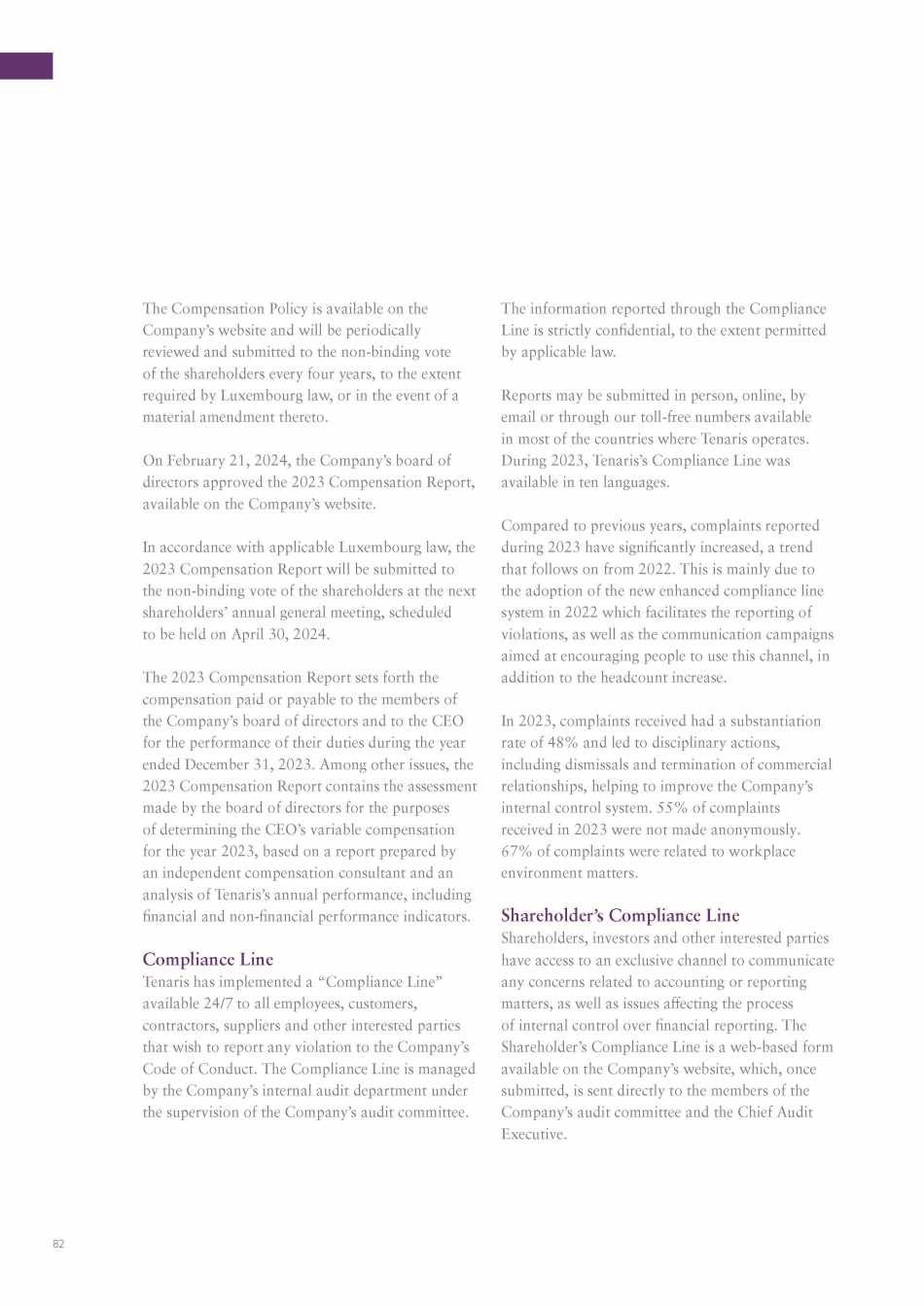
82 The Compensation Policy is available on the Company’s website and will be periodically reviewed and submitted to the non - binding vote of the shareholders every four years, to the extent required by Luxembourg law, or in the event of a material amendment thereto. On February 21, 2024, the Company’s board of directors approved the 2023 Compensation Report, available on the Company’s website. In accordance with applicable Luxembourg law, the 2023 Compensation Report will be submitted to the non - binding vote of the shareholders at the next shareholders’ annual general meeting, scheduled to be held on April 30, 2024. The 2023 Compensation Report sets forth the compensation paid or payable to the members of the Company’s board of directors and to the CEO for the performance of their duties during the year ended December 31, 2023. Among other issues, the 2023 Compensation Report contains the assessment made by the board of directors for the purposes of determining the CEO’s variable compensation for the year 2023, based on a report prepared by an independent compensation consultant and an analysis of Tenaris’s annual performance, including financial and non - financial performance indicators. Compliance Line Tenaris has implemented a “Compliance Line” available 24/7 to all employees, customers, contractors, suppliers and other interested parties that wish to report any violation to the Company’s Code of Conduct. The Compliance Line is managed by the Company’s internal audit department under the supervision of the Company’s audit committee. The information reported through the Compliance Line is strictly confidential, to the extent permitted by applicable law . Reports may be submitted in person, online, by email or through our toll - free numbers available in most of the countries where Tenaris operates. During 2023, Tenaris’s Compliance Line was available in ten languages. Compared to previous years, complaints reported during 2023 have significantly increased, a trend that follows on from 2022. This is mainly due to the adoption of the new enhanced compliance line system in 2022 which facilitates the reporting of violations, as well as the communication campaigns aimed at encouraging people to use this channel, in addition to the headcount increase. In 2023, complaints received had a substantiation rate of 48% and led to disciplinary actions, including dismissals and termination of commercial relationships, helping to improve the Company’s internal control system. 55% of complaints received in 2023 were not made anonymously. 67% of complaints were related to workplace environment matters. Shareholder’s Compliance Line Shareholders, investors and other interested parties have access to an exclusive channel to communicate any concerns related to accounting or reporting matters, as well as issues affecting the process of internal control over financial reporting. The Shareholder’s Compliance Line is a web - based form available on the Company’s website, which, once submitted, is sent directly to the members of the Company’s audit committee and the Chief Audit Executive.

83 Human Rights Tenaris is committed to conducting operations in a way consistent with human rights principles by fostering and promoting respect for the fundamental rights and dignity of people. Our Human Rights Policy was adopted in 2009; it was first reviewed in 2018 and more recently updated in March 2022. The Policy provides that Tenaris will act in compliance with the Universal Declaration of Human Rights, the principles articulated in the International Labour Organization’s Declaration of Fundamental Principles and Rights at Work, and the United Nations Global Compact, as well as all human rights laws, rules and regulations applicable in the jurisdictions where it conducts its business. Tenaris is also subject to the 2015 UK Modern Slavery Act and has implemented a modern slavery due diligence review to assess commitment and compliance by its suppliers, as well as targeted training for employees performing tasks related to human rights and modern slavery issues. In addition, the Company’s Code of Conduct, based on United Nations recommendations, has a specific chapter on “Labor and Human Rights”; and Tenaris’s standard terms and conditions for the purchase of goods and services include provisions on compliance with human rights regulations. Much of the information included in this report expresses our commitment to help our employees and third parties understand and carry out activities in accordance with these principles. They include respect for human freedom and dignity, the prohibition of child labor, forced labor and discriminatory behavior, and the recognition of people’s rights to freedom of association and collective bargaining. Tenaris is a long - term industrial project, and we are convinced that the only way to succeed and prosper is by building long - lasting relations with all our stakeholders, including employees, investors, customers, contractors and suppliers, as well as with the communities where we operate. As part of our risk assessment of suppliers, commercial intermediaries, representatives and other third - party contractors, we have adopted a due diligence review to verify that third - party contractors comply with essential human rights regulations and have not infringed any applicable laws regarding slavery, forced or child labor; i) included in our general terms and conditions for the purchase of goods and services, a commitment by third - party contractors to comply with applicable laws, rules and regulations on human rights, including a prohibition of all forms of slavery, forced labor or child labor, and; ii) implemented a Code of Conduct for Suppliers based on United Nations recommendations, which contemplates a specific section concerning “Labor and Human Rights”. The Code of Conduct for Suppliers applies to all our suppliers and must be accepted as a condition for entering into any agreement to provide goods or services to Tenaris. We value and respect the culture and traditions of the communities where we operate, and we actively work to take into account their health, safety, environment, human rights and economic well - being . On April 26, 2023, the board of directors approved the Company’s annual Modern Slavery Statement, available on www.tenaris.com/en/sustainability/ governance - and - ethics .

84 Annexes
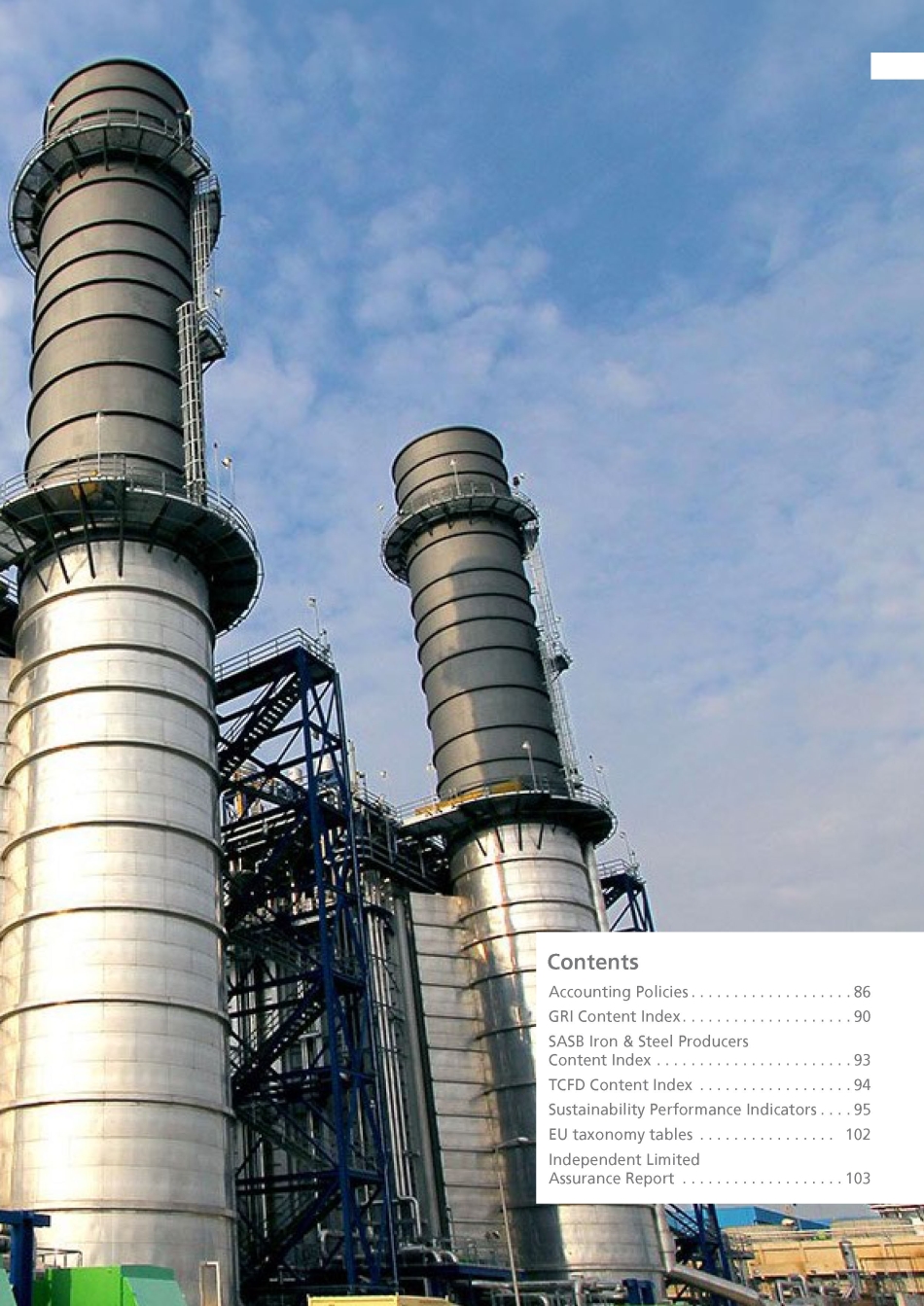
85 Contents Accounting Policies . . . . . . . . . . . . . . . . . . . 86 GRI Content Index . . . . . . . . . . . . . . . . . . . . 90 SASB Iron & Steel Producers Content Index . . . . . . . . . . . . . . . . . . . . . . . 93 TCFD Content Index . . . . . . . . . . . . . . . . . . 94 Sustainability Performance Indicators . . . . 95 EU taxonomy tables . . . . . . . . . . . . . . . . 102 Independent Limited Assurance Report . . . . . . . . . . . . . . . . . . . 103

86 preparation of this Sustainability Report are set out below . These policies have been consistently applied to all the years presented, unless otherwise stated . Basis of presentation This report has been prepared with reference to the guidelines established by the Greenhouse Gas (GHG) protocol, worldsteel, the UN Global Compact, the Global Reporting Initiative (GRI), the Sustainability Accounting Standards Board (SASB) and the recommendations of the Task Force on Climate - related Financial Disclosures (TCFD). Please see the GRI, SASB and TCFD content indices at the end of this report. Our Health, Safety and Environment, and Quality Management systems are designed according to the latest versions of the ISO 14001, ISO 45001 and ISO 9001 standards. The scope of this report is the same as the one for our financial statements, except for those production sites that were not considered material due to their low level of operation during the year, or any other case explicitly described in this report . Management defines short term in the field of risk management to be one year, medium term up to five years, and long term over five years. Rounding Certain monetary amounts, percentages and other figures included in this Sustainability Report have been subject to rounding adjustments. Accordingly, figures shown as totals in certain tables may not be the arithmetic aggregate of the figures preceding them, and figures expressed as percentages in the text may not total 100% or, as applicable, when aggregated, may not be the arithmetic aggregate of the percentages preceding them. Alternative performance measures This sustainability report includes certain non - IFRS alternative performance measures, such as EBITDA, Net cash/debt position, Free cash flow, Return on equity and Return on capital employed. See Exhibit 3 of our Annual Report for more details on the following alternative performance measures: EBITDA, Net cash/debt position, Free cash flow. The principal accounting policies applied in the ECONOMIC Below is a description of other alternative performance measurements employed: Return on equity: Return on equity is usually a simple metric that provides information about how efficient a company is at generating profits. When the return on equity presents a high percentage, it means the company is being efficient at generating income and growth from its own equity financing. Return on equity is often expressed as ROE. Return on equity = Net income (loss) attributable to shareholders’ equity / Average equity attributable to shareholders’ equity. 2023 2022 2021 In USD millions 3,918 2,553 1,100 Net income attributable to shareholders’ equity 15,374 12,933 11,612 Average equity attributable to shareholders’ equity (*) 25% 20% 9% Return on equity (*) Average shareholders’ equity is the sum of shareholders’ equity at the beginning and at the end of the year, divided by two. Return on capital employed (%) Return on capital employed is a metric that provides information about the company's ability to generate returns on their investment. Return on capital employed is often expressed as ROCE. Accounting Policies

87 • Return on capital employed = Operating income (loss) / Average capital employed. • Average capital employed = Average shareholders’ equity + Average net debt / (cash). 2023 2022 2021 In USD millions 4,316 2,963 708 Operating income 15,374 12,933 11,612 Average equity attributable to shareholders’ equity 2,172 811 893 Average net Cash/(Debt) 13,203 12,123 10,719 Average net capital employed 33% 24% 7% Return on capital employed (*) Average shareholders’ equity, net debt and cash are the sum of value at the beginning and at the end of the year, divided by two. Direct economic value generated and distributed: is a metric defined by GRI, as stated in our GRI Content Index. Economic value generated include net sales plus revenues from financial investments and sales of assets and economic value distributed include operating costs, employee wages and benefits, payments to providers of capital, tax payments and community investments. HEALTH & SAFETY • Opportunity Ratio refers to improvement opportunities, which include learning opportunities and opportunities to improve working conditions, expressed per million hours worked. • Total Injury Frequency Rate: (First Aid injuries + injuries with lost days + injuries without lost days) per million hours worked. • Injury Frequency Rate: Number of accidents with and without lost days (not including First Aid) per million hours worked. • Lost Time Injury Frequency Rate: Number of accidents with lost days per million hours worked. • Major Injury Frequency Rate (excluding fatalities): Number of major accidents (amputation, asphyxia, deep laceration, fracture — excepting finger fractures — second and/or third degree extended burns and severe contusion) per million hours worked. • Near Miss Frequency Rate: Number of incidents per million hours worked. • High Potential Incidents Frequency Rate: Number of incidents with potentially high consequences per million hours worked. ENVIRONMENT Greenhouse Gas Protocol In 2022, we adopted the GHG protocol to report our emissions. Until 2021, we had been using worldsteel standards, therefore, where necessary, comparative amounts have been reclassified in line with this change. We continue to report to the World Steel Association using its methodology as well as following local applicable legal requirements. Our emissions reporting applies to all tubular production sites, including sites with integrated steelmaking facilities, rolling mills and finishing facilities for both seamless and welded pipes. The GHG protocol guides annual inventory - taking according to the “Operational control approach”. This means that the scope of accounting includes all Tenaris steel and tube production sites where Tenaris has operational control. A site’s emissions may be excluded if its production level is under 10,000 tons in the reporting year. A site’s emissions will also be excluded if it is not operative for at least nine months of the reporting year. Accordingly, 2023 environmental data do not include the facilities acquired during the year: Global Steel Pipes Saudi Arabia, Shawcor coating sites, and ISOPLUS Italy. The intensity value for Tenaris’s steel processes does not include emissions from Tenaris’s Oil & Gas Services operations.

88 The base year taken is 2018. Scopes 1, 2 and 3 reporting follows the GHG protocol definitions. As Scope 3 reporting is voluntary, relevant categories will be added and may change over time, increasing the number of categories included. Changes in outputs from different sites owned by Tenaris and included in its operational control boundary do not entail a need to modify calculations over time and are not included in the base year. Acquisitions, mergers, and divestitures are tracked over time and will be included in the base year calculation if their influence on total emissions exceeds 10%, considering the production level of the sites when acquisition/merger or divestiture occurs. Emission factors are selected in accordance with the GHG Protocol Standard, in order of priority: supplier - specific, local emission factors, regional emission factors, and emission factors published by a recognized international entity (for example, worldsteel, the IPCC or IEA). The Scope 2 market - based approach takes into account the emissions factor of electricity with contracts, the method selected by Tenaris to calculate its emissions and intensity. There are countries where residual mix information is available and reliable for unclaimed electricity. In this case, the emissions factor will be applied to purchased electricity. Intensity is expressed as ton CO 2 - eq/ton processed steel, which includes steel cast and produced internally at Tenaris sites and the acquisition of steel bars, coils and plates that are processed at any of our sites to produce seamless and welded pipe. Intensity refers to Scope 1 emissions, Scope 2 using the market - based approach, and Scope 3 for raw materials, taking into account the boundaries and exclusion criteria given above. Sold electricity - related emissions from internal power plants are not included in intensity calculations, and are reported separately. Scope 3 emissions Most of our seamless steel pipe products are manufactured in integrated steelmaking operations using the electric arc furnace route, where principal raw materials are steel scrap, direct reduced iron (“DRI”), hot briquetted iron (“HBI”), pig iron, and ferroalloys. We complement our steel needs by purchasing steel bars from third parties. Our welded steel pipe products are processed from purchased steel coils. We report Scope 3 emissions related to the purchase of steelmaking raw materials and steel bars and coils purchased from external suppliers used at our tubular production and processing facilities. Based on the results of our life cycle analysis and our certified Environmental Product Declaration, (available at www.tenaris.com/en/sustainability/environment ) we conclude that raw materials and steel bars and coils are the most relevant source of Scope 3 emissions. We use supplier - specific emission factors whenever possible. Tenaris reviews information about its suppliers where provided and applies internal criteria to define applicability. As confidence in data increases over time, when emission factors are found to be more accurate, they are applied from that moment on but not always applied to past years, as there is no certainty about their applicability with the same values. For those inputs where values are not expected to change over time, these may be applied to previous years. If supplier - based data is unavailable other sources are used e.g., worldsteel, IEA, etc. Since 2022, we have been reporting other Scope 3 categories such as upstream emissions from fuels used and emissions from the transport of intermediate and final products.

89 These Scope 3 emissions are only reported as part of the absolute emissions number but are not considered for calculating intensity. Emissions calculated for the transport of intermediate and final products exclude the following: maritime movements, specifically spot exports in container/liner from the U.S. and Canada; inland transport within Brazil, Indonesia, China, Saudi Arabia and the UAE; and Rig Direct ® movements in Argentina, Mexico and Colombia. These boundaries may differ from exclusions at the GHG sites included in the report as different criteria apply. The real distances of transport routes have been calculated for routes bearing over 3,000 tons in the reporting year for both inland and maritime transport; otherwise, a historic average is used. For air transportation, transport routes have been calculated for those bearing over 8 tons in the reporting year; otherwise, a historic average is used. Emissions calculated for raw materials transport include the following considerations: included raw materials are scrap, iron pellets, lime and pig iron, whereas excluded raw materials are ferroalloys and metals, carbon and anthracite, which represent 4% of the total volume of raw materials used, excluding purchased steel. The transport of acquired steel and steel products is excluded from the calculation. The countries covered are those where Tenaris operates steel production sites. Scrap transport is based on mapping 90% of scrap purchases and distances to our facilities, while the remaining 10% is an estimate. Internal in - plant movements and return distances are excluded from the calculation. Emissions factors used for transportation emissions estimation are based on the GLEC Framework (v3) and are applicable to 2022 and 2023. Among the emissions intensity criteria available in the framework, the Well - to - Wheel (WTW) emissions factor is used to represent the complete footprint of freight transportation. We will continue to evaluate the relevance of other categories of Scope 3 emissions according to the GHG Protocol corporate value chain standard. Energy Renewable electricity accounts for the self generation of renewable electricity, electricity obtained through renewable power purchase agreements (PPA) including renewable energy certificates (RECs) or Guarantees of Origin (GOs), local supplier programs, or other green power products that include certified renewable electricity. Emissions from self power generation sold to the grid are accounted for in Scope 1. Other environmental indicators • Recycling content in our steel: Proportion of recycled material in our steel calculated according to the ISO 14021 standard. • Material efficiency (sites with steel shops): The methodology is aligned with that of worldsteel. Sites covered are Dalmine, Koppel, Siderca, Silcotub, Tamsa. • Residues & co - products reuse or recycling: All sites. • Water withdrawal intensity: Tubular production and processing sites (including steel shops). Restatement of previous years’ indicators The following figures have been restated due to changes in boundaries, quantities acquired and/ or emissions factors, in order to align scope and methodology for all periods presented: • 2022 Scope 3 emissions for raw materials, total steel processed and intensity of CO 2 - eq/ton processed steel. • 2022 Category 9 Scope 3 emissions have been updated with the new emissions factors according to the GLEC framework.
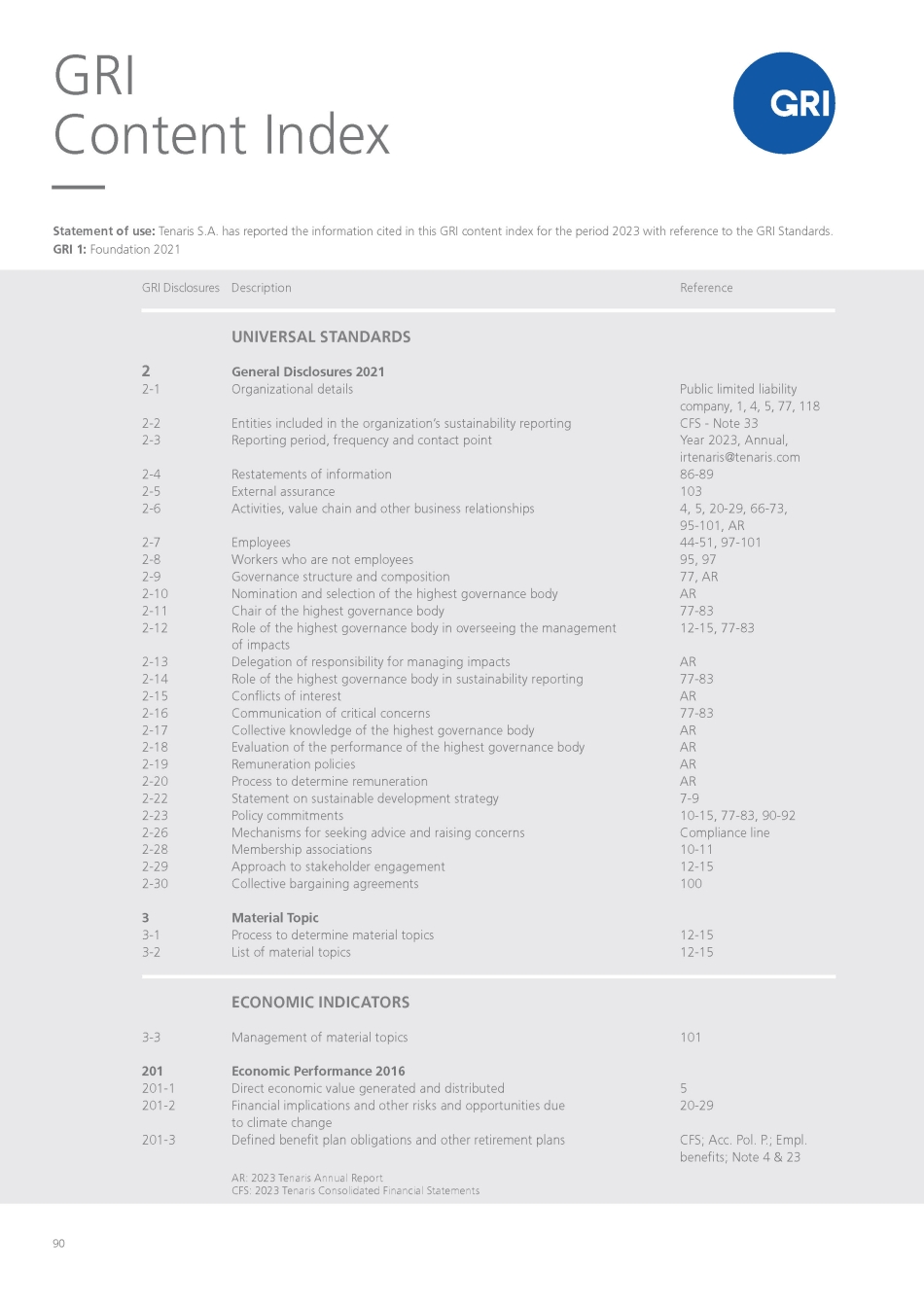
Reference Description GRI Disclosures UNIVERSAL STANDARDS General Disclosures 2021 2 Public limited liability Organizational details 2 - 1 company, 1, 4, 5, 77, 118 CFS - Note 33 Entities included in the organization’s sustainability reporting 2 - 2 Year 2023, Annual, Reporting period, frequency and contact point 2 - 3 irtenaris@tenaris.com 86 - 89 Restatements of information 2 - 4 103 External assurance 2 - 5 4, 5, 20 - 29, 66 - 73, Activities, value chain and other business relationships 2 - 6 95 - 101, AR 44 - 51, 97 - 101 Employees 2 - 7 95, 97 Workers who are not employees 2 - 8 77, AR Governance structure and composition 2 - 9 AR Nomination and selection of the highest governance body 2 - 10 77 - 83 Chair of the highest governance body 2 - 11 12 - 15, 77 - 83 Role of the highest governance body in overseeing the management 2 - 12 of impacts AR Delegation of responsibility for managing impacts 2 - 13 77 - 83 Role of the highest governance body in sustainability reporting 2 - 14 AR Conflicts of interest 2 - 15 77 - 83 Communication of critical concerns 2 - 16 AR Collective knowledge of the highest governance body 2 - 17 AR Evaluation of the performance of the highest governance body 2 - 18 AR Remuneration policies 2 - 19 AR Process to determine remuneration 2 - 20 7 - 9 Statement on sustainable development strategy 2 - 22 10 - 15, 77 - 83, 90 - 92 Policy commitments 2 - 23 Compliance line Mechanisms for seeking advice and raising concerns 2 - 26 10 - 11 Membership associations 2 - 28 12 - 15 Approach to stakeholder engagement 2 - 29 100 Collective bargaining agreements 2 - 30 Material Topic 3 12 - 15 Process to determine material topics 3 - 1 12 - 15 List of material topics 3 - 2 ECONOMIC INDICATORS 101 Management of material topics 3 - 3 Economic Performance 2016 201 5 Direct economic value generated and distributed 201 - 1 20 - 29 Financial implications and other risks and opportunities due 201 - 2 to climate change CFS; Acc. Pol. P.; Empl. Defined benefit plan obligations and other retirement plans 201 - 3 benefits; Note 4 & 23 AR: 2023 Tenaris Annual Report CFS: 2023 Tenaris Consolidated Financial Statements 90 GRI Content Index Statement of use: Tenaris S.A. has reported the information cited in this GRI content index for the period 2023 with reference to the GRI Standards. GRI 1: Foundation 2021
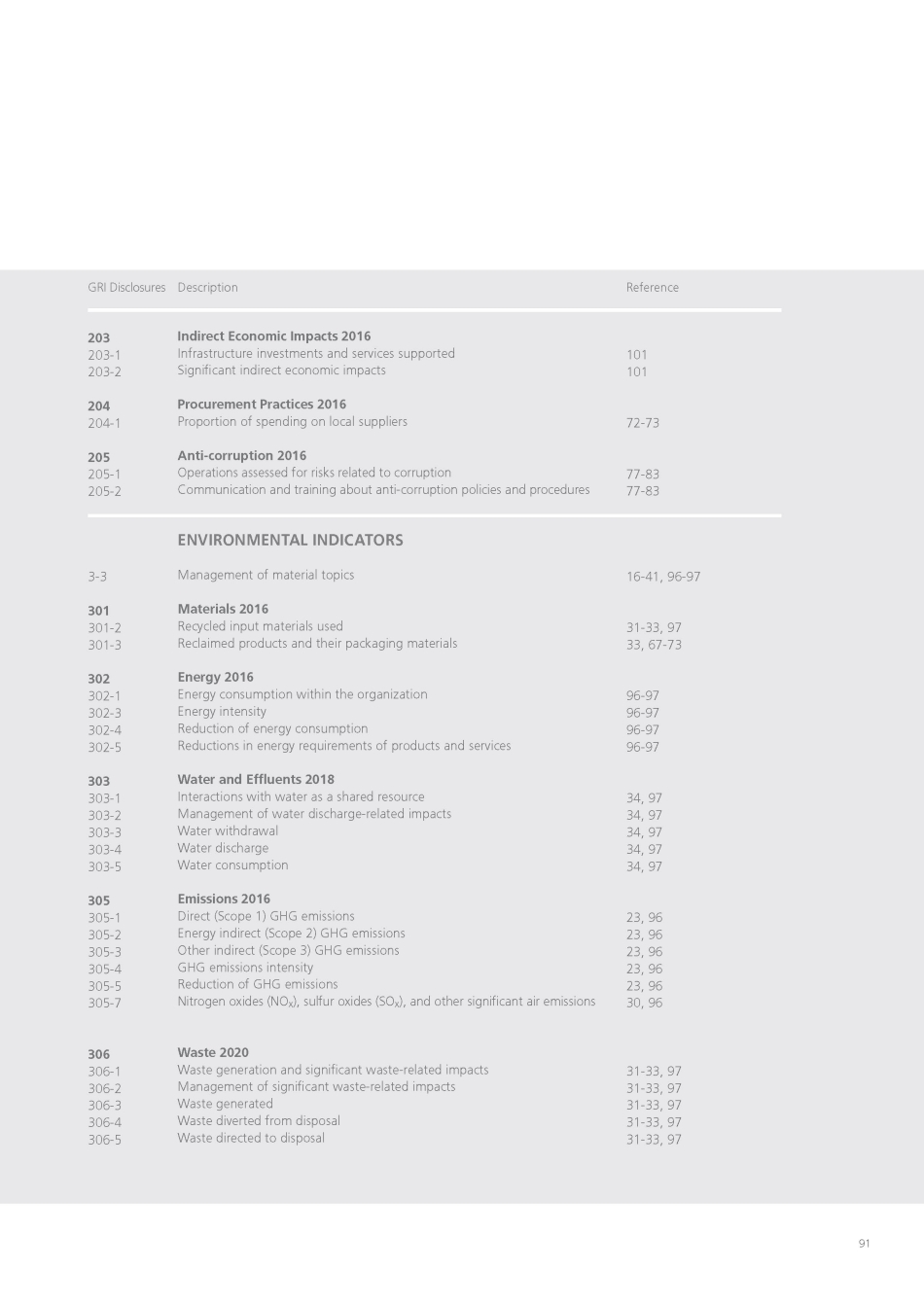
91 Reference Description GRI Disclosures Indirect Economic Impacts 2016 203 101 Infrastructure investments and services supported 203 - 1 101 Significant indirect economic impacts 203 - 2 Procurement Practices 2016 204 72 - 73 Proportion of spending on local suppliers 204 - 1 Anti - corruption 2016 205 77 - 83 Operations assessed for risks related to corruption 205 - 1 77 - 83 Communication and training about anti - corruption policies and procedures 205 - 2 ENVIRONMENTAL INDICATORS 16 - 41, 96 - 97 Management of material topics 3 - 3 Materials 2016 301 31 - 33, 97 Recycled input materials used 301 - 2 33, 67 - 73 Reclaimed products and their packaging materials 301 - 3 Energy 2016 302 96 - 97 Energy consumption within the organization 302 - 1 96 - 97 Energy intensity 302 - 3 96 - 97 Reduction of energy consumption 302 - 4 96 - 97 Reductions in energy requirements of products and services 302 - 5 Water and Effluents 2018 303 34, 97 Interactions with water as a shared resource 303 - 1 34, 97 Management of water discharge - related impacts 303 - 2 34, 97 Water withdrawal 303 - 3 34, 97 Water discharge 303 - 4 34, 97 Water consumption 303 - 5 Emissions 2016 305 23, 96 Direct (Scope 1) GHG emissions 305 - 1 23, 96 Energy indirect (Scope 2) GHG emissions 305 - 2 23, 96 Other indirect (Scope 3) GHG emissions 305 - 3 23, 96 GHG emissions intensity 305 - 4 23, 96 Reduction of GHG emissions 305 - 5 30, 96 Nitrogen oxides (NO x ), sulfur oxides (SO x ), and other significant air emissions 305 - 7 Waste 2020 306 31 - 33, 97 Waste generation and significant waste - related impacts 306 - 1 31 - 33, 97 Management of significant waste - related impacts 306 - 2 31 - 33, 97 Waste generated 306 - 3 31 - 33, 97 Waste diverted from disposal 306 - 4 31 - 33, 97 Waste directed to disposal 306 - 5
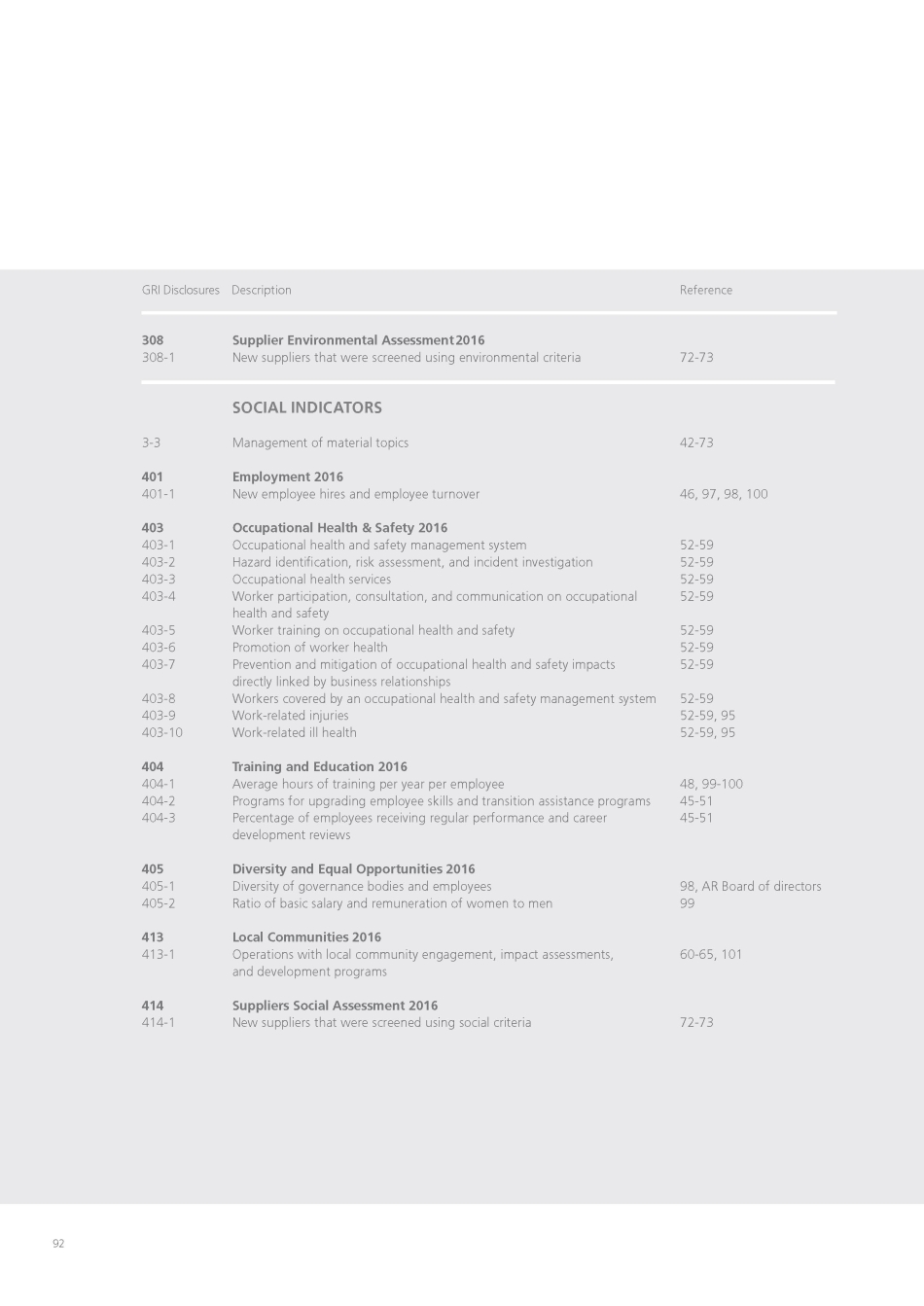
92 Reference Description GRI Disclosures Supplier Environmental Assessment 2016 308 72 - 73 New suppliers that were screened using environmental criteria 308 - 1 SOCIAL INDICATORS 42 - 73 Management of material topics 3 - 3 Employment 2016 401 46, 97, 98, 100 New employee hires and employee turnover 401 - 1 Occupational Health & Safety 2016 403 52 - 59 Occupational health and safety management system 403 - 1 52 - 59 Hazard identification, risk assessment, and incident investigation 403 - 2 52 - 59 Occupational health services 403 - 3 52 - 59 Worker participation, consultation, and communication on occupational 403 - 4 52 - 59 health and safety Worker training on occupational health and safety 403 - 5 52 - 59 Promotion of worker health 403 - 6 52 - 59 Prevention and mitigation of occupational health and safety impacts 403 - 7 52 - 59 directly linked by business relationships Workers covered by an occupational health and safety management system 403 - 8 52 - 59, 95 Work - related injuries 403 - 9 52 - 59, 95 Work - related ill health 403 - 10 Training and Education 2016 404 48, 99 - 100 Average hours of training per year per employee 404 - 1 45 - 51 Programs for upgrading employee skills and transition assistance programs 404 - 2 45 - 51 Percentage of employees receiving regular performance and career development reviews 404 - 3 Diversity and Equal Opportunities 2016 405 98, AR Board of directors Diversity of governance bodies and employees 405 - 1 99 Ratio of basic salary and remuneration of women to men 405 - 2 Local Communities 2016 413 60 - 65, 101 Operations with local community engagement, impact assessments, and development programs 413 - 1 Suppliers Social Assessment 2016 414 72 - 73 New suppliers that were screened using social criteria 414 - 1
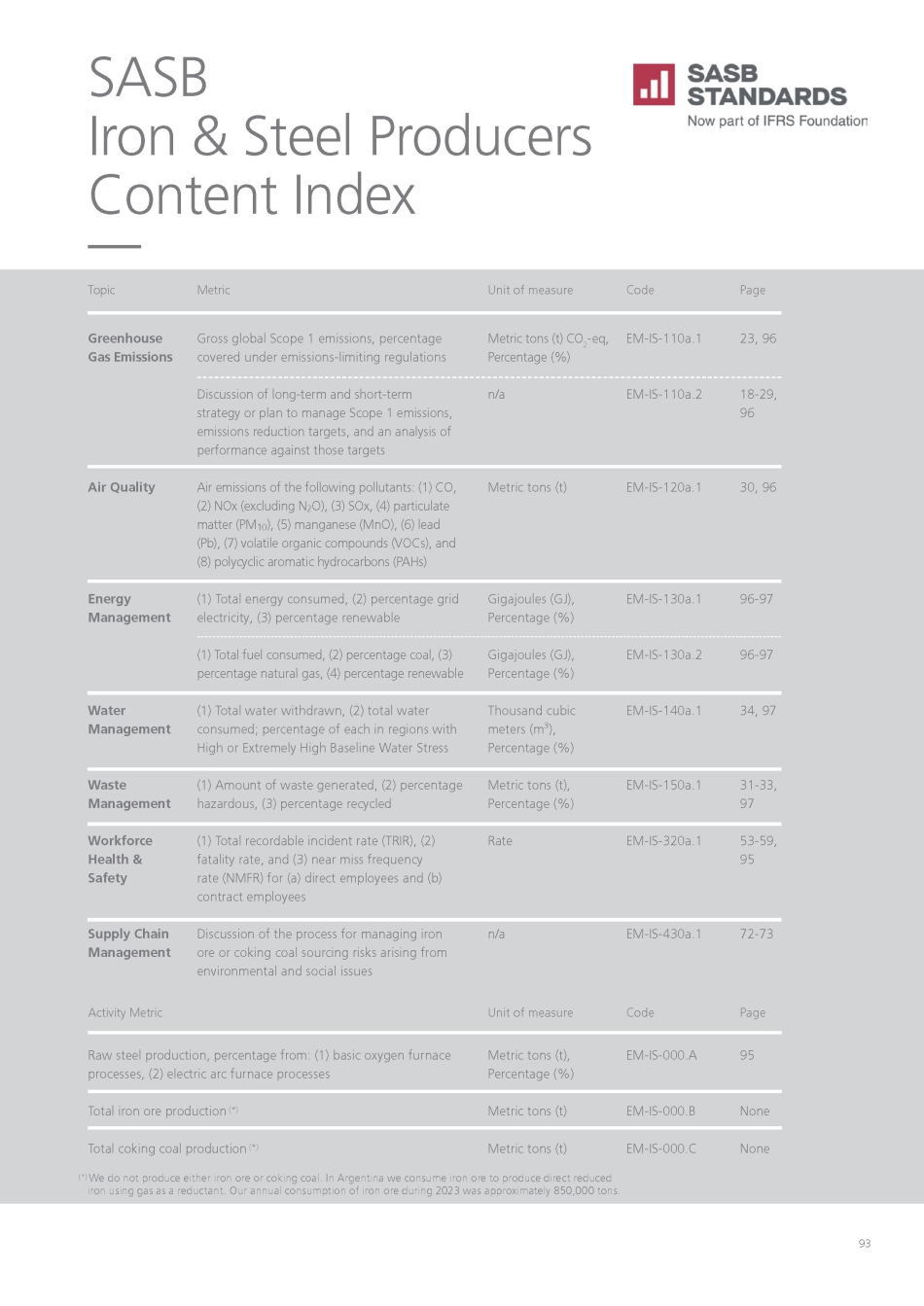
93 SASB Iron & Steel Producers Content Index Gross global Scope 1 emissions, percentage covered under emissions - limiting regulations Discussion of long - term and short - term strategy or plan to manage Scope 1 emissions, emissions reduction targets, and an analysis of performance against those targets Air emissions of the following pollutants: (1) CO, (2) NOx (excluding N 2 O), (3) SOx, (4) particulate matter (PM 10 ), (5) manganese (MnO), (6) lead (Pb), (7) volatile organic compounds (VOCs), and (8) polycyclic aromatic hydrocarbons (PAHs) (1) Total energy consumed, (2) percentage grid electricity, (3) percentage renewable (1) Total fuel consumed, (2) percentage coal, (3) percentage natural gas, (4) percentage renewable (1) Total water withdrawn, (2) total water consumed; percentage of each in regions with High or Extremely High Baseline Water Stress (1) Amount of waste generated, (2) percentage hazardous, (3) percentage recycled (1) Total recordable incident rate (TRIR), (2) fatality rate, and (3) near miss frequency rate (NMFR) for (a) direct employees and (b) contract employees Discussion of the process for managing iron ore or coking coal sourcing risks arising from environmental and social issues Metric Raw steel production, percentage from: (1) basic oxygen furnace processes, (2) electric arc furnace processes Total iron ore production (*) Activity Metric Code EM - IS - 110a.1 EM - IS - 110a.2 EM - IS - 120a.1 EM - IS - 130a.1 EM - IS - 130a.2 EM - IS - 140a.1 EM - IS - 150a.1 EM - IS - 320a.1 EM - IS - 430a.1 Code EM - IS - 000.A EM - IS - 000.B EM - IS - 000.C Unit of measure Metric tons (t) CO 2 - eq, Percentage (%) n/a Metric tons (t) Gigajoules (GJ), Percentage (%) Gigajoules (GJ), Percentage (%) Thousand cubic meters (m³), Percentage (%) Metric tons (t), Percentage (%) Rate n/a Unit of measure Metric tons (t), Percentage (%) Metric tons (t) Topic Greenhouse Gas Emissions Air Quality Energy Management Water Management Waste Management Workforce Health & Safety Supply Chain Management Page 23, 96 18 - 29, 96 30, 96 96 - 97 96 - 97 34, 97 31 - 33, 97 53 - 59, 95 72 - 73 Page 95 None None Total coking coal production (*) Metric tons (t) (*) We do not produce either iron ore or coking coal. In Argentina we consume iron ore to produce direct reduced iron using gas as a reductant. Our annual consumption of iron ore during 2023 was approximately 850,000 tons.
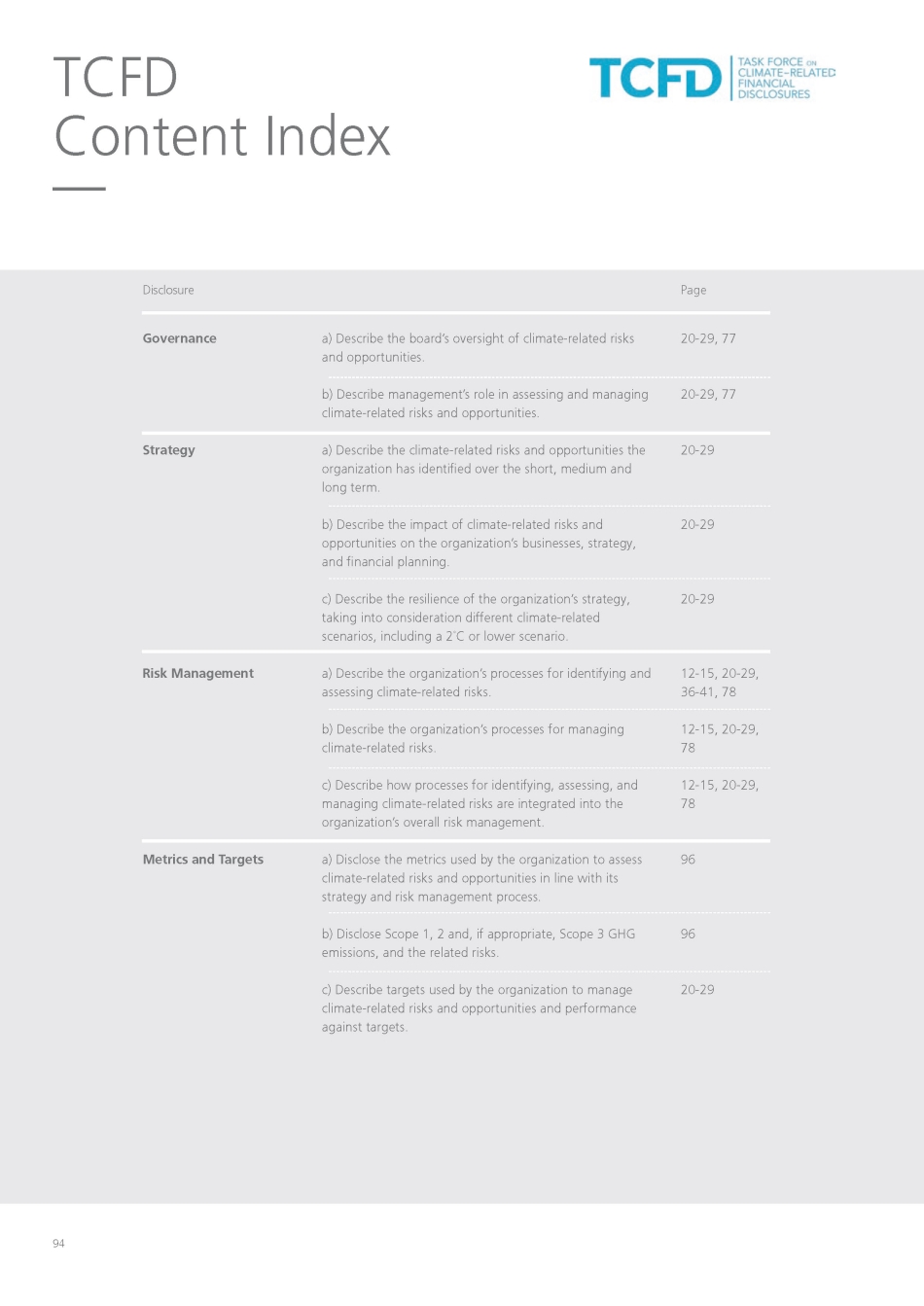
94 TCFD Content Index a) Describe the board’s oversight of climate - related risks and opportunities. b) Describe management’s role in assessing and managing climate - related risks and opportunities. a) Describe the climate - related risks and opportunities the organization has identified over the short, medium and long term. b) Describe the impact of climate - related risks and opportunities on the organization’s businesses, strategy, and financial planning. c) Describe the resilience of the organization’s strategy, taking into consideration different climate - related scenarios, including a 2˚C or lower scenario. a) Describe the organization’s processes for identifying and assessing climate - related risks. b) Describe the organization’s processes for managing climate - related risks. c) Describe how processes for identifying, assessing, and managing climate - related risks are integrated into the organization’s overall risk management. a) Disclose the metrics used by the organization to assess climate - related risks and opportunities in line with its strategy and risk management process. b) Disclose Scope 1, 2 and, if appropriate, Scope 3 GHG emissions, and the related risks. c) Describe targets used by the organization to manage climate - related risks and opportunities and performance against targets. Disclosure Governance Strategy Risk Management Metrics and Targets Page 20 - 29, 77 20 - 29, 77 20 - 29 20 - 29 20 - 29 12 - 15, 20 - 29, 36 - 41, 78 12 - 15, 20 - 29, 78 12 - 15, 20 - 29, 78 96 96 20 - 29
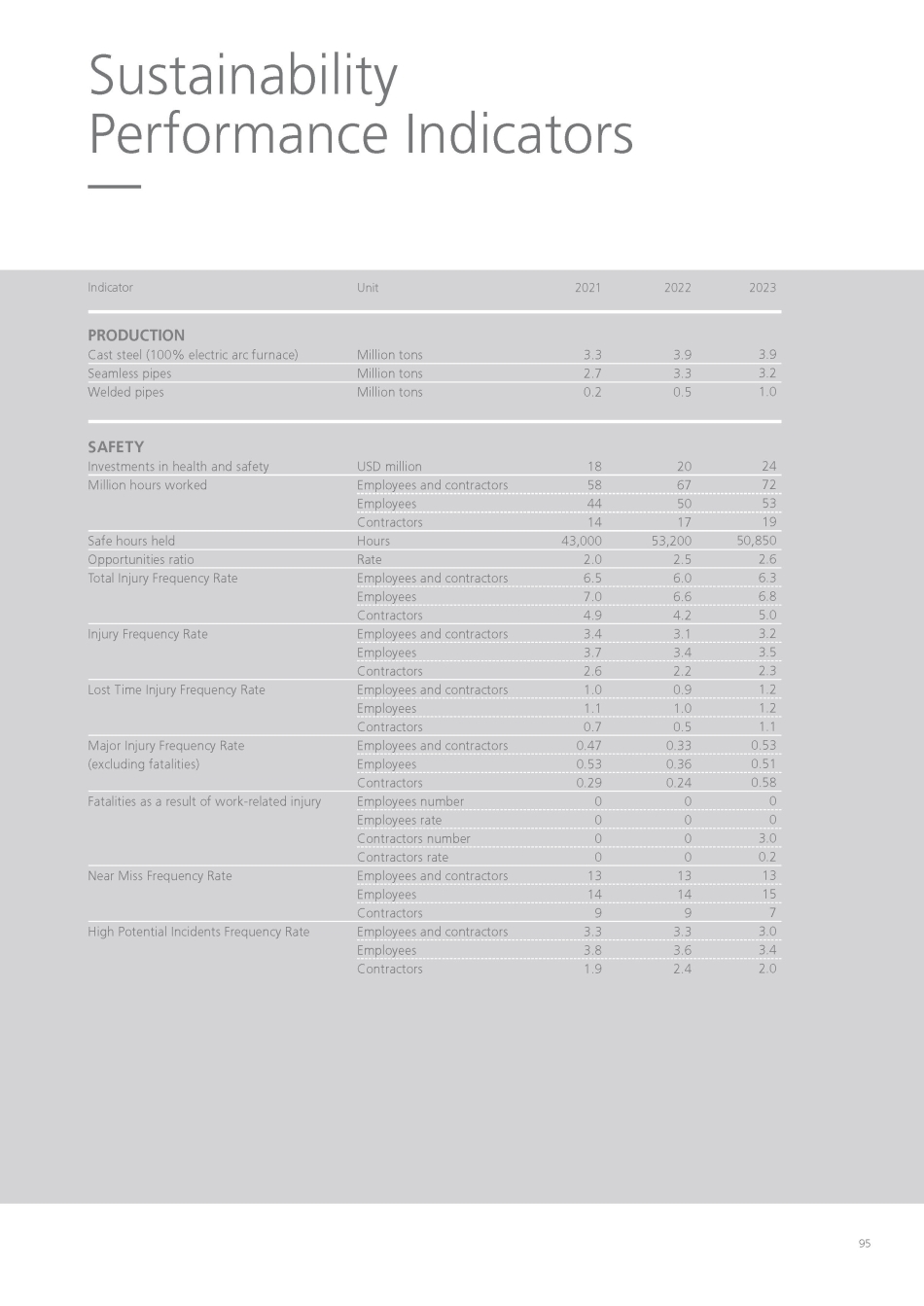
95 2023 2022 2021 Unit Indicator 3.9 3.9 3.3 Million tons PRODUCTION Cast steel (100% electric arc furnace) 3.2 3.3 2.7 Million tons Seamless pipes 1.0 0.5 0.2 Million tons Welded pipes 24 20 18 USD million SAFETY Investments in health and safety 72 67 58 Employees and contractors Million hours worked 53 50 44 Employees 19 17 14 Contractors 50,850 53,200 43,000 Hours Safe hours held 2.6 2.5 2.0 Rate Opportunities ratio 6.3 6.0 6.5 Employees and contractors Total Injury Frequency Rate 6.8 6.6 7.0 Employees 5.0 4.2 4.9 Contractors 3.2 3.1 3.4 Employees and contractors Injury Frequency Rate 3.5 3.4 3.7 Employees 2.3 2.2 2.6 Contractors 1.2 0.9 1.0 Employees and contractors Lost Time Injury Frequency Rate 1.2 1.0 1.1 Employees 1.1 0.5 0.7 Contractors 0.53 0.33 0.47 Employees and contractors Major Injury Frequency Rate 0.51 0.36 0.53 Employees (excluding fatalities) 0.58 0.24 0.29 Contractors 0 0 0 Employees number Fatalities as a result of work - related injury 0 0 0 Employees rate 3.0 0 0 Contractors number 0.2 0 0 Contractors rate 13 13 13 Employees and contractors Near Miss Frequency Rate 15 14 14 Employees 7 9 9 Contractors 3.0 3.3 3.3 Employees and contractors High Potential Incidents Frequency Rate 3.4 3.6 3.8 Employees 2.0 2.4 1.9 Contractors Sustainability Performance Indicators

96 2023 2022 2021 Unit Indicator 191 110 22 USD million ENVIRONMENT Investments in environment and energy savings Emissions Greenhouse gas emissions CO 2 emissions from all sites 2.1 2.1 1.9 CO 2 - eq million tons Scope 1 emissions 1.0 1.1 0.9 CO 2 - eq million tons Scope 2 emissions - Market based 2.9 2.5 1.8 CO 2 - eq million tons Scope 3 emissions - Category 1 - Purchased goods and services 1.18 1.18 1.17 Ton CO 2 - eq /ton steel cast/processed Intensity - 17 - 17 - 18 % Intensity from all sites vs. 2018 1.1 1.1 CO 2 - eq million tons Scope 2 emissions - Location based 0.4 0.4 0.4 CO 2 - eq million tons Scope 3 emissions - Category 3 - Fuel - and energy - related activities 0.1 0.1 – CO 2 - eq million tons Scope 3 emissions - Category 4 - Upstream transportation and distribution 0.8 0.7 0.9 CO 2 - eq million tons Scope 3 emissions - Category 9 - Downstream transportation and distribution 87 88 92 % Scope 1 emissions from all sites covered under emissions - limiting regulations 79 77 78 % Recycling content in our steel Air emissions 19 17 17 g/ton product Particulate material emissions 0.7 0.8 1.2 Kg/ton product Nitrogen oxides emissions 239 221 396 g/ton product Volatile organic compound emissions from pipe & coupling varnishing Energy management 42,458 48,615 40,828 Terajoules (TJ) Total energy consumed 1,691 615 368 TJ Consumption of renewable electricity (per TS market decision) 4 1 1 % Share of renewable in total energy consumption 12 4 3 % Share of renewables in total electricity consumption 11,658 12,466 9,828 TJ Total electricity consumed from the grid 80 86 80 % Total electricity consumed from the grid 468 317 669 TJ Electricity generated and sold 4,023 4,036 3,433 GWh Total electricity consumption 470 171 102 GWh Consumption of renewable electricity (per TS market decision) 915 662 889 GWh Self generation of electricity 114 – – GWh Self generation of renewable electricity

97 2023 2022 2021 Unit Indicator 27,974 36,149 31,246 TJ Total fuel consumed 92 94 93 % - of which natural gas 7 5 6 % - of which coal 2 1 1 % - of which other (e.g., diesel and gasoline) 9 10 11 GJ/ton processed steel Energy intensity from all sites Water management 64.5 53.0 49.7 Million m 3 Water withdrawal 78 74 73 % - of which surface 20 23 22 % - of which subsurface 3 4 5 % - of which network 16 16 17 m 3 water/ton pipe Intensity of water withdrawal at all sites 4 5 6 m 3 water/ton pipe Intensity of water withdrawal excluding Siderca 2 3 1 m 3 water/ton pipe Estimated water consumed at all sites 0.3 1.2 1.4 % Water withdrawal from high or extremely high baseline water stress Waste Management Co - products and waste 98.2 97.8 99.0 % Material efficiency at sites w/steelshops 87.7 82.1 83.3 % Residue & co - products reuse or recycle at all sites 9.1 10.8 6.5 % Waste disposal at all sites 928,168 953,882 727,005 ton Total tons of wasted and co products produced (scrap not included) 122,437 117,926 79,485 ton Total ton of hazardous wastes 152,972 191,270 118,083 ton Total ton of non hazardous wastes 652,759 644,686 529,437 ton Total tons of co - products (slag, scale, DRI, iron ore fines co - products) produced HUMAN CAPITAL Employees at year - end 22,712 19,765 17,671 People Shop floor 21,547 18,788 16,966 People - of which male 1,165 977 705 People - of which female 95 95 96 % - of which male 5 5 4 % - of which female 6,422 5,527 5,105 People Professional 4,499 3,868 3,602 People - of which male 1,923 1,659 1,503 People - of which female 70 70 71 % - of which male 30 30 29 % - of which female

2023 2022 2021 Unit Indicator 29,134 25,292 22,776 People Total employees (full - time) 26,046 22,656 20,568 People - of which male 3,088 2,636 2,208 People - of which female 89 90 90 % - of which male 11 10 10 % - of which female 754 590 493 People Trainees (part - time) 413 293 301 People - of which male 341 297 192 People - of which female 55 50 61 % - of which male 45 50 39 % - of which female 1,098 1,016 975 People Senior managers by gender Total 949 885 854 People Male 149 131 121 People Female 86 87 88 % Male 14 13 12 % Female 7,480 6,555 5,013 People Age ranges Employees under 30 6,318 5,566 4,323 People - of which male 1,162 989 690 People - of which female 84 85 86 % - of which male 16 15 14 % - of which female 16,788 14,623 13,912 People Employees between 30 and 50 15,225 13,274 12,674 People - of which male 1,563 1,349 1,238 People - of which female 91 91 91 % - of which male 9 9 9 % - of which female 4,866 4,114 3,851 People Employees over 50 4,503 3,816 3,571 People - of which male 363 298 280 People - of which female 93 93 93 % - of which male 7 7 7 % - of which female 39 39 40 Years Average age of workforce 1,481 1,247 961 People Age ranges for professional employees Professionals under 30 846 725 557 People - of which male 635 522 404 People - of which female 57 58 58 % - of which male 43 42 42 % - of which female 3,814 3,386 3,308 People Professionals between 30 and 50 2,768 2,449 2,382 People - of which male 1,046 937 926 People - of which female 73 72 72 % - of which male 27 28 28 % - of which female 98
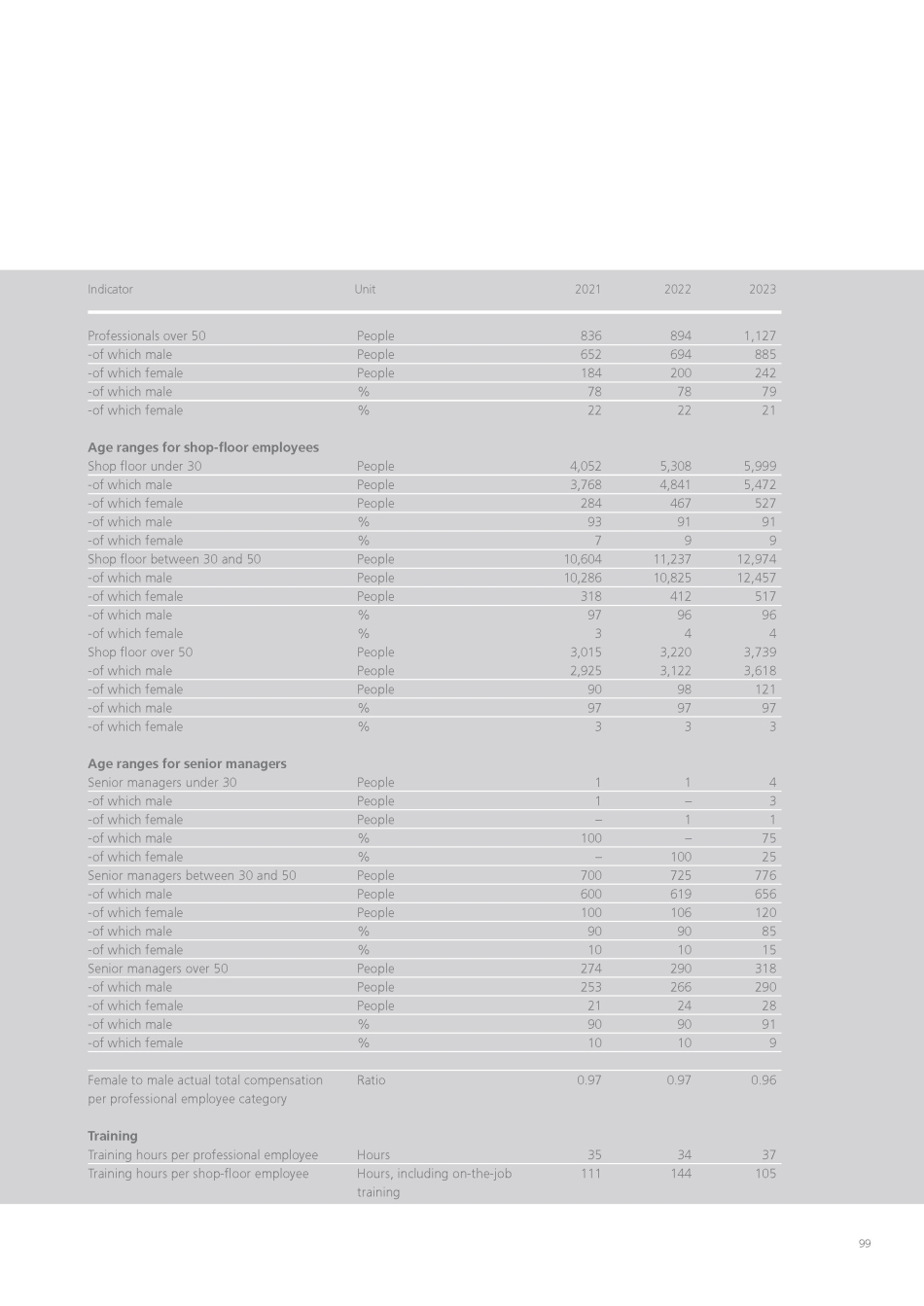
2023 2022 2021 Unit Indicator 1,127 894 836 People Professionals over 50 885 694 652 People - of which male 242 200 184 People - of which female 79 78 78 % - of which male 21 22 22 % - of which female 5,999 5,308 4,052 People Age ranges for shop - floor employees Shop floor under 30 5,472 4,841 3,768 People - of which male 527 467 284 People - of which female 91 91 93 % - of which male 9 9 7 % - of which female 12,974 11,237 10,604 People Shop floor between 30 and 50 12,457 10,825 10,286 People - of which male 517 412 318 People - of which female 96 96 97 % - of which male 4 4 3 % - of which female 3,739 3,220 3,015 People Shop floor over 50 3,618 3,122 2,925 People - of which male 121 98 90 People - of which female 97 97 97 % - of which male 3 3 3 % - of which female 4 1 1 People Age ranges for senior managers Senior managers under 30 3 – 1 People - of which male 1 1 – People - of which female 75 – 100 % - of which male 25 100 – % - of which female 776 725 700 People Senior managers between 30 and 50 656 619 600 People - of which male 120 106 100 People - of which female 85 90 90 % - of which male 15 10 10 % - of which female 318 290 274 People Senior managers over 50 290 266 253 People - of which male 28 24 21 People - of which female 91 90 90 % - of which male 9 10 10 % - of which female 0.96 0.97 0.97 Ratio Female to male actual total compensation per professional employee category 37 34 35 Hours Training Training hours per professional employee 105 144 111 Hours, including on - the - job training Training hours per shop - floor employee 99
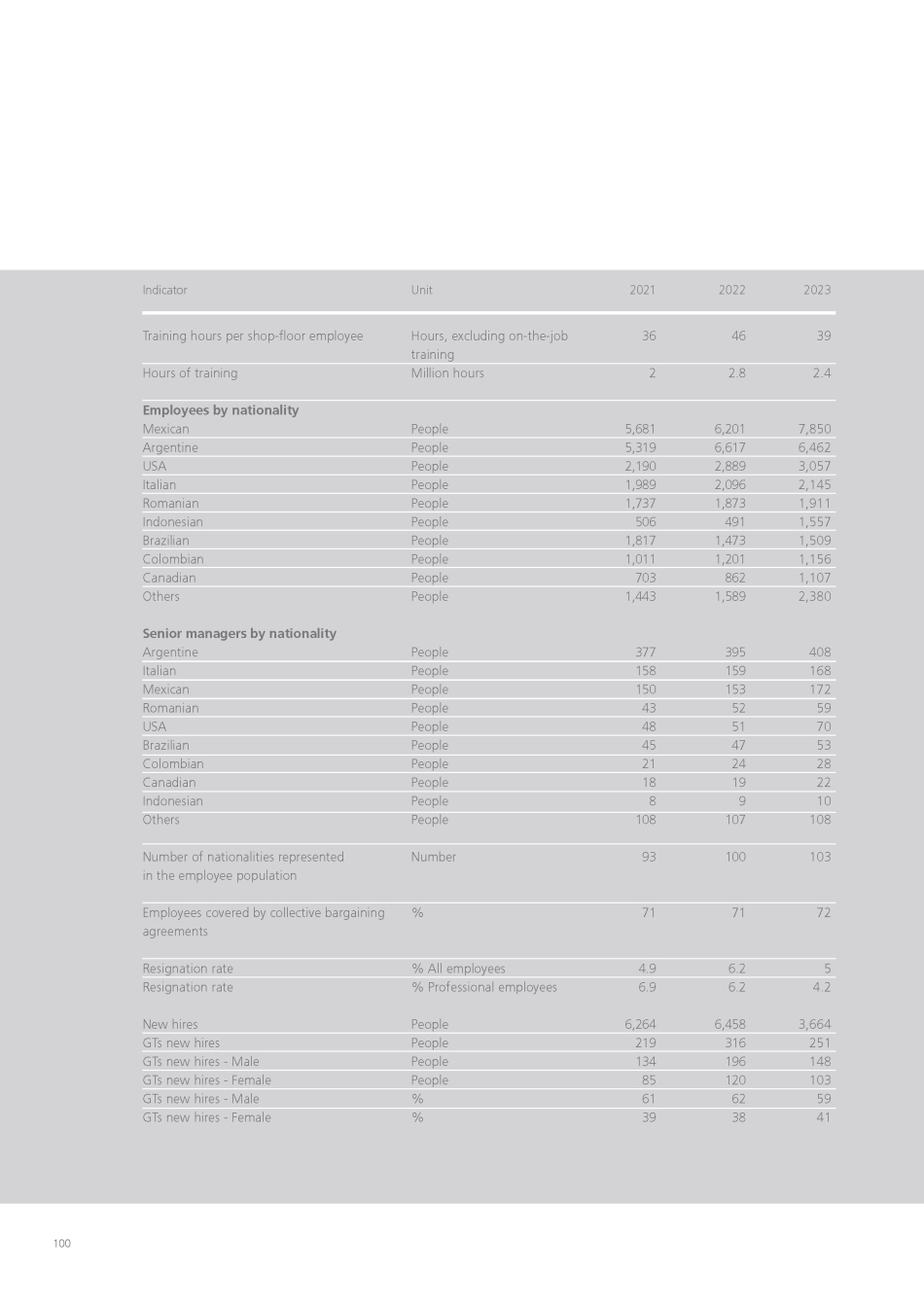
100 2023 2022 2021 Unit Indicator 39 46 36 Hours, excluding on - the - job training Training hours per shop - floor employee 2.4 2.8 2 Million hours Hours of training 7,850 6,201 5,681 People Employees by nationality Mexican 6,462 6,617 5,319 People Argentine 3,057 2,889 2,190 People USA 2,145 2,096 1,989 People Italian 1,911 1,873 1,737 People Romanian 1,557 491 506 People Indonesian 1,509 1,473 1,817 People Brazilian 1,156 1,201 1,011 People Colombian 1,107 862 703 People Canadian 2,380 1,589 1,443 People Others 408 395 377 People Senior managers by nationality Argentine 168 159 158 People Italian 172 153 150 People Mexican 59 52 43 People Romanian 70 51 48 People USA 53 47 45 People Brazilian 28 24 21 People Colombian 22 19 18 People Canadian 10 9 8 People Indonesian 108 107 108 People Others 103 100 93 Number Number of nationalities represented in the employee population 72 71 71 % Employees covered by collective bargaining agreements 5 6.2 4.9 % All employees Resignation rate 4.2 6.2 6.9 % Professional employees Resignation rate 3,664 6,458 6,264 People New hires 251 316 219 People GTs new hires 148 196 134 People GTs new hires - Male 103 120 85 People GTs new hires - Female 59 62 61 % GTs new hires - Male 41 38 39 % GTs new hires - Female

101 2023 2022 2021 Unit Indicator Employee participation in global management programs 209 162 86 People TUIC 109 96 0 People MDP 54 0 0 People AMP 0 42 0 People LP 32 33 36 People BA 110 77 83 People ME 13.1 10 4.5 USD millions COMMUNITY Education investment – 0.4 0.1 USD millions COVID - 19 fund 2.4 3.0 2.3 USD millions Other community investment 15.5 13.4 6.9 USD millions Total community investment 444 436 428 N ƒ of students ETRR students 830 526 322 N ƒ of students ETRR Students trained from other schools 5,196 3,216 5,656 N ƒ of students Roberto Rocca Technical Gene 148 328 113 N ƒ of teachers Roberto Rocca Technical Gene 2,026 1,482 1,492 N ƒ of students Roberto Rocca After School Program 527 542 484 N ƒ of students Roberto Rocca Education Program University & PhD 1,325 1,843 1,222 N ƒ of students Roberto Rocca Scholarships Program - High school ECONOMIC AND FINANCIAL (*) 14,869 11,763 6,521 USD millions Net sales 4,316 2,963 708 USD millions Operating income 4,865 3,648 1,359 USD millions EBITDA 33 31 21 % of net sales EBITDA margin 3,918 2,553 1,100 USD millions Net income attributable to shareholders’ equity 16,843 13,906 11,961 USD millions Capital and reserves attributable to shareholders’ equity 4,395 1,167 119 USD millions Net cash provided by operating activities 619 378 240 USD millions Capital expenditures 60 51 45 USD millions R&D investments 700 602 484 USD millions Dividends 3,422 921 700 USD millions Net cash position 25 20 9 % Return on equity 33 24 7 % Return on capital employed 25 7 - 2 % of net sales FCF Margin (*) This report includes non - IFRS alternative financial performance measures e.g., EBITDA and Net cash position. See the “Accounting policies” section for specifications on methodologies and criteria used to calculate the performance indicators included in the report.
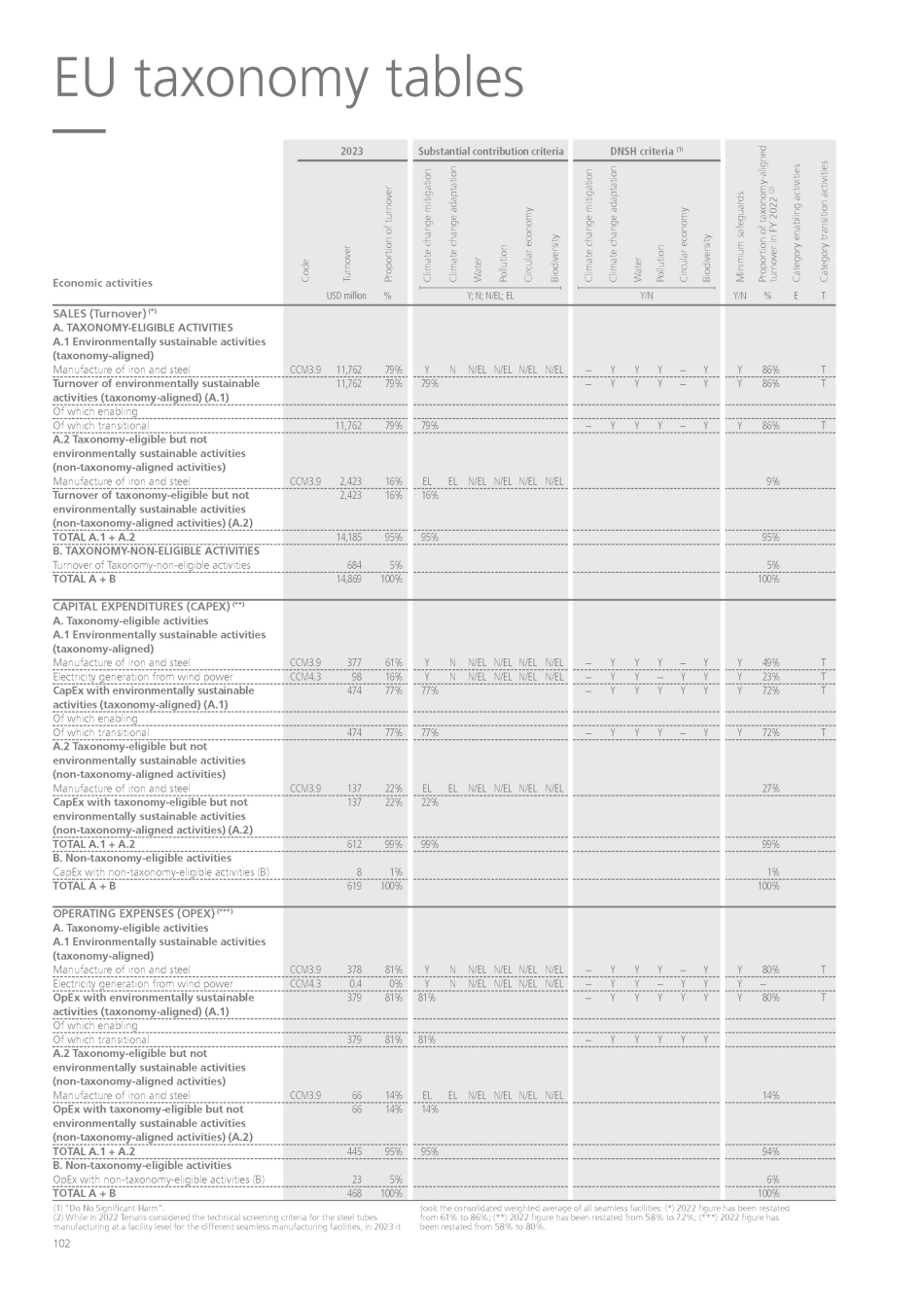
Substantial contribution criteria 2023 llution mate change adaptation diversity mate change mitigation cular economy ater Electricity generation from wind power de CCM4.3 nover 0.4 oportion of turnover nimum safeguards oportion of taxonomy - aligned nover in FY 2022 (2) Y − mate change mitigation ater tegory enabling activities tegory transition activities mate change adaptation diversity DNSH criteria (1) EU taxonomy tables (1) “Do No Significant Harm”. (2) While in 2022 Tenaris considered the technical screening criteria for the steel tubes manufacturing at a facility level for the different seamless manufacturing facilities, in 2023 it 102 took the consolidated weighted average of all seamless facilities: (*) 2022 figure has been restated from 61% to 86%; (**) 2022 figure has been restated from 58% to 72%; (***) 2022 figure has been restated from 58% to 80%. llution cular economy C a C a P r t u r M i B i o C i r Po W C li C li B i o W P o C i r C li Cl i P r T u r C o Economic activities T E % Y/N Y/N Y; N; N/EL; EL % USD million SALES (Turnover) (*) A. TAXONOMY - ELIGIBLE ACTIVITIES A.1 Environmentally sustainable activities (taxonomy - aligned) T 86% Y Y − Y Y Y − N/EL N/EL N/EL N/EL N Y 79% 11,762 CCM3.9 Manufacture of iron and steel T 86% Y Y − Y Y Y − 79% 79% 11,762 Turnover of environmentally sustainable activities (taxonomy - aligned) (A.1) Of which enabling T 86% Y Y − Y Y Y − 79% 79% 11,762 Of which transitional A.2 Taxonomy - eligible but not environmentally sustainable activities (non - taxonomy - aligned activities) 9% N/EL N/EL N/EL N/EL EL EL 16% 2,423 CCM3.9 Manufacture of iron and steel 16% 16% 2,423 Turnover of taxonomy - eligible but not environmentally sustainable activities (non - taxonomy - aligned activities) (A.2) 95% 95% 95% 14,185 TOTAL A.1 + A.2 B. TAXONOMY - NON - ELIGIBLE ACTIVITIES 5% 5% 684 Turnover of Taxonomy - non - eligible activities 100% 100% 14,869 TOTAL A + B CAPITAL EXPENDITURES (CAPEX) (**) A. Taxonomy - eligible activities A.1 Environmentally sustainable activities (taxonomy - aligned) T 49% Y Y − Y Y Y − N/EL N/EL N/EL N/EL N Y 61% 377 CCM3.9 Manufacture of iron and steel T 23% Y Y Y − Y Y − N/EL N/EL N/EL N/EL N Y 16% 98 CCM4.3 Electricity generation from wind power T 72% Y Y Y Y Y Y − 77% 77% 474 CapEx with environmentally sustainable activities (taxonomy - aligned) (A.1) Of which enabling T 72% Y Y − Y Y Y − 77% 77% 474 Of which transitional A.2 Taxonomy - eligible but not environmentally sustainable activities (non - taxonomy - aligned activities) 27% N/EL N/EL N/EL N/EL EL EL 22% 137 CCM3.9 Manufacture of iron and steel 22% 22% 137 CapEx with taxonomy - eligible but not environmentally sustainable activities (non - taxonomy - aligned activities) (A.2) 99% 99% 99% 612 TOTAL A.1 + A.2 B. Non - taxonomy - eligible activities 1% 1% 8 CapEx with non - taxonomy - eligible activities (B) 100% 100% 619 TOTAL A + B OPERATING EXPENSES (OPEX) (***) A. Taxonomy - eligible activities A.1 Environmentally sustainable activities (taxonomy - aligned) T 80% Y Y − Y Y Y − N/EL N/EL N/EL N/EL N Y 81% 378 CCM3.9 Manufacture of iron and steel 0% Y N N/EL N/EL N/EL N/EL − Y Y − Y Y T 80% Y Y Y Y Y Y − 81% 81% 379 OpEx with environmentally sustainable activities (taxonomy - aligned) (A.1) Of which enabling Y Y Y Y Y − 81% 81% 379 Of which transitional 14% N/EL N/EL N/EL N/EL EL EL 14% 66 CCM3.9 A.2 Taxonomy - eligible but not environmentally sustainable activities (non - taxonomy - aligned activities) Manufacture of iron and steel 14% 14% 66 OpEx with taxonomy - eligible but not environmentally sustainable activities (non - taxonomy - aligned activities) (A.2) 94% 95% 95% 445 TOTAL A.1 + A.2 6% 5% 23 B. Non - taxonomy - eligible activities OpEx with non - taxonomy - eligible activities (B) 100% 100% 468 TOTAL A + B

Independent Limited Assurance Report

PricewaterhouseCoopers, Société coopérative, 2 rue Gerhard Mercator, B.P. 1443, L - 1014 Luxembourg T : +352 494848 1, F : +352 494848 2900, www.pwc.lu Cabinet de révision agréé. Expert - comptable (autorisation gouvernementale n ƒ 10028256) R.C.S. Luxembourg B 65 477 - TVA LU25482518 Independent Limited Assurance Report on a selection of Key Performance Indicators disclosed in Sustainability Report 2023 To the Board of Directors of Tenaris S.A. 26, Boulevard Royal L - 2449 Luxembourg We have performed a limited assurance engagement with respect to a selection of Key Performance Indicators disclosed in the Sustainability Report 2023 (the “Sustainability Report”) of Tenaris S . A . (the “Company”) for the year ended 31 December 2023 as set out in the “Scope” section below . Scope The scope of our work was limited to provide limited assurance over the selected Key Performance Indicators as set out in the Exhibit 1 attached (the “Selected Information”) . Our assurance was with respect to the year ended 31 December 2023 information only and we have not performed any procedures with respect to earlier periods or any other elements included in the 2023 Sustainability Report and, therefore, do not express any conclusion thereon . The Assessment Criteria The Selected Information was prepared in accordance with certain sections of the Global Reporting Initiative (GRI) and of the Sustainability Accounting Standards Board (SASB) frameworks and additional methodologies defined by Company policies (together the “Assessment Criteria”) for the year ending 31 December 2023 , accompanying the KPI disclosures in the Sustainability Report . Management considers the Assessment Criteria relevant for the purpose of the Company’s business and for the ultimate users of the Sustainability Report . Responsibilities of the Board of Directors The Board of Directors of the Company is responsible for : developing appropriate Assessment Criteria against which to assess the Selected Information and applying these consistently ; ensuring that those Assessment Criteria are relevant and appropriate to the Company and its shareholders ; designing, implementing and maintaining internal control procedures that provide adequate control over the preparation and presentation of the Selected Information that is free from material misstatement, whether due to fraud or error ;
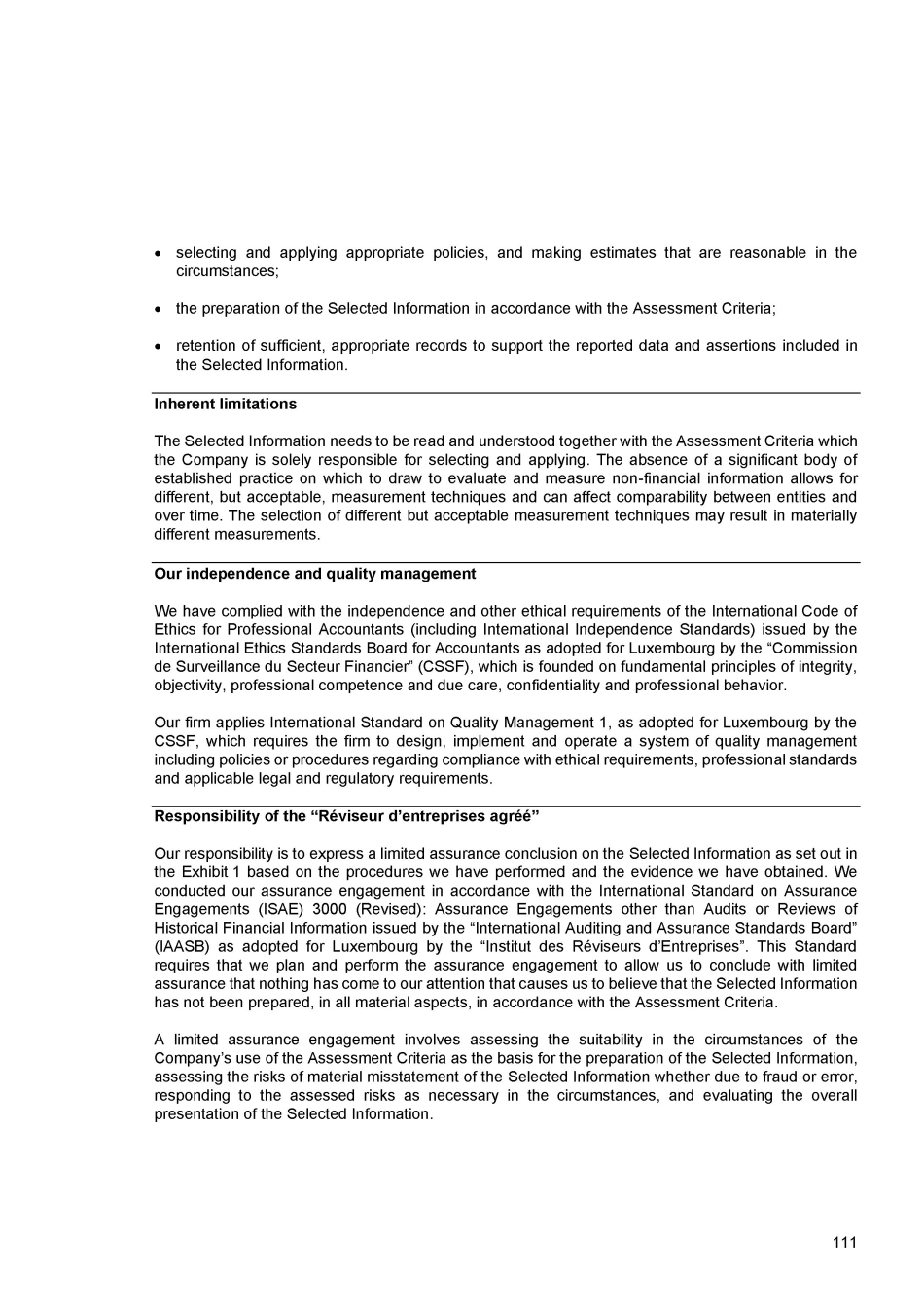
111 selecting and applying appropriate policies, and making estimates that are reasonable in the circumstances; the preparation of the Selected Information in accordance with the Assessment Criteria; retention of sufficient, appropriate records to support the reported data and assertions included in the Selected Information. Inherent limitations The Selected Information needs to be read and understood together with the Assessment Criteria which the Company is solely responsible for selecting and applying . The absence of a significant body of established practice on which to draw to evaluate and measure non - financial information allows for different, but acceptable, measurement techniques and can affect comparability between entities and over time . The selection of different but acceptable measurement techniques may result in materially different measurements . Our independence and quality management We have complied with the independence and other ethical requirements of the International Code of Ethics for Professional Accountants (including International Independence Standards) issued by the International Ethics Standards Board for Accountants as adopted for Luxembourg by the “Commission de Surveillance du Secteur Financier” (CSSF), which is founded on fundamental principles of integrity, objectivity, professional competence and due care, confidentiality and professional behavior . Our firm applies International Standard on Quality Management 1 , as adopted for Luxembourg by the CSSF, which requires the firm to design, implement and operate a system of quality management including policies or procedures regarding compliance with ethical requirements, professional standards and applicable legal and regulatory requirements . Responsibility of the “Réviseur d’entreprises agréé” Our responsibility is to express a limited assurance conclusion on the Selected Information as set out in the Exhibit 1 based on the procedures we have performed and the evidence we have obtained . We conducted our assurance engagement in accordance with the International Standard on Assurance Engagements (ISAE) 3000 (Revised) : Assurance Engagements other than Audits or Reviews of Historical Financial Information issued by the “International Auditing and Assurance Standards Board” (IAASB) as adopted for Luxembourg by the “Institut des Réviseurs d’Entreprises” . This Standard requires that we plan and perform the assurance engagement to allow us to conclude with limited assurance that nothing has come to our attention that causes us to believe that the Selected Information has not been prepared, in all material aspects, in accordance with the Assessment Criteria . A limited assurance engagement involves assessing the suitability in the circumstances of the Company’s use of the Assessment Criteria as the basis for the preparation of the Selected Information, assessing the risks of material misstatement of the Selected Information whether due to fraud or error, responding to the assessed risks as necessary in the circumstances, and evaluating the overall presentation of the Selected Information .

112 In a limited assurance engagement, the procedures vary in nature and timing and are less in extent than for a reasonable assurance engagement . As a result, the level of assurance obtained in a limited assurance engagement is substantially lower than the assurance that would have been obtained had we performed a reasonable assurance engagement . Within the scope of our engagement we did not perform an audit or a review on external sources of information or expert opinions, referred to in the Sustainability Report . Within the scope of our limited assurance engagement, we performed, amongst others, the following procedures : we gained an understanding of the Selected Information and related disclosures; we gained an understanding of the Assessment Criteria and their suitability for the evaluation and/or measurements of the Selected Information ; we gained an understanding of the internal control procedures in place supporting the gathering, aggregation, processing, transmittal of data and information and reporting of the Selected Information, including controls over third party information (if applicable) and performing walkthroughs to confirm our understanding ; based on that understanding, we assessed the risks that the Selected Information may be materially misstated and determination of the nature, timing and extent of further procedures ; we inquired relevant Company management, personnel and third parties; we performed analytical procedures related to the Selected Information; we considered the significant estimates and judgements made by management in the preparation of the Selected Information ; we performed limited testing, on a selective basis of evidence supporting the reported Selected Information and assessed the related disclosures . Limited Assurance Conclusion Based on the procedures we have performed and evidence we have obtained, nothing has come to our attention that causes us to believe that the Company’s Selected Information for the period from 1 January 2023 to 31 December 2023 has not been prepared, in all material aspects, in accordance with the Assessment Criteria .

113 Restriction on Use and Distribution of our Report This report, including the opinion, has been prepared for and only for the Board of Directors of Tenaris in accordance with the terms of our engagement letter and is not suitable for any other purpose . We do not accept any responsibility to any other party to whom it may be distributed . PricewaterhouseCoopers, Société coopérative Represented by Luxembourg, 22 March 2024 Gilles Vanderweyen Réviseur d’entreprises agréé Encl.: Exhibit 1 - The “Selected Information”
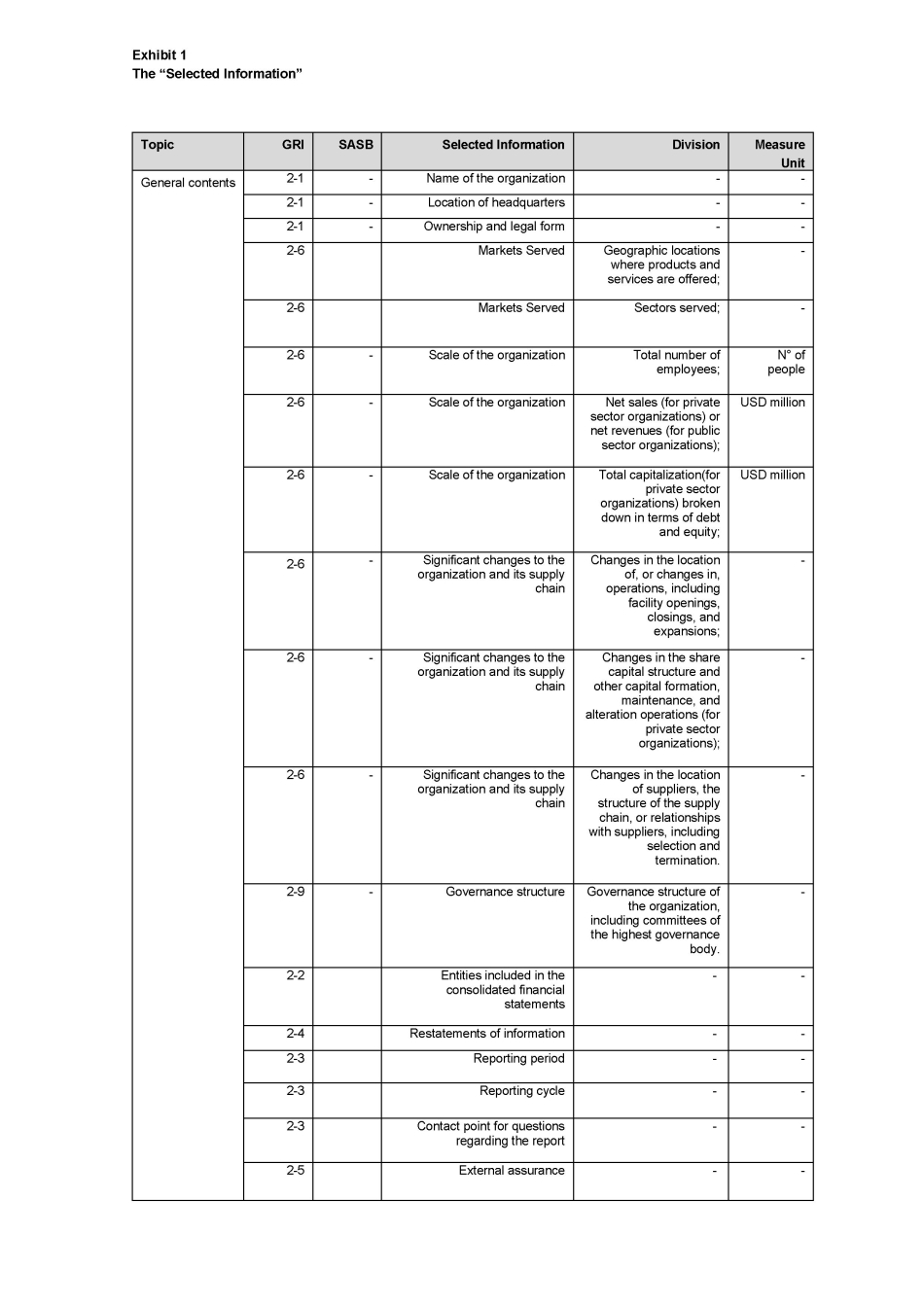
Exhibit 1 The “Selected Information” Measure Unit Division Selected Information SASB GRI Topic - - Name of the organization - 2 - 1 General contents - - Location of headquarters - 2 - 1 - - Ownership and legal form - 2 - 1 - Geographic locations Markets Served 2 - 6 where products and services are offered; - Sectors served; Markets Served 2 - 6 N ƒ of Total number of Scale of the organization - 2 - 6 people employees; USD million Net sales (for private Scale of the organization - 2 - 6 sector organizations) or net revenues (for public sector organizations); USD million Total capitalization(for Scale of the organization - 2 - 6 private sector organizations) broken down in terms of debt and equity; - Changes in the location of, or changes in, Significant changes to the organization and its supply - 2 - 6 operations, including chain facility openings, closings, and expansions; - Changes in the share Significant changes to the - 2 - 6 capital structure and organization and its supply other capital formation, chain maintenance, and alteration operations (for private sector organizations); - Changes in the location Significant changes to the - 2 - 6 of suppliers, the organization and its supply structure of the supply chain chain, or relationships with suppliers, including selection and termination. - Governance structure of Governance structure - 2 - 9 the organization, including committees of the highest governance body. - - Entities included in the 2 - 2 consolidated financial statements - - Restatements of information 2 - 4 - - Reporting period 2 - 3 - - Reporting cycle 2 - 3 - - Contact point for questions 2 - 3 regarding the report - - External assurance 2 - 5
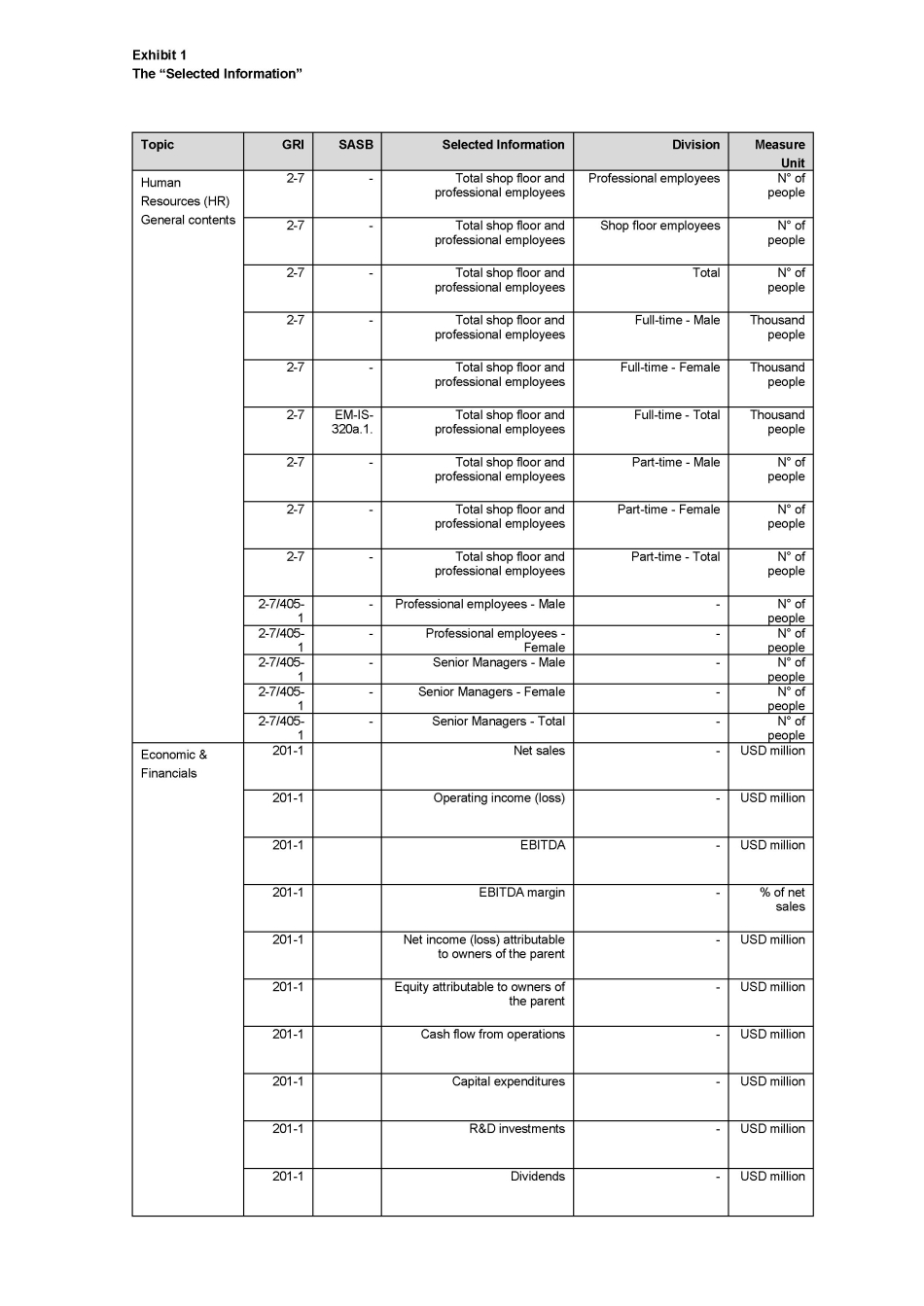
Exhibit 1 The “Selected Information” Measure Unit Division Selected Information SASB GRI Topic N ƒ of people Professional employees Total shop floor and professional employees - 2 - 7 Human Resources (HR) General contents N ƒ of people Shop floor employees Total shop floor and professional employees - 2 - 7 N ƒ of people Total Total shop floor and professional employees - 2 - 7 Thousand people Full - time - Male Total shop floor and professional employees - 2 - 7 Thousand people Full - time - Female Total shop floor and professional employees - 2 - 7 Thousand people Full - time - Total Total shop floor and professional employees EM - IS - 320a.1. 2 - 7 N ƒ of people Part - time - Male Total shop floor and professional employees - 2 - 7 N ƒ of people Part - time - Female Total shop floor and professional employees - 2 - 7 N ƒ of people Part - time - Total Total shop floor and professional employees - 2 - 7 N ƒ of people - Professional employees - Male - 2 - 7/405 - 1 N ƒ of people - Professional employees - Female - 2 - 7/405 - 1 N ƒ of people - Senior Managers - Male - 2 - 7/405 - 1 N ƒ of people - Senior Managers - Female - 2 - 7/405 - 1 N ƒ of people - Senior Managers - Total - 2 - 7/405 - 1 USD million - Net sales 201 - 1 Economic & Financials USD million - Operating income (loss) 201 - 1 USD million - EBITDA 201 - 1 % of net sales - EBITDA margin 201 - 1 USD million - Net income (loss) attributable to owners of the parent 201 - 1 USD million - Equity attributable to owners of the parent 201 - 1 USD million - Cash flow from operations 201 - 1 USD million - Capital expenditures 201 - 1 USD million - R&D investments 201 - 1 USD million - Dividends 201 - 1

Exhibit 1 The “Selected Information” Measure Unit Division Selected Information SASB GRI Topic USD million - Net financial position 201 - 1 % - Return on equity 201 - 1 % - Return on capital employed 201 - 1 % of net sales - FCF Margin 201 - 1 USD billion - Economic value generated 201 - 1 USD billion - Economic value distributed in suppliers 201 - 1 USD million - Economic value distributed in community investments 201 - 1 USD million - Economic value distributed in research and development 201 - 1 USD million - Economic value distributed in capital providers 201 - 1 USD million - Economic value distributed in taxes 201 - 1 USD million - Economic value distributed in capex 201 - 1 USD billion - Economic value distributed in employees 201 - 1 USD million - Defined benefit plan obligations and other retirement plans - 201 - 3 Tera Joules (TJ) - Total fuel consumption within the organization - Non - renewable sources EM - IS - 130a.2. 302 - 1 Environment % - Fuel consumption - Coal EM - IS - 130a.2. - % - Fuel consumption - Natural Gas EM - IS - 130a.2. - % - Fuel consumption - Other (Diesel) EM - IS - 130a.2. - Tera Joules (TJ) - Total sold by type of energy use - 302 - 1 Tera Joules (TJ) - Total energy consumption EM - IS - 130a.1. 302 - 1 GWh Total electricity consumption EM - IS - 130a.1. 302 - 1 % - Electricity consumption - Supplied from grid electricity. EM - IS - 130a.1. - GWh Electricity consumption - Renewable EM - IS - 130a.1. - % Electricity consumption - Renewable EM - IS - 130a.1. - Million m3 - Water withdrawal EM - IS - 140a.1 303 - 3 % - Average water intake - Surface water - 303 - 3 % - Average water intake - Subsurface water - 303 - 3 % - Average water intake - Network water - 303 - 3
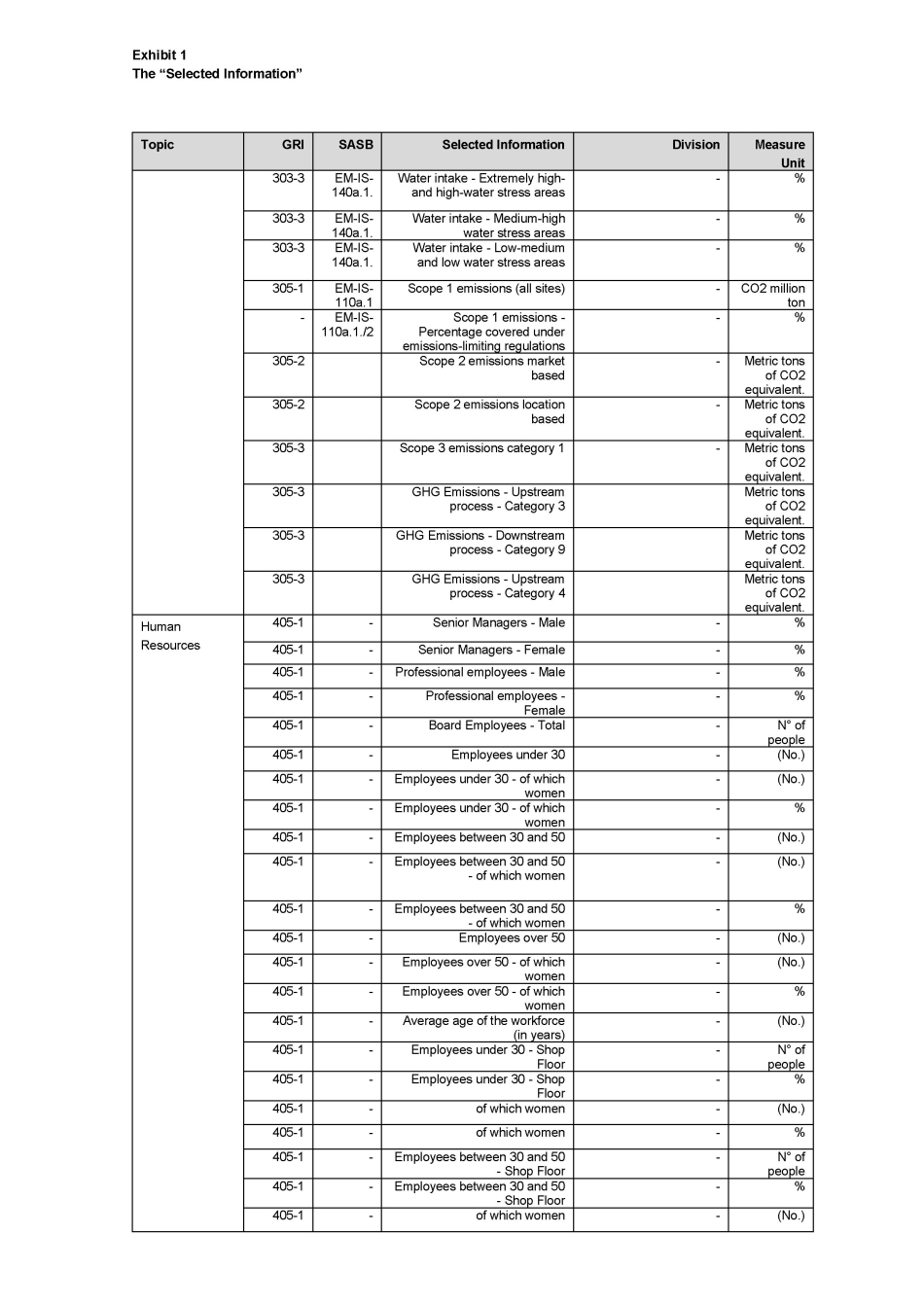
Exhibit 1 The “Selected Information” Measure Unit Division Selected Information SASB GRI Topic % - Water intake - Extremely high - and high - water stress areas EM - IS - 140a.1. 303 - 3 % - Water intake - Medium - high water stress areas EM - IS - 140a.1. 303 - 3 % - Water intake - Low - medium and low water stress areas EM - IS - 140a.1. 303 - 3 CO2 million ton - Scope 1 emissions (all sites) EM - IS - 110a.1 305 - 1 % - Scope 1 emissions - Percentage covered under emissions - limiting regulations EM - IS - 110a.1./2 - Metric tons of CO2 equivalent. - Scope 2 emissions market based 305 - 2 Metric tons of CO2 equivalent. - Scope 2 emissions location based 305 - 2 Metric tons of CO2 equivalent. - Scope 3 emissions category 1 305 - 3 Metric tons of CO2 equivalent. GHG Emissions - Upstream process - Category 3 305 - 3 Metric tons of CO2 equivalent. GHG Emissions - Downstream process - Category 9 305 - 3 Metric tons of CO2 equivalent. GHG Emissions - Upstream process - Category 4 305 - 3 % - Senior Managers - Male - 405 - 1 Human Resources % - Senior Managers - Female - 405 - 1 % - Professional employees - Male - 405 - 1 % - Professional employees - Female - 405 - 1 N ƒ of people - Board Employees - Total - 405 - 1 (No.) - Employees under 30 - 405 - 1 (No.) - Employees under 30 - of which women - 405 - 1 % - Employees under 30 - of which women - 405 - 1 (No.) - Employees between 30 and 50 - 405 - 1 (No.) - Employees between 30 and 50 - of which women - 405 - 1 % - Employees between 30 and 50 - of which women - 405 - 1 (No.) - Employees over 50 - 405 - 1 (No.) - Employees over 50 - of which women - 405 - 1 % - Employees over 50 - of which women - 405 - 1 (No.) - Average age of the workforce (in years) - 405 - 1 N ƒ of people - Employees under 30 - Shop Floor - 405 - 1 % - Employees under 30 - Shop Floor - 405 - 1 (No.) - of which women - 405 - 1 % - of which women - 405 - 1 N ƒ of people - Employees between 30 and 50 - Shop Floor - 405 - 1 % - Employees between 30 and 50 - Shop Floor - 405 - 1 (No.) - of which women - 405 - 1

Exhibit 1 The “Selected Information” Measure Unit Division Selected Information SASB GRI Topic % - of which women - 405 - 1 N ƒ of people - Employees over 50 - Shop Floor - 405 - 1 % - Employees over 50 - Shop Floor - 405 - 1 (No.) - of which women - 405 - 1 % - of which women - 405 - 1 (No.) - Professionals under 30 - 405 - 1 % - Professionals under 30 - 405 - 1 (No.) - of which women - 405 - 1 % - of which women - 405 - 1 (No.) - Professionals between 30 and 50 - 405 - 1 % - Professionals between 30 and 50 - 405 - 1 (No.) - of which women - 405 - 1 % - of which women - 405 - 1 (No.) - Professionals over 50 - 405 - 1 % - Professionals over 50 - 405 - 1 (No.) - of which women - 405 - 1 % - of which women - 405 - 1 (No.) - Senior Managers under 30 - 405 - 1 (No.) - of which women - 405 - 1 (No.) - Senior Managers between 30 and 50 - 405 - 1 (No.) - of which women - 405 - 1 (No.) - Senior Managers over 50 - 405 - 1 (No.) - of which women - 405 - 1 People - Mexican - 405 - 1 % - Mexican - 405 - 1 People - Argentine - 405 - 1 % - Argentine - 405 - 1 People - Italian - 405 - 1 % - Italian - 405 - 1 People - Rumanian - 405 - 1 % - Rumanian - 405 - 1 People - American - 405 - 1 % - American - 405 - 1 People - Brazilian - 405 - 1 % - Brazilian - 405 - 1 People - Colombian - 405 - 1 % - Colombian - 405 - 1 People - Canadian - 405 - 1 % - Canadian - 405 - 1 People - Indonesian - 405 - 1 % - Indonesian - 405 - 1 People - Others - 405 - 1 % - Others - 405 - 1
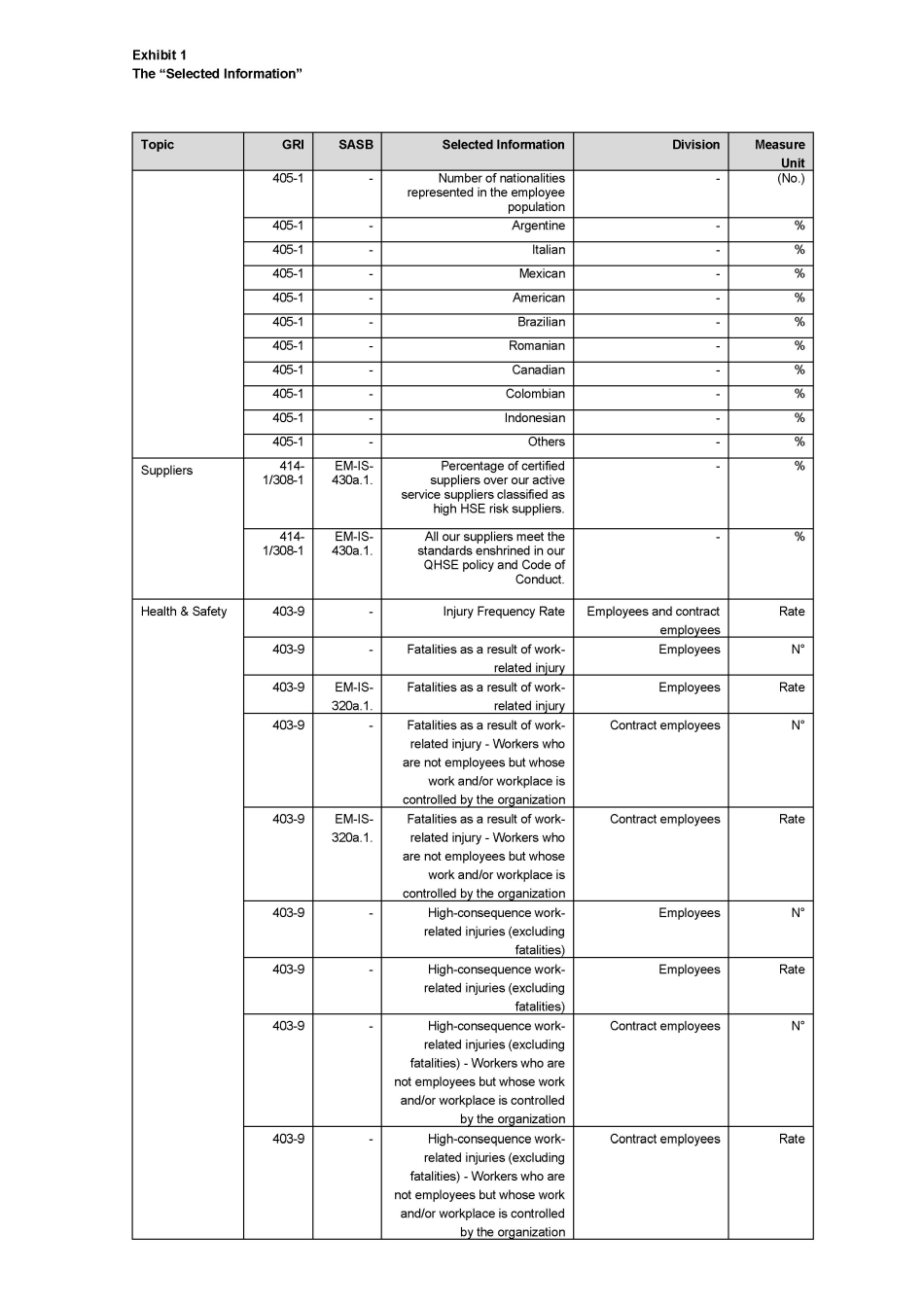
Exhibit 1 The “Selected Information” Measure Unit Division Selected Information SASB GRI Topic (No.) - Number of nationalities represented in the employee population - 405 - 1 % - Argentine - 405 - 1 % - Italian - 405 - 1 % - Mexican - 405 - 1 % - American - 405 - 1 % - Brazilian - 405 - 1 % - Romanian - 405 - 1 % - Canadian - 405 - 1 % - Colombian - 405 - 1 % - Indonesian - 405 - 1 % - Others - 405 - 1 % - Percentage of certified suppliers over our active service suppliers classified as high HSE risk suppliers. EM - IS - 430a.1. 414 - 1/308 - 1 Suppliers % - All our suppliers meet the standards enshrined in our QHSE policy and Code of Conduct. EM - IS - 430a.1. 414 - 1/308 - 1 Rate Employees and contract employees Injury Frequency Rate - 403 - 9 Health & Safety N ƒ Employees Fatalities as a result of work - related injury - 403 - 9 Rate Employees Fatalities as a result of work - related injury EM - IS - 320a.1. 403 - 9 N ƒ Contract employees Fatalities as a result of work - related injury - Workers who are not employees but whose work and/or workplace is controlled by the organization - 403 - 9 Rate Contract employees Fatalities as a result of work - related injury - Workers who are not employees but whose work and/or workplace is controlled by the organization EM - IS - 320a.1. 403 - 9 N ƒ Employees High - consequence work - related injuries (excluding fatalities) - 403 - 9 Rate Employees High - consequence work - related injuries (excluding fatalities) - 403 - 9 N ƒ Contract employees High - consequence work - related injuries (excluding fatalities) - Workers who are not employees but whose work and/or workplace is controlled by the organization - 403 - 9 Rate Contract employees High - consequence work - related injuries (excluding fatalities) - Workers who are not employees but whose work and/or workplace is controlled by the organization - 403 - 9
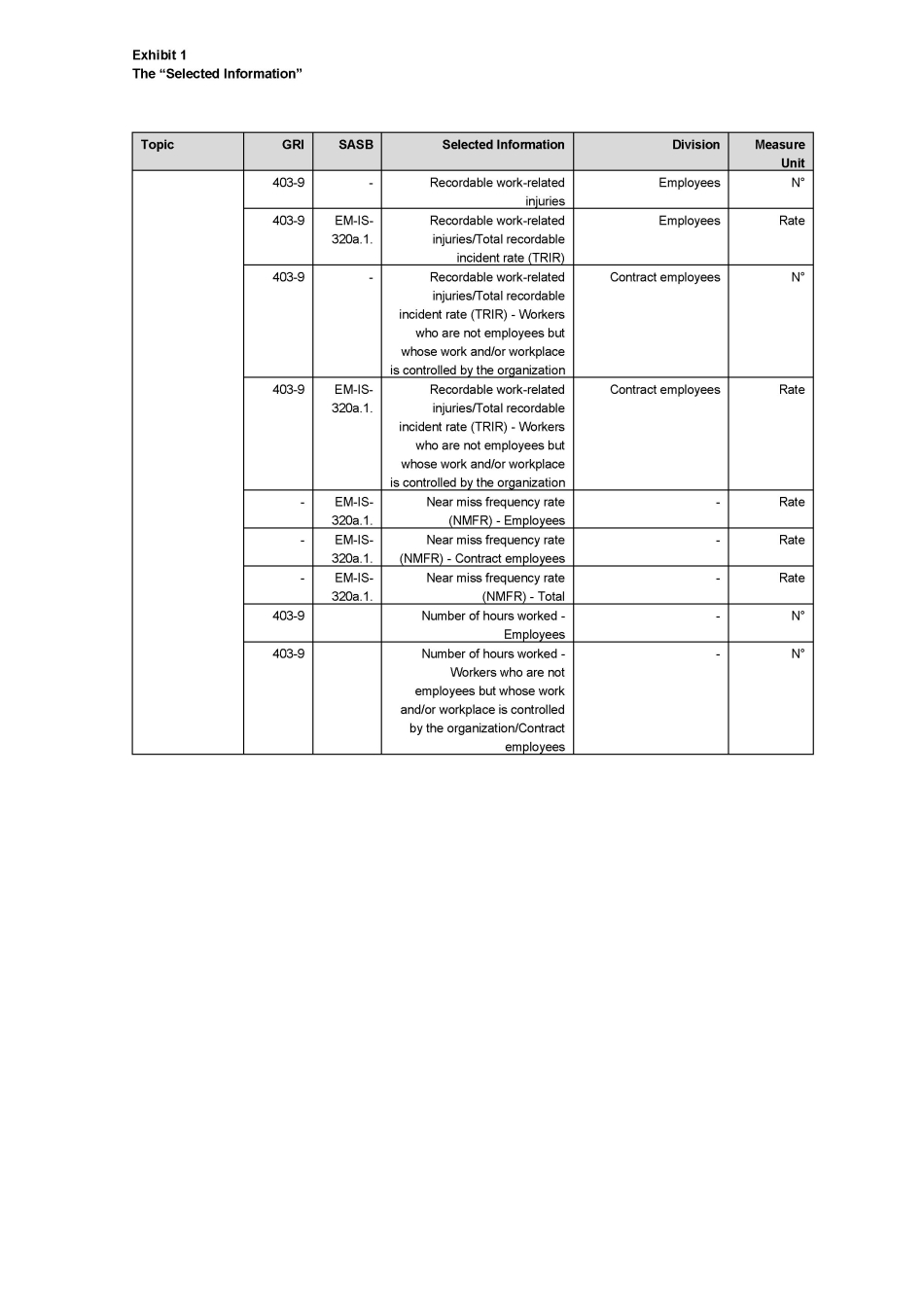
Exhibit 1 The “Selected Information” Measure Unit Division Selected Information SASB GRI Topic N ƒ Employees Recordable work - related injuries - 403 - 9 Rate Employees Recordable work - related injuries/Total recordable incident rate (TRIR) EM - IS - 320a.1. 403 - 9 N ƒ Contract employees Recordable work - related injuries/Total recordable incident rate (TRIR) - Workers who are not employees but whose work and/or workplace is controlled by the organization - 403 - 9 Rate Contract employees Recordable work - related injuries/Total recordable incident rate (TRIR) - Workers who are not employees but whose work and/or workplace is controlled by the organization EM - IS - 320a.1. 403 - 9 Rate - Near miss frequency rate (NMFR) - Employees EM - IS - 320a.1. - Rate - Near miss frequency rate (NMFR) - Contract employees EM - IS - 320a.1. - Rate - Near miss frequency rate (NMFR) - Total EM - IS - 320a.1. - N ƒ - Number of hours worked - Employees 403 - 9 N ƒ - Number of hours worked - Workers who are not employees but whose work and/or workplace is controlled by the organization/Contract employees 403 - 9
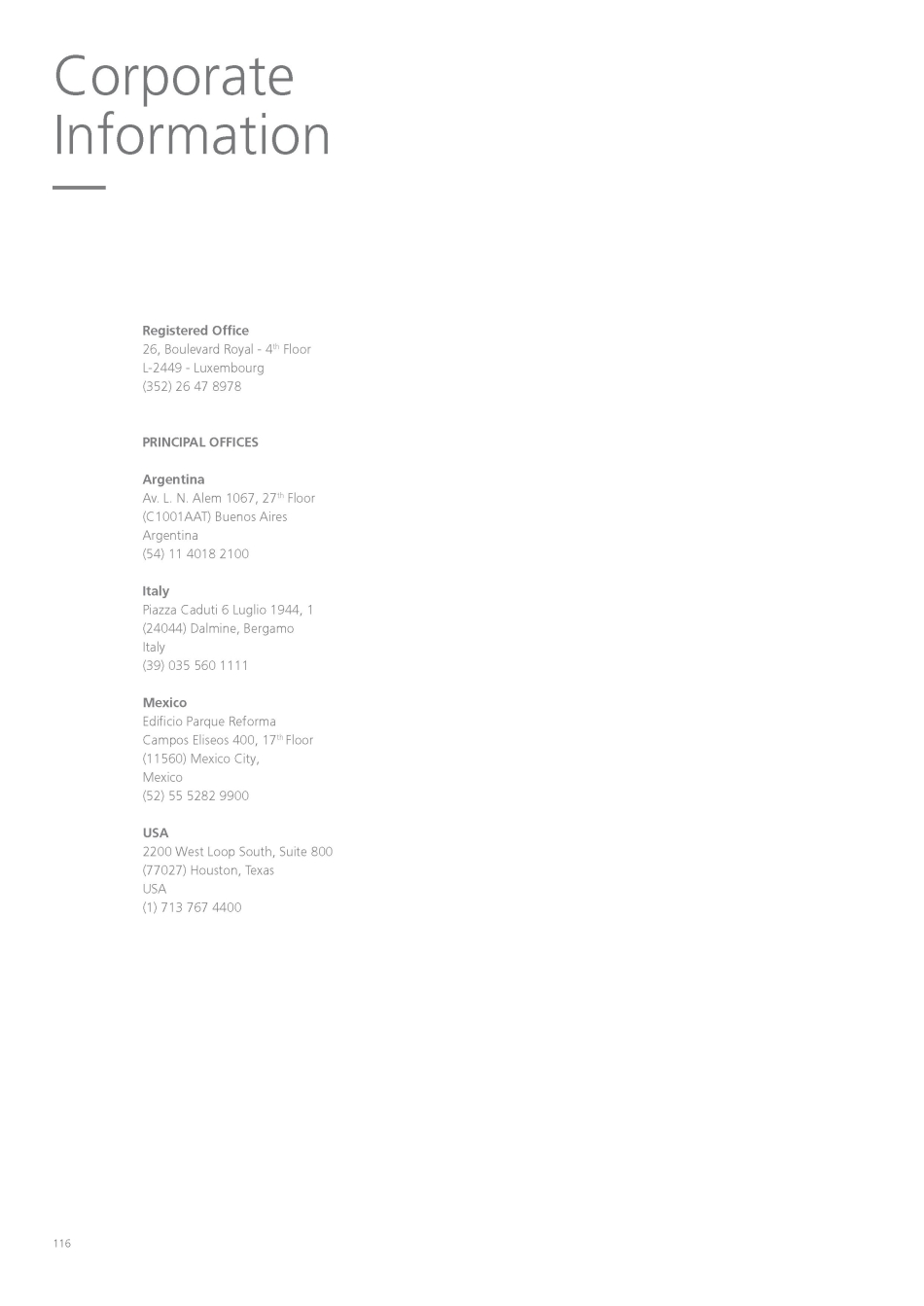
116 Registered Office 26, Boulevard Royal - 4 th Floor L - 2449 - Luxembourg (352) 26 47 8978 PRINCIPAL OFFICES Argentina Av. L. N. Alem 1067, 27 th Floor (C1001AAT) Buenos Aires Argentina (54) 11 4018 2100 Italy Piazza Caduti 6 Luglio 1944, 1 (24044) Dalmine, Bergamo Italy (39) 035 560 1111 Mexico Edificio Parque Reforma Campos Eliseos 400, 17 th Floor (11560) Mexico City, Mexico (52) 55 5282 9900 USA 2200 West Loop South, Suite 800 (77027) Houston, Texas USA (1) 713 767 4400 Corporate Information


118 ©Tenaris March 2024. All rights reserved. www.tenaris.com